TomTom 4GE40 TomTom GPS Navigation System User Manual TomTom Rider
TomTom International BV TomTom GPS Navigation System TomTom Rider
TomTom >
User manual

TomTom Rider
Reference Guide

2
Contents
Welcome to navigation with TomTom 6
Get going 7
Installing in your car .............................................................................................. 7
Positioning the device ............................................................................................ 7
Switching on and off .............................................................................................. 7
Safety Notice ....................................................................................................... 8
Setting up ........................................................................................................... 8
GPS reception ...................................................................................................... 8
Sending information to TomTom ................................................................................ 8
Memory card slot .................................................................................................. 9
Device not starting ................................................................................................ 9
Charging your device .............................................................................................. 9
Caring for your Rider .............................................................................................. 9
Connecting to TomTom services 10
About TomTom services ........................................................................................ 10
Always connected devices ...................................................................................... 10
Smartphone connected devices ............................................................................... 10
Personal Area Networks .................................................................................... 11
Connect to TomTom services using your smartphone ................................................. 11
Reconnecting your smartphone ........................................................................... 12
Connect to TomTom services using a different smartphone ......................................... 12
Deleting phones .............................................................................................. 12
Unable to get a connection ................................................................................ 13
What's on the screen 14
The map view..................................................................................................... 14
The guidance view ............................................................................................... 15
The route bar ..................................................................................................... 17
Distances and the route bar ............................................................................... 18
The quick menu .................................................................................................. 18
Navigation buttons............................................................................................... 18
Other buttons ..................................................................................................... 20
Volume control ................................................................................................... 21
Using gestures .................................................................................................... 21
Looking at trip statistics ........................................................................................ 22
Using quick settings ............................................................................................. 24
Traffic 25
About TomTom Traffic .......................................................................................... 25
About RDS-TMC ................................................................................................... 25
The route bar ..................................................................................................... 25
Looking at traffic on the map ................................................................................. 26
Looking at traffic on your route ............................................................................... 27
Traffic incidents ................................................................................................. 28
Advanced Lane Guidance ....................................................................................... 29
Time-dependent speed limits ................................................................................. 29

3
Using Quick Search 31
About search ...................................................................................................... 31
Planning a route to a POI using search ....................................................................... 31
Planning a route to a POI using online search .............................................................. 33
Entering search terms ........................................................................................... 35
Working with search results ................................................................................... 37
About postcodes ................................................................................................. 38
About mapcodes ................................................................................................. 38
List of POI type icons ............................................................................................ 39
Planning a route 43
Planning a route to an address using search ................................................................ 43
Planning a route to a city centre ............................................................................. 45
Planning a route to a POI using search ....................................................................... 46
Planning a route to a POI using online search .............................................................. 48
Planning a route using the map ............................................................................... 50
Planning a route using My Places ............................................................................. 51
Planning a route using coordinates ........................................................................... 53
Planning a route using a mapcode ............................................................................ 54
Finding an alternative route ................................................................................... 55
Planning a route in advance ................................................................................... 55
Finding a car park ............................................................................................... 57
Finding a petrol station ......................................................................................... 59
Changing your route 62
The Current Route Menu ....................................................................................... 62
Avoiding a blocked road ........................................................................................ 63
Types of route .................................................................................................... 64
Route features ................................................................................................... 64
Adding a stop to your route from the current route menu ............................................... 64
Adding a stop to your route using the map ................................................................. 65
Deleting a stop from your route ............................................................................... 65
Reordering stops on a route ................................................................................... 65
My Routes 66
About My Routes ................................................................................................. 66
Saving a route .................................................................................................... 66
Navigating using a saved route ................................................................................ 67
Adding a stop to a saved route using the map .............................................................. 67
Deleting a route from My Routes .............................................................................. 68
My Places 69
About My Places .................................................................................................. 69
Setting your home location .................................................................................... 69
Changing your home location .................................................................................. 70
Adding a location from My Places ............................................................................. 71
Add a location to My Places from the map .................................................................. 71
Adding a location to My Places using search ................................................................ 71
Adding a location to My Places by marking ................................................................. 72
Deleting a recent destination from My Places .............................................................. 72
Deleting a location from My Places ........................................................................... 72
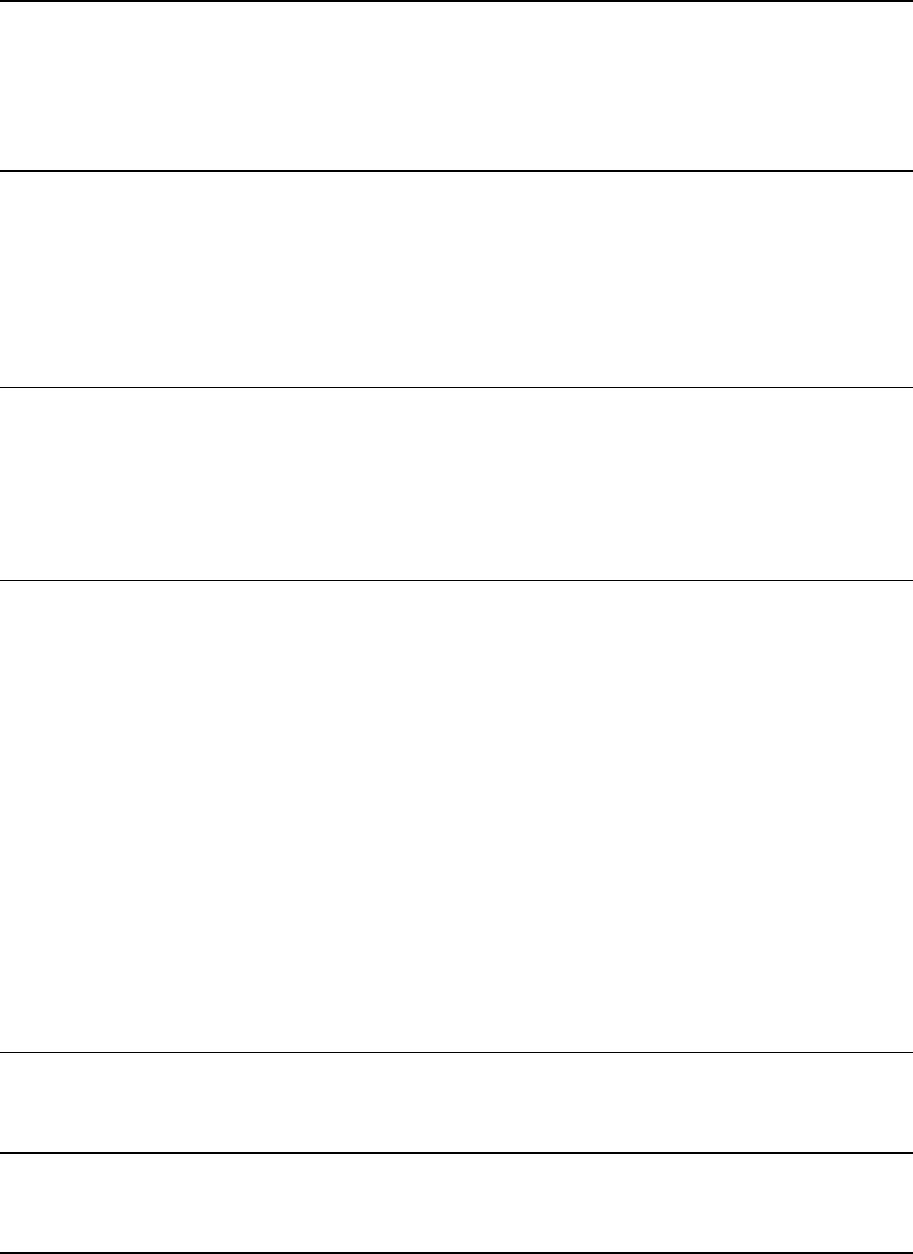
4
Map Share 73
About Map Share ................................................................................................. 73
Creating a map correction report ............................................................................. 73
Creating a map correction report from a marked location ............................................... 74
Types of map correction ........................................................................................ 75
Speed Cameras 77
About speed cameras ........................................................................................... 77
Speed camera warnings ......................................................................................... 77
Changing the way you are warned ............................................................................ 79
Reporting a new speed camera ............................................................................... 79
Confirm or remove a mobile speed camera ................................................................. 80
Updating locations for cameras and hazards ............................................................... 80
Danger Zones 81
About danger zones and risk zones ........................................................................... 81
Danger zone and risk zone warnings ......................................................................... 81
Changing the way you are warned ............................................................................ 82
Reporting a risk zone ............................................................................................ 82
Updating locations for danger zones and risk zones ....................................................... 83
Settings 84
Appearance ....................................................................................................... 84
Display ......................................................................................................... 84
Route Bar ...................................................................................................... 85
Guidance view ................................................................................................ 87
Automatic Zoom.............................................................................................. 87
Voices .............................................................................................................. 87
Maps ................................................................................................................ 88
Route Planning ................................................................................................... 88
Sounds and Warnings ............................................................................................ 89
Warning type ................................................................................................. 89
Speed camera warnings ..................................................................................... 89
Safety warnings .............................................................................................. 90
Screen touch sounds ......................................................................................... 90
Read aloud traffic warnings ................................................................................ 90
Language and Units .............................................................................................. 91
System ............................................................................................................. 91
Help ................................................................................................................ 92
Getting Help 93
Help ................................................................................................................ 93
Product certification 94
Finding product certification information on your device ................................................ 94
MyDrive 95
About MyDrive .................................................................................................... 95
About MyDrive Connect ......................................................................................... 95
MyTomTom account ............................................................................................. 95
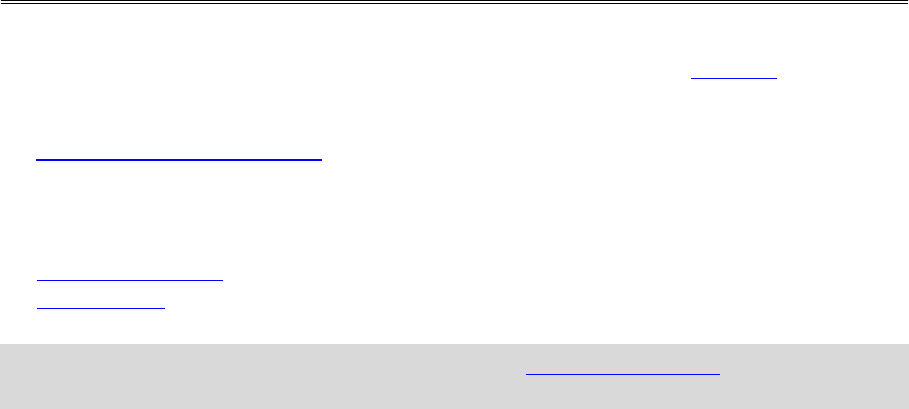
6
This Reference Guide explains all you need to know about your new TomTom Rider.
If you want a quick read of the essentials, we recommend that you read the Get going chapter. This
covers installation, switching on, setting up and planning your first route.
After that, you will probably want to connect to TomTom services and you can read all about that in
the Connecting to TomTom services chapter. To help you avoid traffic delays and get to your
destination quicker, you can use TomTom services even on the routes you drive every day.
For information about what you see on the screen, go to:
New in this release
What's on the screen
Using gestures
Main menu
Tip: There are also frequently asked questions (FAQs) at tomtom.com/support. Select your
product model from the list or enter a search term.
We hope you enjoy reading about and, most importantly, using your new Rider!
Welcome to navigation with TomTom
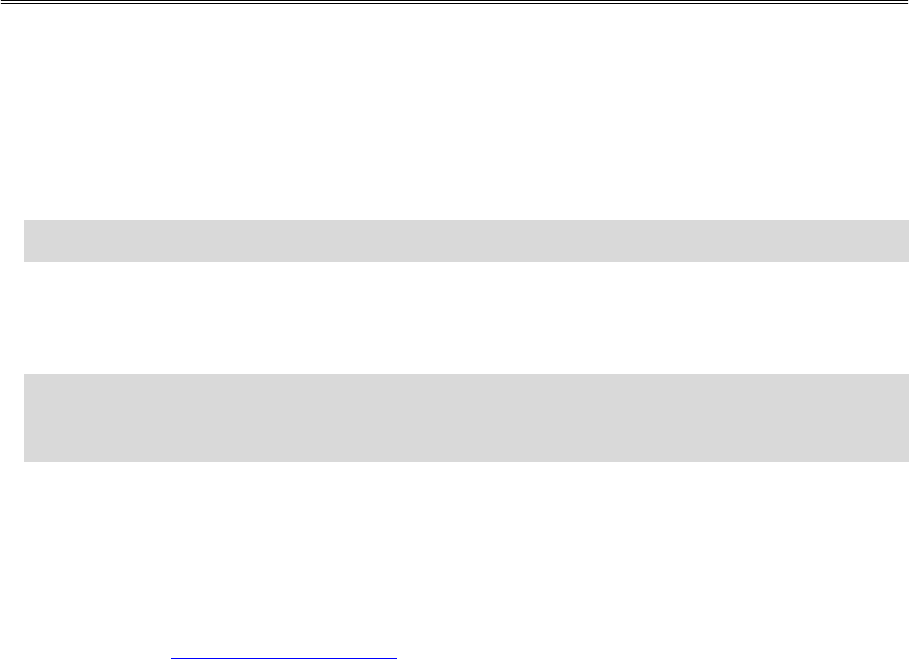
7
Installing in your car
Use the supplied mount to install your TomTom Rider in your vehicle. Read the instructions about
positioning your device before you install your Rider.
To install your Rider, do the following:
1. Connect the supplied USB cable to the mount. If the mount is integrated into your Rider,
connect the USB cable to the device.
Note: Use ONLY the USB cable supplied with your Rider. Other USB cables may not work.
2. Connect the USB cable to the USB car charger and plug this into the power supply on your
dashboard.
3. Choose the best smooth location, on your windscreen or side window, to mount your TomTom
Rider.
Tip: If the mount is integrated into your Rider, you can easily change the rotation of your
device. Push the button on the back of the device to release the mount, then slide the mount
out. Insert it back into the other side of the device.
4. Make sure that both the suction cup on the mount and your windscreen are clean and dry.
5. Press the suction cup of the mount firmly against your windscreen.
6. Turn the rubber grip near the base of the mount in a clockwise direction until you feel it lock.
7. If your mount is not integrated into your Rider, place your Rider in the mount, making sure that
it clicks into place.
Dashboard mount disks are available as part of a range of accessories for your Rider. For more
information, go to tomtom.com/accessories.
Positioning the device
Be careful where you install your Rider in your car. The Rider shouldn't block or interfere with any
of the following:
Your view of the road.
The controls in your car.
Your rear-view mirrors.
The airbags.
You should be able to reach your Rider easily without leaning or stretching. You can attach your
Rider to the windscreen or side window or you can use a Dashboard Mount Disk to attach the mount
to your dashboard.
Switching on and off
Switching your device on
Press the On/Off button until your device starts. If the device was off you see the map view. If your
device was sleeping you see the last screen you were looking at.
Sending your device to sleep
To send your navigation device to sleep, press the On/Off button and then release it.
Get going
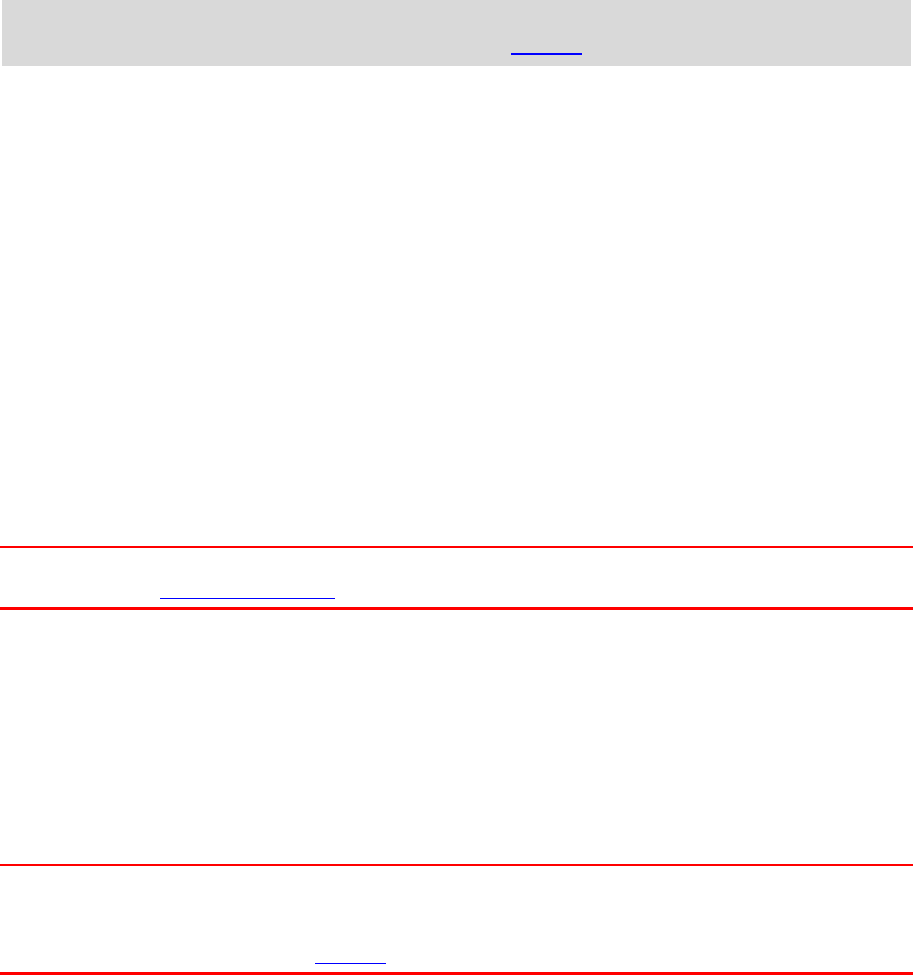
8
You can also press the On/Off button for more than 2 seconds until you see the Sleep and Turn Off
buttons. Select Sleep to make the device sleep.
Tip: To send your navigation device to sleep when the USB cable is unplugged or whenever it is
removed from the mount, go to Battery settings in the Settings menu.
Switching your device off completely
To switch off your navigation device completely, you can do one of the following:
Press and hold the On/Off button for more than 2 seconds until you see the Sleep and Turn Off
buttons. Select Turn Off to switch off the device. Select the "back" button if you don't want to
switch your device off.
Press and hold the On/Off button for more than 5 seconds until the device switches off.
Safety Notice
Some navigation devices contain a GSM/GPRS module which can interfere with electrical devices
such as cardiac pacemakers, hearing aids and aviation equipment.
Interference with these devices may endanger the health or life of you or others.
If your device includes a GSM/GPRS module, do not use it near unprotected electrical units or in
areas where the use of mobile telephones is prohibited, such as hospitals and aircraft.
Setting up
Note: The language you choose will be used for all text on the screen. You can always change the
language later in Language and Units in the Settings menu.
When you first switch on your TomTom Rider, you have to answer a few questions to set it up.
Answer the questions by touching the screen.
GPS reception
When you first start your TomTom Rider, it may need a few minutes to determine your position. In
future, your position will be found much faster.
To ensure good satellite reception, use your Rider outdoors and keep it upright. Large objects such
as tall buildings can sometimes interfere with reception.
Important: QuickGPSfix contains information about satellite positions which helps your Rider find
your position faster. QuickGPSfix information is sent to Always Connected devices in real time and
to Smartphone Connected devices when connected to TomTom services using your smartphone. You
can also update QuickGPSfix using MyDrive.
Sending information to TomTom
When you first start navigating or you have reset your Rider, your Rider asks for permission to
collect some information about your use of the navigation device. The information is stored on your
Rider until we retrieve it. We use it anonymously to improve our products and services. If you use
our services, we will also use your location information to deliver the services to you.
You can change whether you send this information with us at any time by doing the following:
1. In the Main Menu, select the Settings button.
2. Select System.
3. Select Your information.
4. Select the button to turn sending of information on or off.
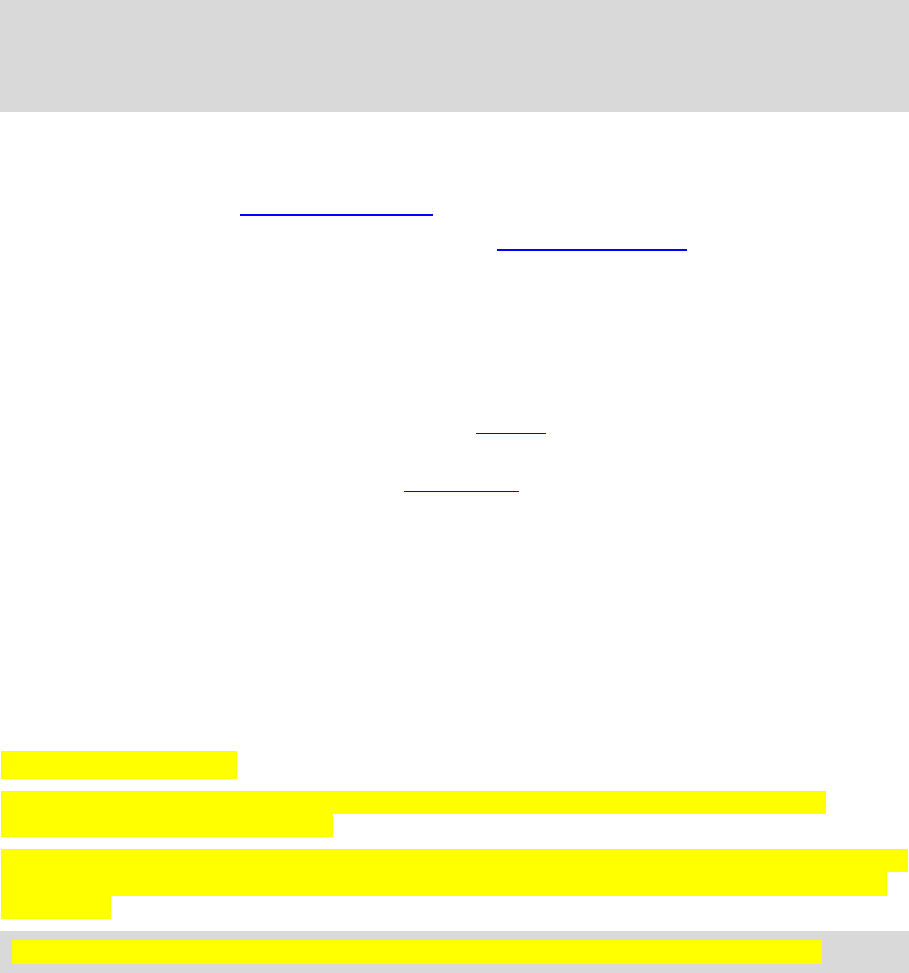
9
Note: If you choose not to send location information to us, you will no longer receive our
services. This is because services need to send the location of your device to TomTom in order to
receive the traffic information related to where you are. The end date of your subscription
remains the same, even if you do not send this information to us.
Additional information
If you think that your information is not being used for the purpose for which you have provided it
to TomTom, contact us at tomtom.com/support.
You can find current and more detailed information at tomtom.com/privacy.
Memory card slot
Some TomTom navigation devices have a memory card slot that is located on the side or bottom of
the device.
Before you use the memory card slot, make sure that you have the latest version of the application
installed on your navigation device by connecting to MyDrive using a computer.
When your Rider is up-to-date, you can use a memory card as extra storage space to add extra maps
to your device. Maps can be purchased from tomtom.com.
Device not starting
In rare cases, your TomTom Rider may not start correctly or may stop responding to your taps.
First, check that the battery is charged. To charge the battery, connect your Rider to the car
charger. It can take up to 3 hours to fully charge the battery.
If this does not solve the problem, you can perform a reset. To do this, press and hold the On/Off
button until your Rider begins to restart.
Charging your device
The battery in your TomTom Rider charges when you connect it to the car charger, to your
computer or to a USB Home Charger.
You are warned when the battery level is low or critical. You lose your connection to some TomTom
services when the battery level is low or critical. When the battery is empty, your Rider goes into
sleep mode.
Note: Use ONLY the USB cable supplied with your Rider. Other USB cables may not work.
Caring for your Rider
It is important to take care of your device:
Do not open the casing of your device under any circumstances. Doing so may be dangerous and
will invalidate the warranty.
Wipe or dry the screen of your device using a soft cloth. Do not use any liquid cleaners.
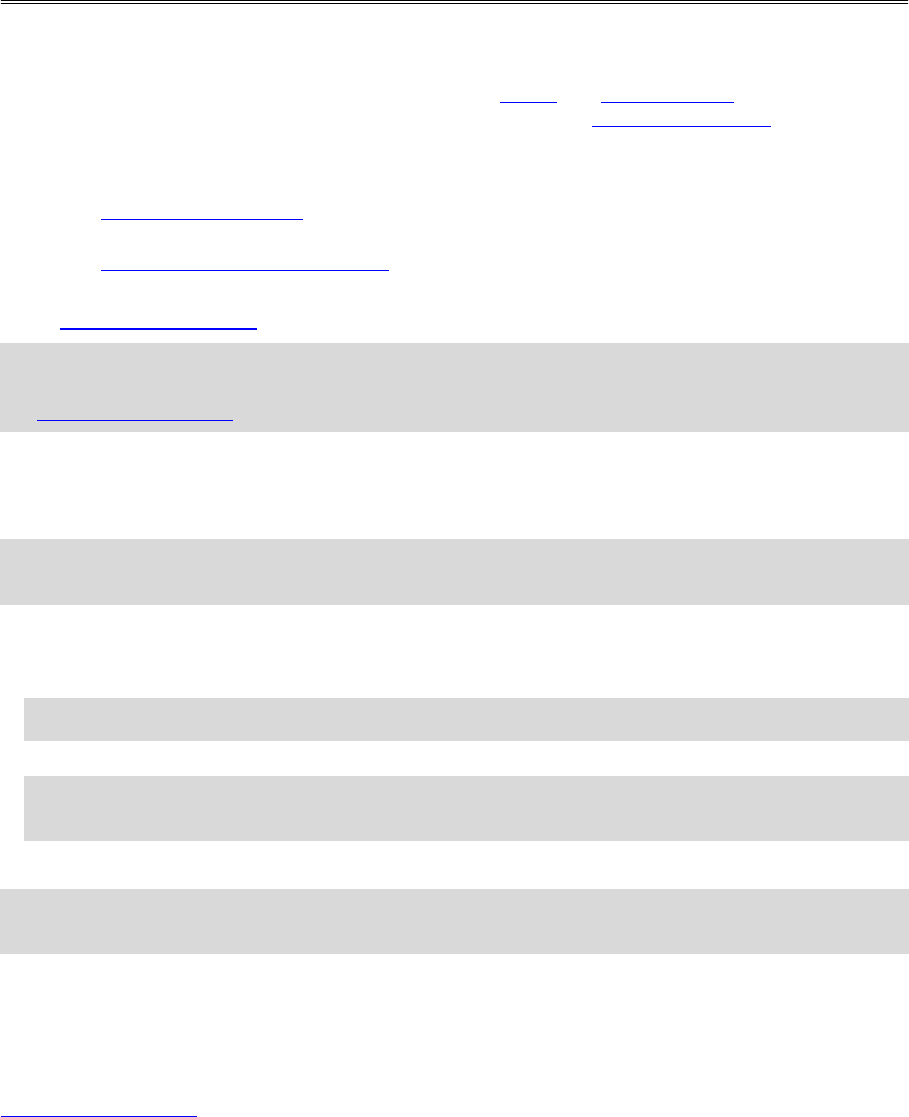
10
About TomTom services
TomTom services give you real-time information about traffic and speed cameras on your route. To
get TomTom services on your Rider you need to be logged in to a MyTomTom account.
The way you connect your Rider to TomTom services depends on your navigation device. A Rider can
connect in one of the following ways:
With a permanent connection directly from your Rider. These navigation devices are called
'Always Connected' devices.
With a connection via your smartphone. These devices are called 'Smartphone Connected'
devices.
Check tomtom.com/connect for more information.
Note: TomTom services are not available in all countries or regions, and not all services are
available in all countries or regions. For more information on available services in each region, go
to tomtom.com/services.
Always connected devices
Follow these steps to get TomTom services on a TomTom Rider that is always connected:
Note: When you start your Rider for the first time, or after a reset, you are given the option to
activate TomTom services when you set up your Rider.
1. Select Activate Traffic in the Main Menu.
2. Select Activate.
3. If you are prompted, select Yes to agree to send information to TomTom.
Note: You cannot use TomTom services unless you agree to send information to TomTom.
4. Create a new MyTomTom account or login to your existing MyTomTom account.
Tip: If you already own a TomTom navigation device, we recommend that you open a new
MyTomTom account for your Rider using a different email address.
TomTom services are now active.
Tip: You can also connect to services by selecting Connected Services in the Main Menu,
followed by Traffic & Speed Cameras or Traffic & Danger Zones.
Smartphone connected devices
Some TomTom navigation devices use your phone to connect to TomTom services so that you can
receive real-time TomTom Traffic and safety warnings. Your phone needs to be compatible with the
navigation device, and you must have a data plan from a mobile services provider. Go to
tomtom.com/connect for more information.
Using TomTom services means that data is sent and received by your phone using your mobile
services provider.
Connecting to TomTom services
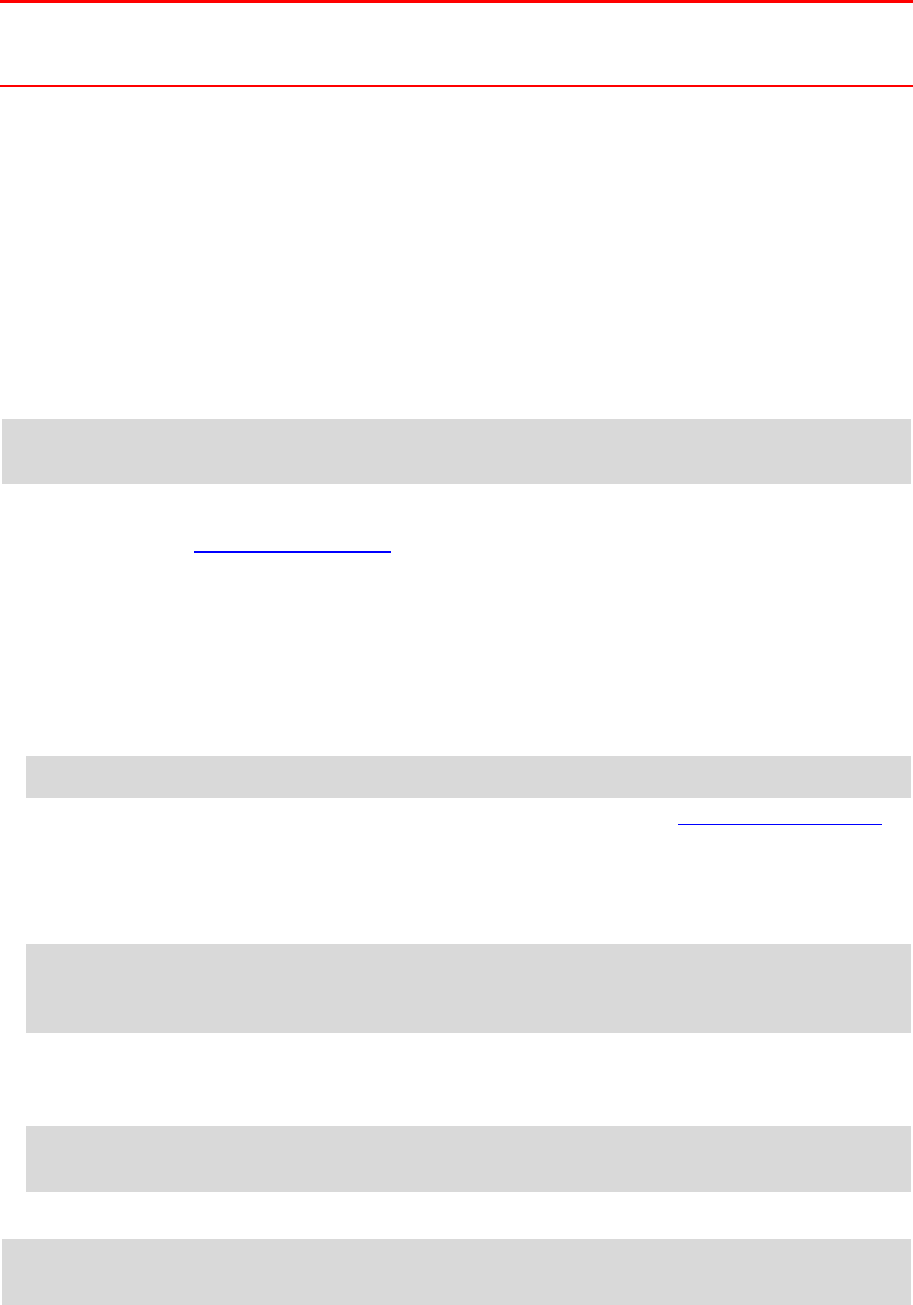
11
Important: You might have additional costs when you use the internet on your phone, especially if
you are outside the area covered by your data plan. Check with your mobile services provider for
more information.
Personal Area Networks
Your phone shares its internet connection by using the phone's Bluetooth and Personal Area Network
(PAN) functions.
Depending on your phone's Operating System, this network, or PAN, might be called one of the
following names:
Personal Hotspot
Tethering or Bluetooth Tethering
Tether or Bluetooth Tether
The PAN function is probably already in your phone's Operating System, or you can download an app
to create a PAN.
Note: Some mobile service providers don't allow their users to use a PAN. If your phone doesn't
have the PAN function, you should contact your service provider for more information.
Please check the user guide for your phone if you are having trouble finding the settings.
For more help, go to tomtom.com/connect.
Connect to TomTom services using your smartphone
To connect your Rider to your phone, do the following:
1. Select Activate Traffic in the Main Menu.
2. Select Activate.
3. If you are prompted, select Yes to agree to send information to TomTom.
Note: You cannot use TomTom services unless you agree to send information to TomTom.
4. Follow the instructions on your navigation device about switching on a Personal Area Network on
your smartphone.
5. Switch on Bluetooth on your phone, and make sure your phone is discoverable.
6. Select the next screen arrow on your navigation device.
Your device searches for your phone.
Tip: If your device cannot find your phone, make sure your phone is still 'discoverable' or
'visible' for other Bluetooth devices. Select Search for Phones from the pop-up menu to search
for your phone again.
7. Select your phone from the list on your navigation device.
Your navigation device connects to TomTom services using your phone's internet connection.
8. Create a new MyTomTom account or log in to your existing MyTomTom account.
Tip: If you already own a TomTom navigation device, we recommend that you open a new
MyTomTom account for your Rider using a different email address.
TomTom services are now active.
Tip: You can also connect to services by selecting Connected Services in the Main Menu,
followed by Traffic & Speed Cameras or Traffic & Danger Zones.
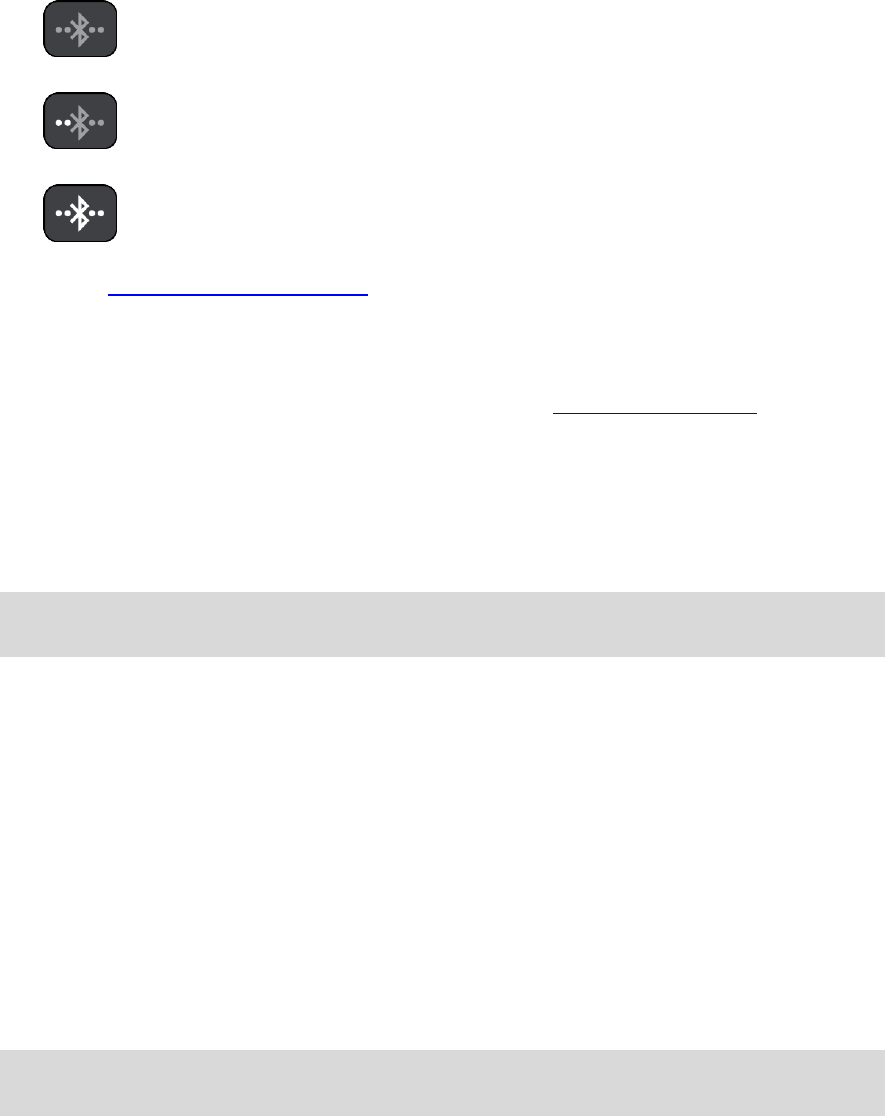
12
Reconnecting your smartphone
You do not need to do anything to reconnect your Rider to your phone.
Your Rider will remember your phone and will find it automatically when you have Personal Area
Network (PAN) and Bluetooth switched on and you are in range of your navigation device.
The Bluetooth icon at the top of the main menu screen shows the status of the Bluetooth
connection:
Bluetooth not connected.
Bluetooth connecting. Your device is trying to automatically connect to
your phone.
Bluetooth connected. Your device is connected to your phone.
If you want to connect using another phone, you must turn on Personal Area Network (PAN) and
Bluetooth on that phone, then let your device search for the phone.
Connect to TomTom services using a different smartphone
1. Follow the instructions on your device about switching on a Personal Area Network on your
smartphone.
2. Switch on Bluetooth on your smartphone.
3. Select Connected Services in the Main Menu.
4. Select Traffic & Speed Cameras or Traffic & Danger Zones.
5. Select the pop-up menu button then select Search for Phones.
Your navigation device searches for your smartphone.
Tip: If your device cannot find your smartphone, make sure your smartphone is still 'discovera-
ble' or 'visible' for other Bluetooth devices.
6. Select your smartphone from the list of smartphones on your device.
Your navigation device connects to TomTom services using your smartphone internet connec-
tion.
7. Login to your existing MyTomTom account.
TomTom services are now active.
Deleting phones
1. Select Connected Services in the Main Menu.
2. Select Traffic & Speed Cameras or Traffic & Danger Zones.
3. Select the pop-up menu button then select Delete Phones.
4. Select the phone that you want to delete.
5. Select Delete.
Your phone is deleted.
Tip: If you delete all your connected phones, you will no longer be able to use TomTom
services.
13
Unable to get a connection
To check your connection status to the internet, select Connected Services in the Main Menu. If
your connection status is shown as offline, select Offline and follow the instructions.
If your Rider cannot connect to your phone, or you have no internet connection, also check the
following:
Your phone is shown on your Rider.
Your phone's Bluetooth is switched on.
Your phone's Personal Area Network (PAN), which is also known as Personal Hotspot, Tethering,
or Bluetooth Tethering, is switched on.
Your data plan with your mobile services provider is active, and you can access the internet on
your phone.
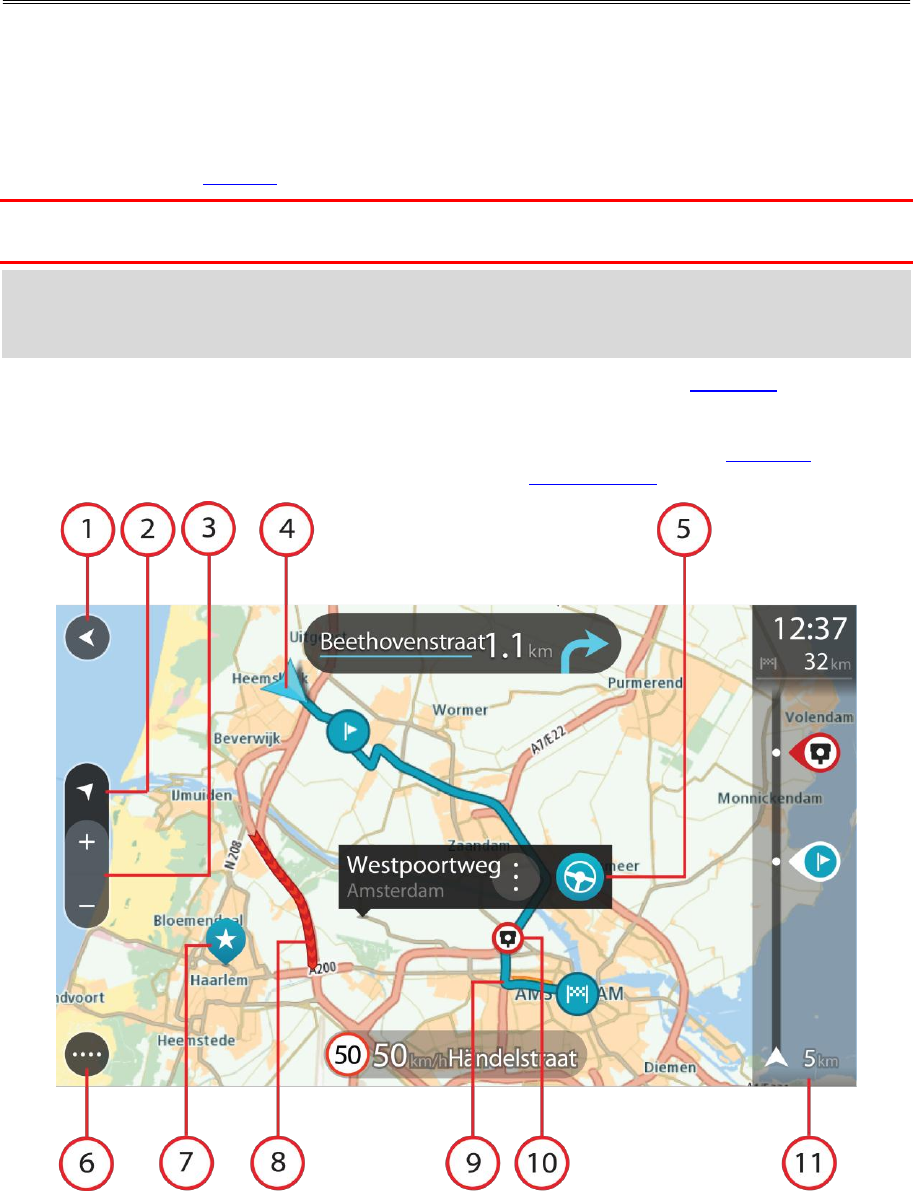
14
The map view
The map view is shown when you have no planned route. Your actual location is shown as soon as
your Rider has found your GPS location.
You can use map view in the same way as you might look at a traditional paper map. You can move
around the map using gestures, and zoom using the zoom buttons.
Important: Everything on the map is interactive including the route and the map symbols - try
selecting something and see what it does!
Tip: To open a pop-up menu for an item on the map, for example a route or a POI, select the
item to open the menu. To select a location on the map, select and hold the location until the
pop-up menu opens.
The map shows your current location and many other locations such as your My Places locations.
If you have not planned a route the map is zoomed out to show the area around your location.
If you have planned a route, your complete route is shown on the map. You can add stops to your
route directly from the map. When you start to drive, the guidance view is shown.
What's on the screen
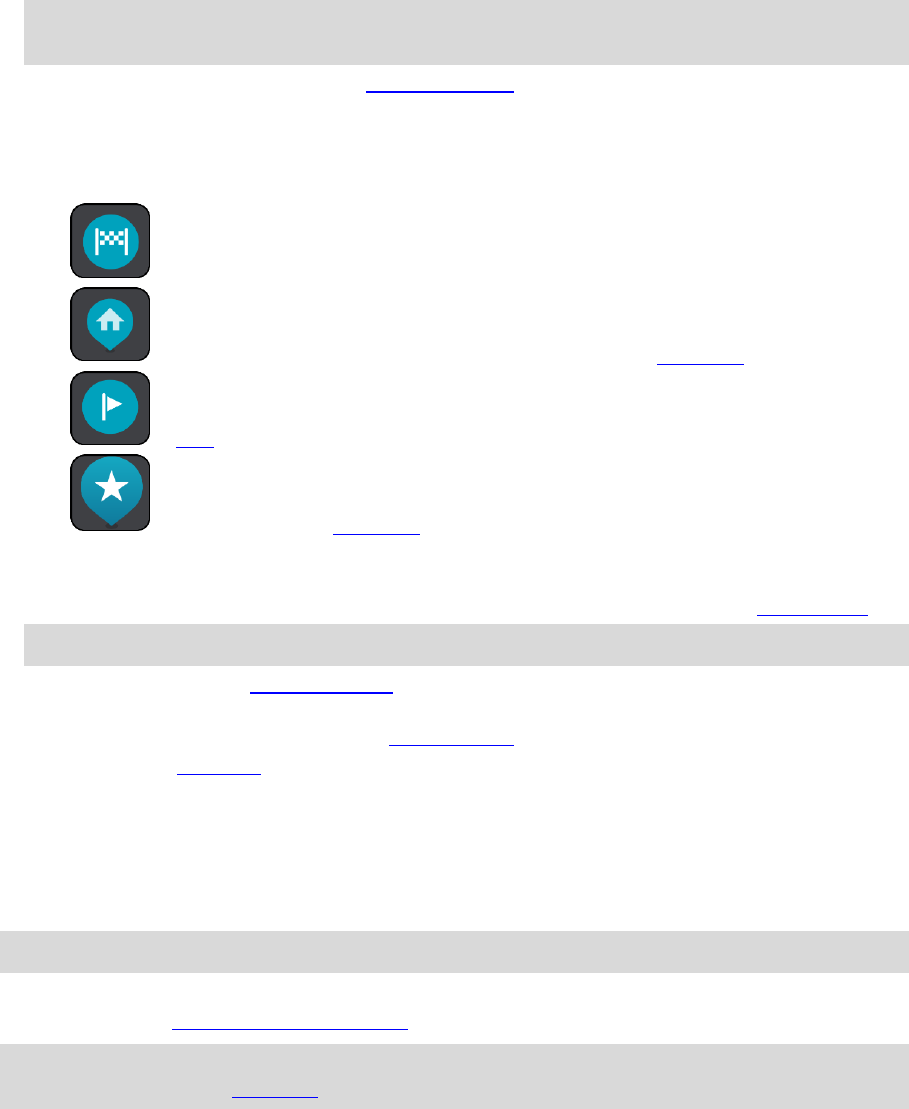
15
1. Back button. This button returns the map to an overview of your whole route or, if no route is
planned, moves the map to put your current location at the centre.
2. Switch view button. Select the switch view button to change between the map view and the
guidance view. When in map view, if you are driving, the small arrow rotates to show you your
current driving direction, with north being up.
3. Zoom buttons. Select the zoom buttons to zoom in and out.
4. Current location. This symbol shows your current location. Select it to add it to My Places or
search near your current location.
Note: If your Rider cannot find your location using GPS or other methods, the symbol appears
grey.
5. Selected location. Press and hold to select a location on the map. Select the pop-up menu
button to show options for the location, or select the drive button to plan a route to the loca-
tion.
6. Main Menu button. Select the button to open the Main Menu.
7. Map symbols. Symbols are used on the map to show your destination and your saved places:
Your destination.
Your home location. You can set your home location in My Places.
A stop on your route.
A location saved in My Places.
Select a map symbol to open the pop-up menu, then select the menu button to see a list of
actions you can take.
8. Traffic information. Select the traffic incident to display information about the traffic delay.
Note: Traffic information is only available if your TomTom Rider has TomTom Traffic.
9. Your route, if you have planned a route. Select the route to clear it, change the route type, add
a stop or save changes to your route.
10. Speed cameras on your route. Select a speed camera to display information about that camera.
11. Route bar. The route bar is shown when you have planned a route.
The guidance view
The guidance view is used to guide you along the route to your destination. The guidance view is
shown when you start driving. You see your current location and details along your route, including
3D buildings in some cities.
Note: 3D buildings in guidance view are not available on all Rider devices.
The guidance view is normally in 3D. To show a 2D map with the map moving in your direction of
travel, change the 2D and 3D default settings.
Tip: When you have planned a route and the 3D guidance view is shown, select the switch view
button to change to the map view and use the interactive features.
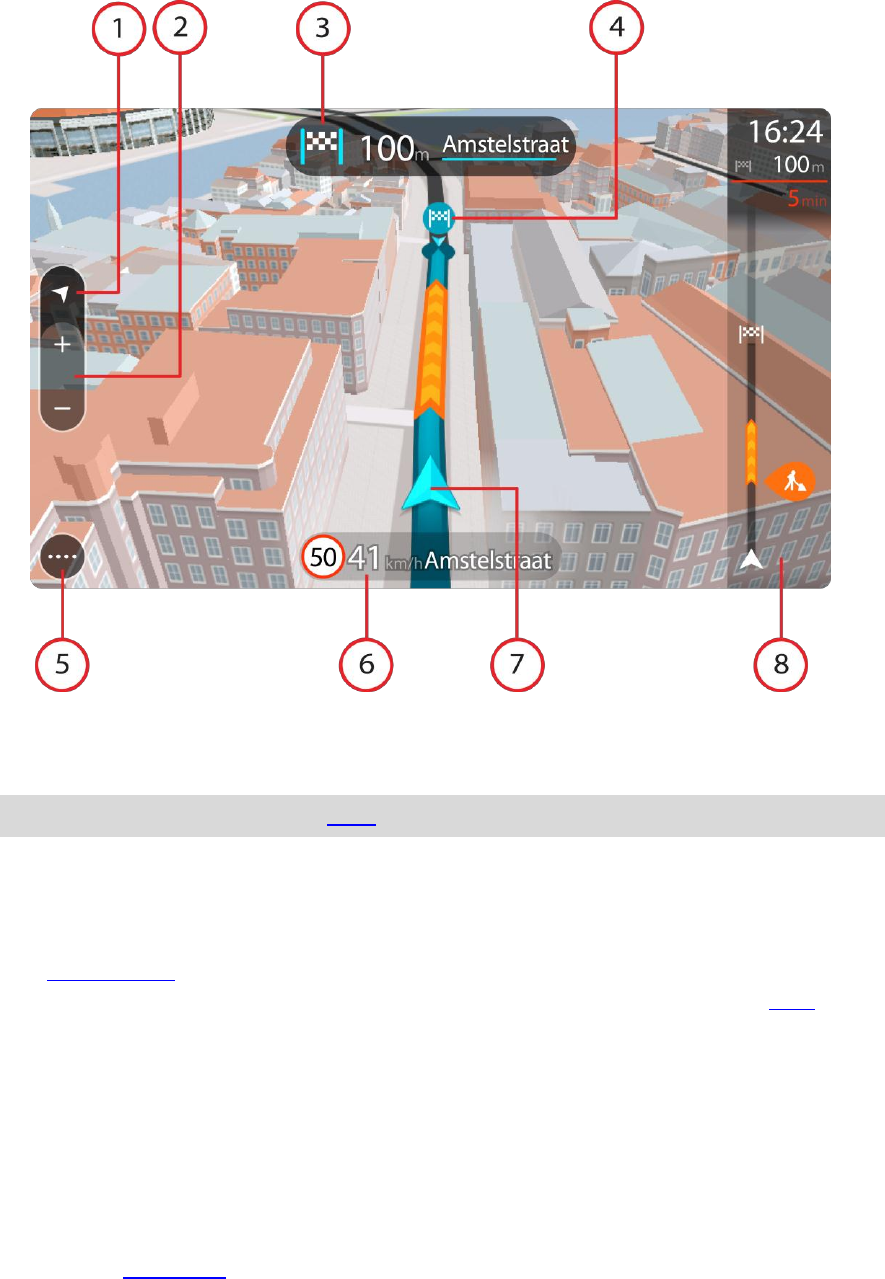
16
When your Rider starts after sleeping and you have a route planned, you are shown the guidance
view with your current location.
1. Switch view button. Select the switch view button to change between the map view and the
guidance view.
2. Zoom buttons. Select the zoom buttons to zoom in and out.
Tip: On some devices you can also pinch to zoom in and out.
3. Instruction panel. This panel shows the following information:
The direction of your next turn.
The distance to your next turn.
The name of the next road on your route.
Lane guidance at some junctions.
4. Route symbols. Symbols are used on your route to show your starting location, your stops, and
your destination.
5. Main Menu button. Select the button to show the Main Menu.
6. Speed panel. This panel shows the following information:
The speed limit at your location.
Your current speed. If you drive more than 5 km/h or 3 mph over the speed limit the speed
panel turns red. If you drive less than 5 km/h or 3 mph over the speed limit the speed panel
turns orange.
The name of the street you are driving on.
7. Current location. This symbol shows your current location. Select the symbol or the speed panel
to open the quick menu.
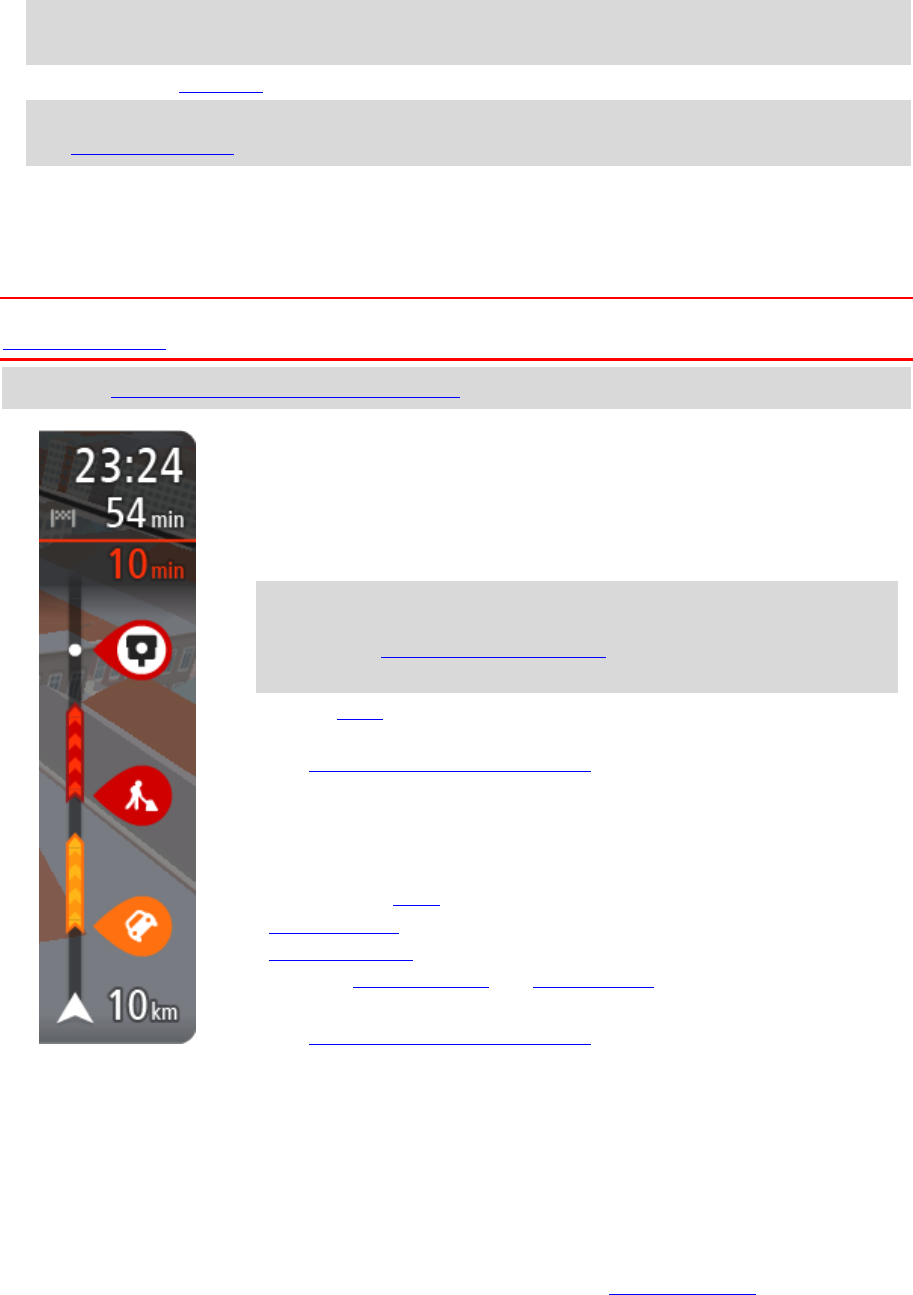
17
Note: If your Rider cannot find your location using GPS or other methods, the symbol appears
grey.
8. Route bar. The route bar is shown when you have planned a route.
Important: To see a wider route bar showing additional route information, change the setting
for Route Information.
The route bar
The route bar is shown when you have planned a route. It has an arrival information panel at the
top, and a bar with symbols underneath.
Important: To see a wider route bar showing additional route information, change the setting for
Route Information.
Note: The distance ahead shown by the route bar depends on the overall length of your route.
The arrival information panel shows the following information:
The estimated time that you will arrive at your destination.
The length of time to drive to the destination from your current
location.
A parking button is shown near the destination flag when parking is
available near your destination.
Tip: If your destination is in a different time zone, you see a plus
(+) or a minus (-) sign and the time difference in hours and half
hours in the arrival information panel. The estimated time of arrival
is the local time at your destination.
If you have stops on your route, select this panel to change between
information about the next stop and your final destination.
You can choose the information you see on the arrival information panel.
Traffic status - if your Rider isn't receiving any traffic information, a
symbol showing traffic with a cross appears underneath the arrival
information panel.
The bar uses symbols to show the following information:
The next two stops on your route.
Petrol stations that are directly on your route.
TomTom Traffic including heavy rain or snow.
TomTom Speed Cameras and Danger Zones.
Rest stops directly on your route.
You can choose the information you see on your route.
The symbols are in the order that they occur on your route. For traffic
incidents, the symbol for each incident alternates between showing the
type of incident and the delay in minutes. Select a symbol to see more
information about a stop, an incident or a speed camera. If a symbol is
shown on top of another symbol, selecting the symbols zooms in on the
route bar to show each symbol separately. You can then select a symbol.
The total time delay due to traffic jams, weather, and other incidents on
your route, including information provided by IQ Routes, is shown above
the symbols.
For a complete list of incident types, see Traffic incidents.
The bottom of the route bar represents your current location and shows
the distance to the next incident on your route. In addition, you can
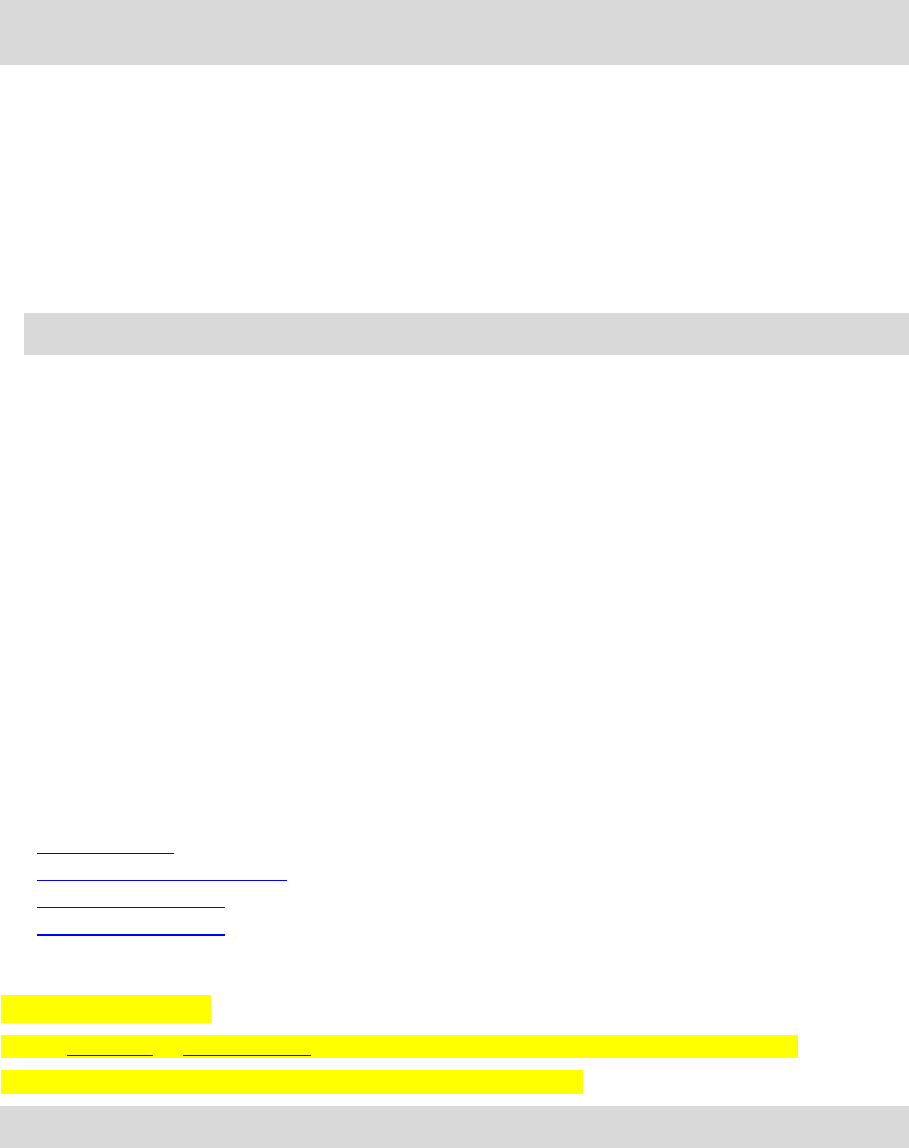
18
choose to see the current time if you switch the setting on.
Note: To make the route bar more readable some incidents may not be shown. These incidents
will always be of minor importance and only cause short delays.
The route bar also shows status messages, for example Finding fastest route or Playing route
preview.
Distances and the route bar
The distance ahead shown on the route bar depends on the length of your route, or the distance
remaining on your route.
For remaining distances longer than 50 km (31 miles), only the next 50 km (31 miles) is shown.
The destination icon is not shown.
Tip: You can scroll the route bar to see your whole route.
For remaining distances between 10 km (6 miles) and 50 km (31 miles), the complete distance is
shown. The destination icon is shown fixed at the top of the route bar.
For remaining distances of less than 10 km (6 miles) the complete distance is shown. The
destination icon moves down towards the chevron symbol as you get nearer to your destination.
The top half of the route bar shows twice the distance of the bottom half, as shown in the following
examples:
A remaining distance of 50 km on the route bar is split into 34 km (21 miles) at the top and 16
km (9 miles) at the bottom.
A remaining distance of 10 km on the route bar is split into 6.6 km (4 miles) at the top and 3.3
km (2 miles) at the bottom.
The route bar is constantly updated as you drive.
The quick menu
To open the quick menu, select the current location symbol or the speed panel in the guidance
view.
You can then do any of the following:
Mark a location
Report a new speed camera
Change a speed limit
Avoid a blocked road
See your current location or your latitude/longitude if not on a named road.
Navigation buttons
On the map view or guidance view, select the Main Menu button to open the Main Menu.
The following navigation buttons are available in the Main Menu:
Note: Not all features are supported on all devices.
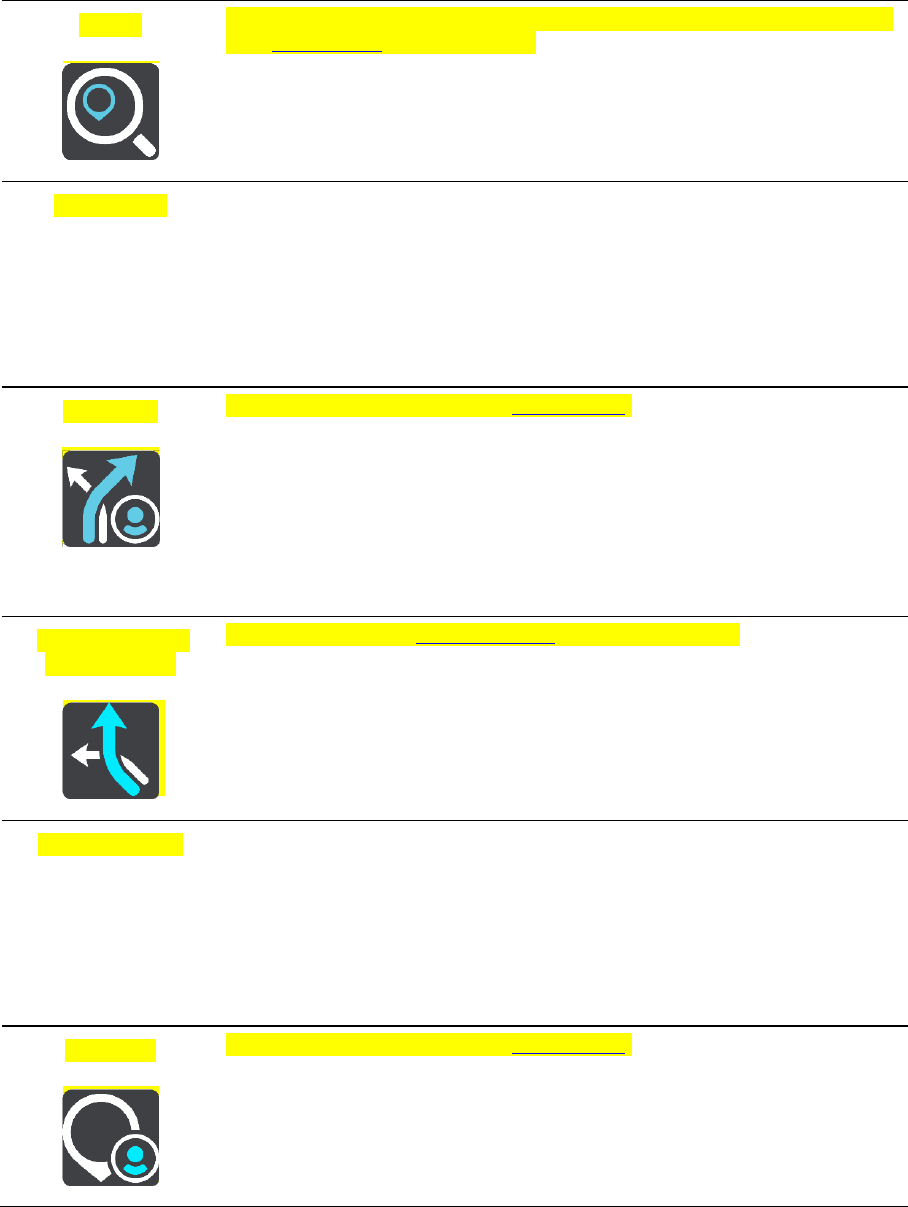
19
Search
Select this button to search for an address, a place or a Point of Interest,
then plan a route to that location.
Plan a Thrill
My Routes
Select this button to show your saved routes.
Current Route /
Current Track
Select this button to clear or change your planned route.
Start Recording
My Places
Select this button to show your saved places.
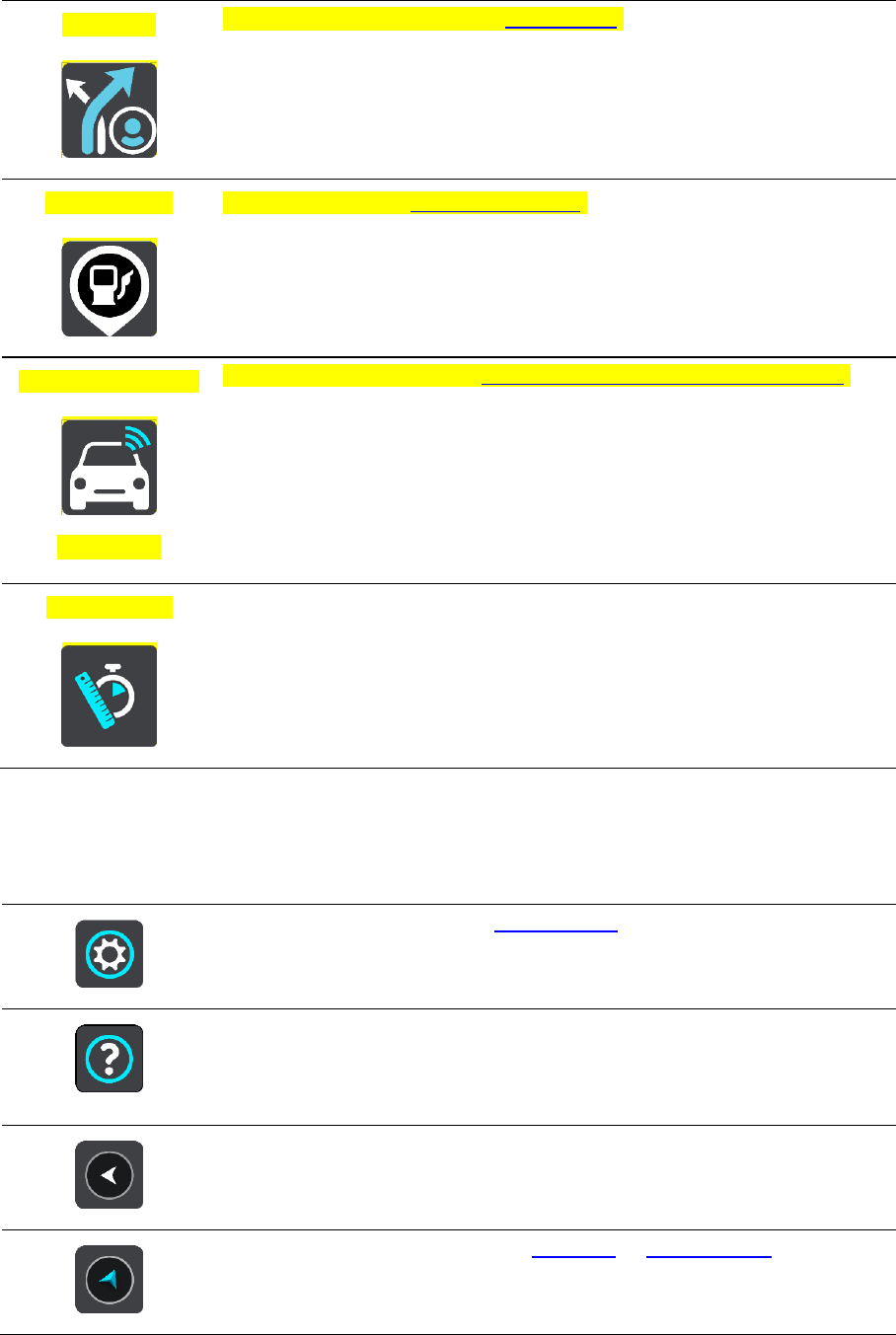
20
My Routes
Select this button to show your saved routes.
Petrol Station
Select this button to find petrol stations.
Connected Services
ICON CHANGED
Select this button to see the status of your connection to the internet.
Trip Statistics
Other buttons
On the map or guidance view, select the Main Menu button to open the Main Menu.
The following buttons are available in the Main Menu screen, in addition to the navigation buttons:
Select this button to open the Settings Menu.
Select this button to open the Help Menu. The Help Menu contains help for
using Voice control if supported by your device, together with other
information about your Rider, for example, map version, device serial
number and legal information.
Select this button to return to the previous screen.
Select this button to return to the map view or guidance view.
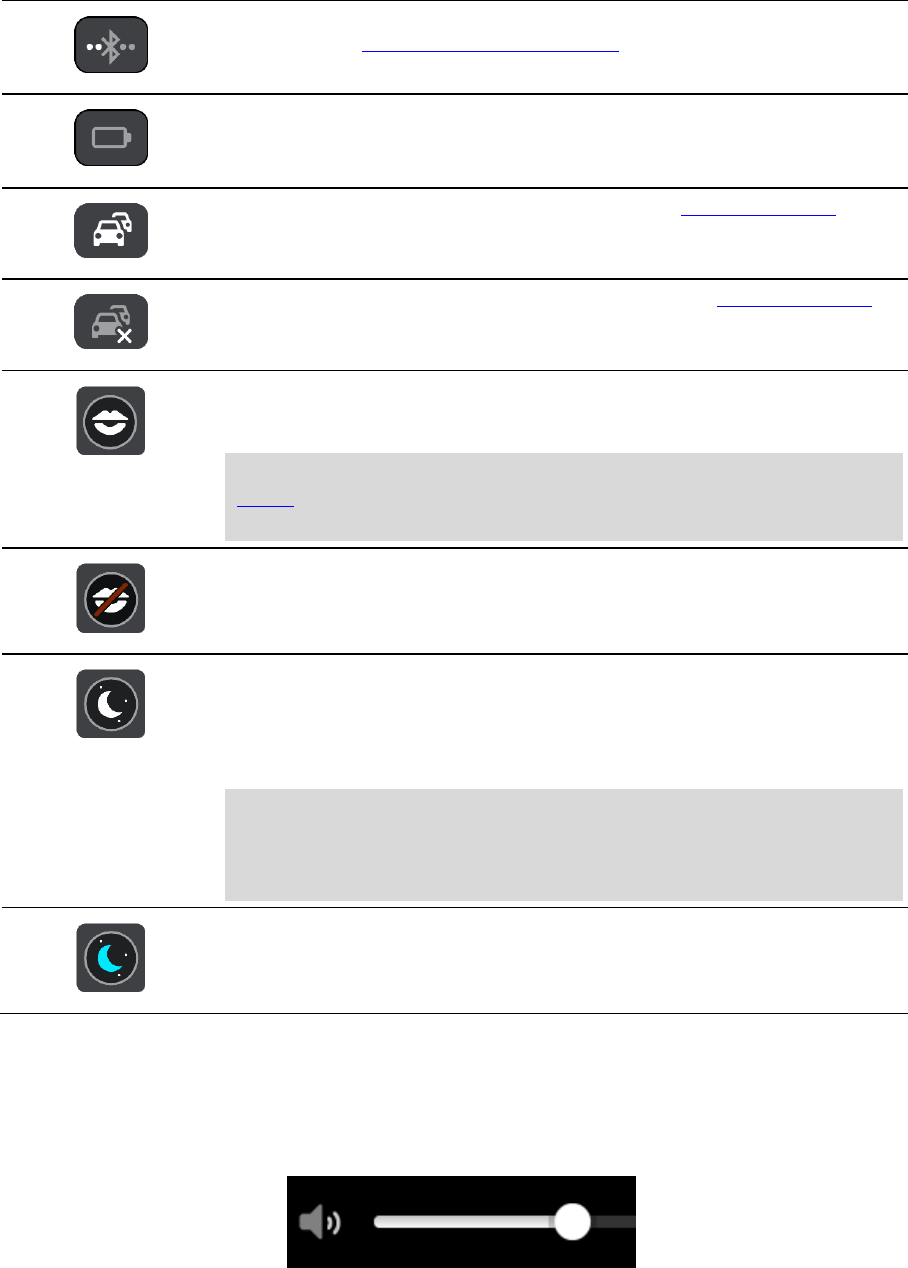
21
This symbol shows the status of the Bluetooth connection when you use a
smartphone to connect to TomTom services.
This symbol shows the power level of the battery in your Rider.
This symbol shows that your Rider is connected to TomTom services.
This symbol shows that your Rider is not connected to TomTom services.
Select this button to switch off voice instructions. You will no longer hear
spoken route instructions but you will still hear information such as traffic
information and warning sounds.
Tip: You can select the types of instructions you want to hear. Select
Voices in the Settings Menu and select the instructions you want to
hear.
Select this button to switch on voice instructions.
Select this button to reduce the brightness of the screen and display the
map in darker colours.
When driving at night or when driving through a dark tunnel, it is easier to
view the screen and less distracting for the driver if the brightness of the
screen is dimmed.
Tip: Your device automatically switches between day and night colours
depending on the time of day. To switch off this feature, select
Appearance in the Settings menu and switch off Switch to night colours
when dark.
Select this button to increase the brightness of the screen and display the
map in brighter colours.
Volume control
On the map or guidance view, select the Main Menu button to open the Main Menu.
Select and slide the volume control to change the volume of voice instructions and warnings. If the
voice instructions are switched off, the volume control will still change the volume of the warnings.
Using gestures
You use gestures to control your Rider.
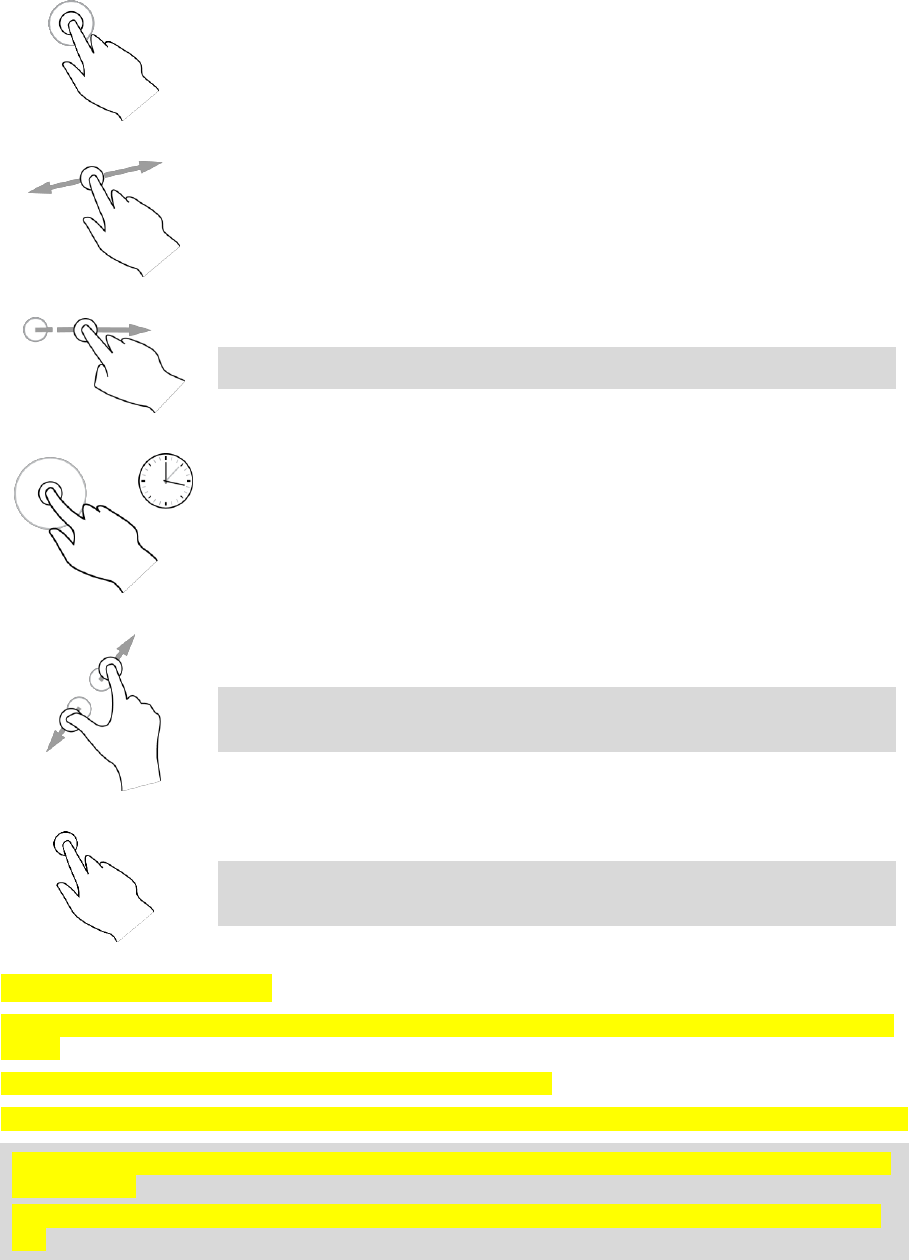
22
This Reference Guide explains which gestures to use throughout the guide but here is a complete
list of all the gestures you can use.
Double tap
Touch one finger on the screen twice in rapid succession.
Example of when to use this: Zooming in on the map.
Drag
Put one finger on the screen and move it across the screen.
Example of when to use this: Scrolling around in the map.
Flick
Flick the tip of a single finger across the screen.
Example of when to use this: Scrolling a big distance on the map.
Tip: Flick isn't available on all devices.
Press and hold
Put one finger on the screen for more than 0.5 second.
Example of when to use this: Opening the pop-up menu for a place on the
map.
Pinch to zoom
Touch the screen with your thumb and a finger. Move them apart to zoom
in or move them together to zoom out.
Example of when to use this: Zooming in and out on the map.
Tip: Pinch to zoom isn't available on all devices. If pinch to zoom isn't
available on your Rider, use the zoom buttons to zoom in and out.
Tap or select
Tap a single finger on the screen.
Example of when to use this: Selecting an item in the Main Menu.
Tip: To open a pop-up menu for an item on the map, select and hold
the item until the menu opens.
Looking at trip statistics
Your Rider can show you how far you've been riding, how long you've been riding, and also at what
speed.
To see trip statistics, select Trip Statistics in the Main Menu.
Select one of the three tabs to see statistics for today's riding, for your current trip and for all-time.
Tip: All-time are the statistics that have been collected since the device was purchased and first
switched on.
Tip: A dot is included in large distances, for example, 20047,64 kilometres is shown as 20.047,6
km.
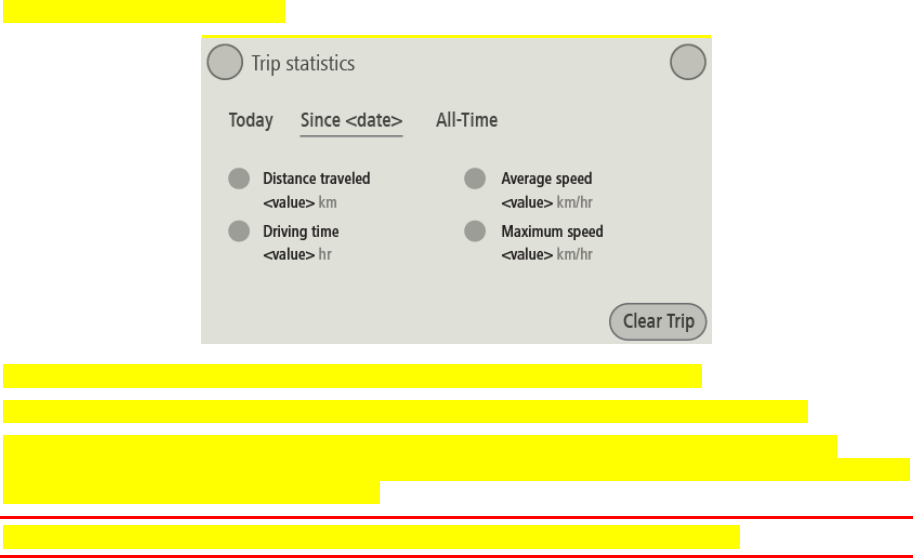
23
Statistics for your current trip
To see statistics for the trip you are riding now, select the Since --/--/-- tab.
To start a new trip, select the Clear trip button, just like resetting an odometer in a car.
After stopping your bike, if you don't press the Clear trip button, the statistics just carry on
incrementing when you start moving again. This means you get accurate statistics for trips that span
several days or several rides within a day.
Important: If you do a factory reset, the all-time tab is reset back to zero values!
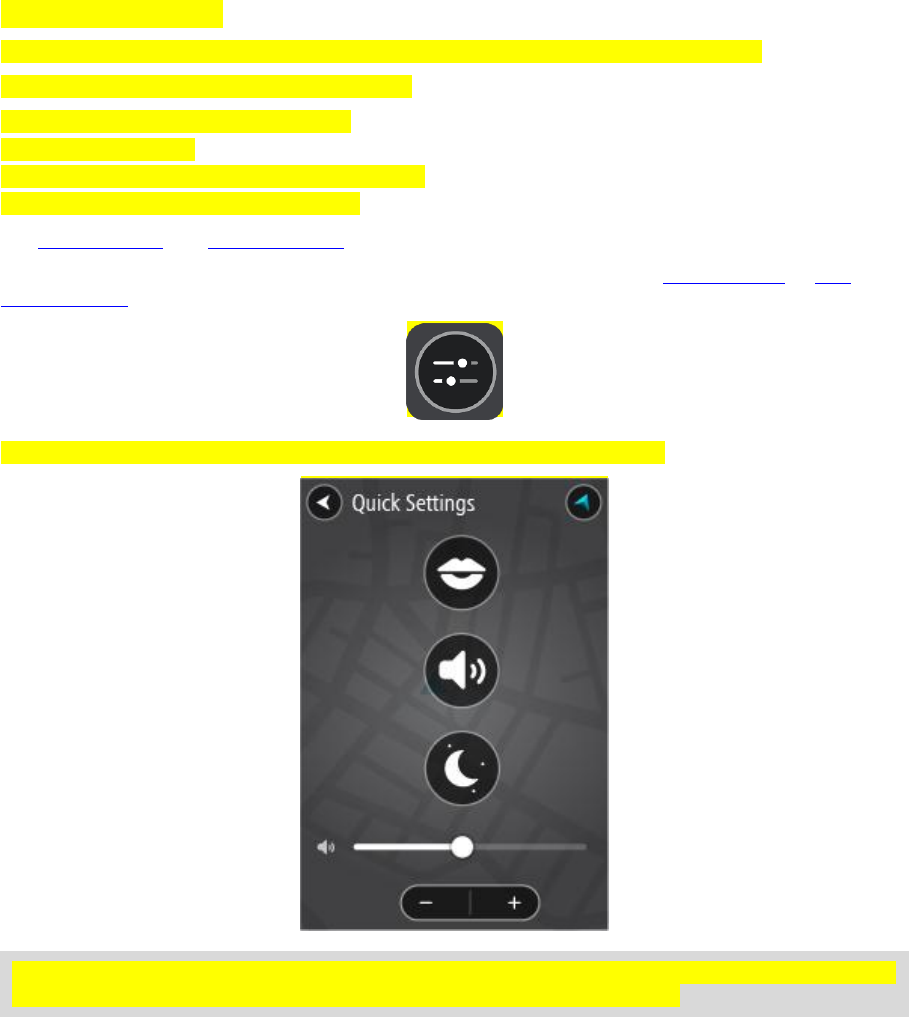
24
Using quick settings
Quick settings make it easier for you to use a range of settings when wearing gloves.
Using quick settings you can do the following:
Switch voice instructions on or off.
Mute the volume.
Switch between lighter and darker colours.
Change the volume of instructions.
See Other buttons and Volume control for more details.
To use quick settings, select the quick settings button in the main menu, the map view or the
guidance view.
You see the screen shown below with large buttons and a volume control:
Tip: When wearing gloves, select the plus (+) and minus (-) buttons underneath the volume slider
to change the volume, instead of trying to move the slider with gloves on.
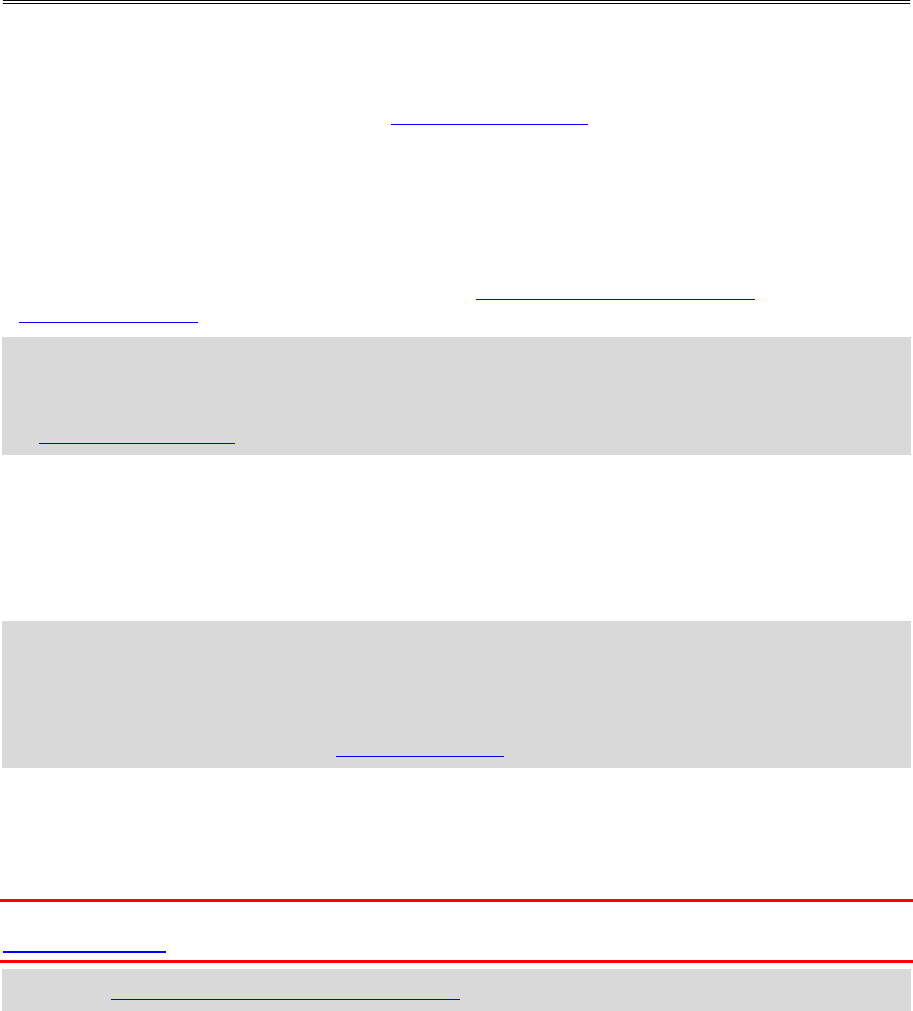
25
About TomTom Traffic
TomTom Traffic is a unique TomTom service providing real-time traffic information. For more
information about TomTom services, go to tomtom.com/services.
In combination with IQ Routes, TomTom Traffic helps you plan the optimum route to your
destination taking into account the current local traffic conditions and the weather.
Your TomTom Rider regularly receives information about the changing traffic conditions. If traffic
jams, heavy rain, snow or other incidents are found on your current route, your Rider will offer to
replan your route to try and avoid any delays.
To get TomTom services on your Rider, you must be connected to TomTom services and logged in to
a MyTomTom account.
Note: TomTom services are not available on all devices.
Note: TomTom services are not available in all countries or regions, and not all services are
available in all countries or regions. For more information on available services in each region, go
to tomtom.com/services.
About RDS-TMC
The Traffic Message Channel (TMC), also known as RDS-TMC, transmits traffic information as a radio
signal and is available free of charge in many countries.
TMC is not a TomTom service, but is available when using the TomTom RDS-TMC Traffic Receiver.
Note: The RDS-TMC receiver is not available in all countries.
TomTom is not responsible for the availability or quality of traffic information provided by the
Traffic Message Channel.
The Traffic Message Channel (TMC) is not available in all countries. To check the availability of
TMC services in your country, go to tomtom.com/5826.
The route bar
The route bar is shown when you have planned a route. It has an arrival information panel at the
top, and a bar with symbols underneath.
Important: To see a wider route bar showing additional route information, change the setting for
Route Information.
Note: The distance ahead shown by the route bar depends on the overall length of your route.
Traffic
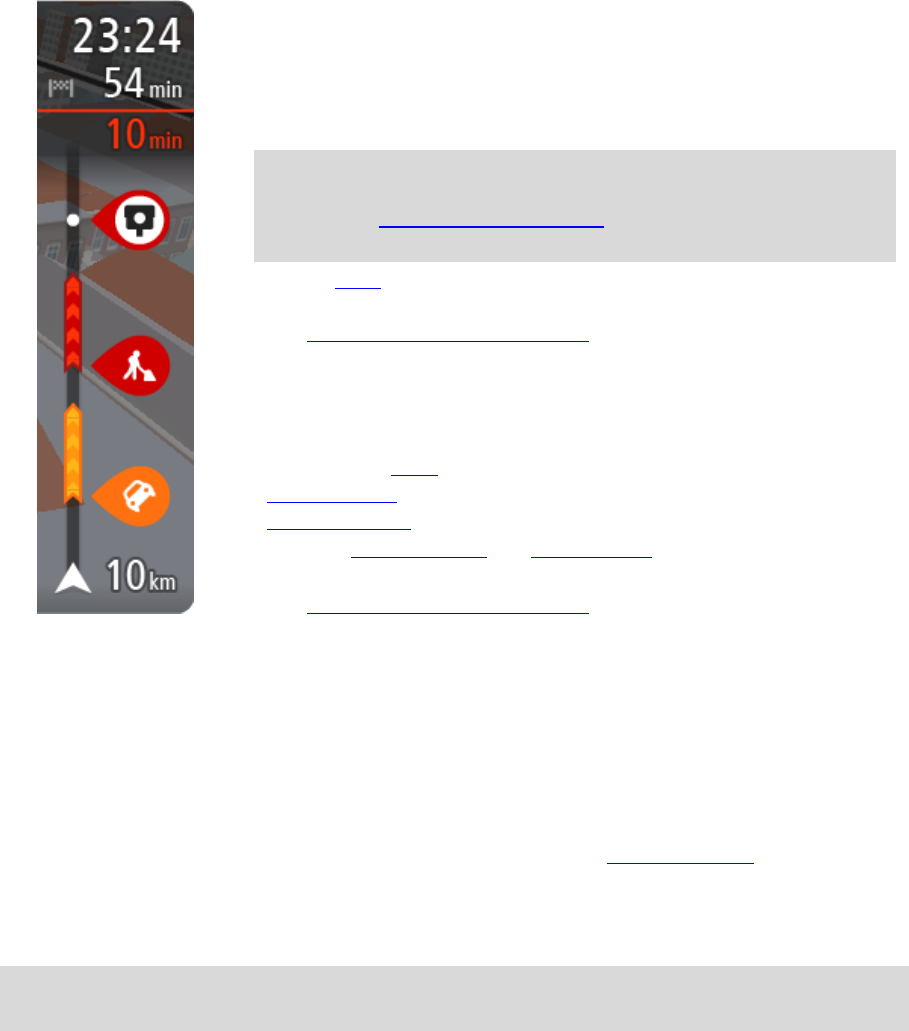
26
The arrival information panel shows the following information:
The estimated time that you will arrive at your destination.
The length of time to drive to the destination from your current
location.
A parking button is shown near the destination flag when parking is
available near your destination.
Tip: If your destination is in a different time zone, you see a plus
(+) or a minus (-) sign and the time difference in hours and half
hours in the arrival information panel. The estimated time of arrival
is the local time at your destination.
If you have stops on your route, select this panel to change between
information about the next stop and your final destination.
You can choose the information you see on the arrival information panel.
Traffic status - if your Rider isn't receiving any traffic information, a
symbol showing traffic with a cross appears underneath the arrival
information panel.
The bar uses symbols to show the following information:
The next two stops on your route.
Petrol stations that are directly on your route.
TomTom Traffic including heavy rain or snow.
TomTom Speed Cameras and Danger Zones.
Rest stops directly on your route.
You can choose the information you see on your route.
The symbols are in the order that they occur on your route. For traffic
incidents, the symbol for each incident alternates between showing the
type of incident and the delay in minutes. Select a symbol to see more
information about a stop, an incident or a speed camera. If a symbol is
shown on top of another symbol, selecting the symbols zooms in on the
route bar to show each symbol separately. You can then select a symbol.
The total time delay due to traffic jams, weather, and other incidents on
your route, including information provided by IQ Routes, is shown above
the symbols.
For a complete list of incident types, see Traffic incidents.
The bottom of the route bar represents your current location and shows
the distance to the next incident on your route. In addition, you can
choose to see the current time if you switch the setting on.
Note: To make the route bar more readable some incidents may not be shown. These incidents
will always be of minor importance and only cause short delays.
The route bar also shows status messages, for example Finding fastest route or Playing route
preview.
Looking at traffic on the map
Traffic incidents are shown on the map. If several traffic incidents overlap the highest priority
incident is shown - for example, a road closure is higher priority than road works or a closed lane.
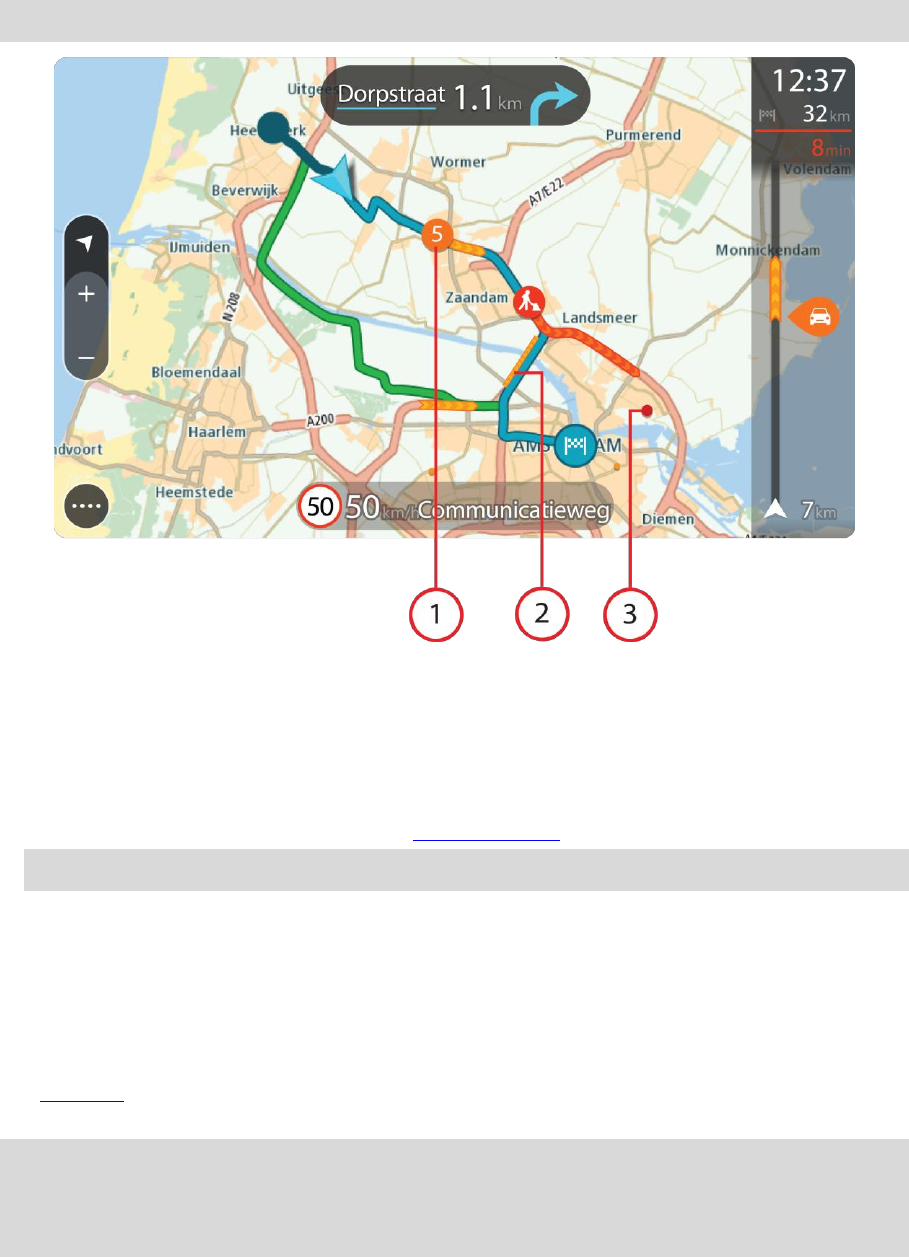
27
Tip: Select an incident on the map to see more detailed information.
1. Traffic incident that affects your route in your direction of travel.
A symbol or number at the start of the incident shows the type of incident or the delay in
minutes, for example 5 minutes.
The colour of the incident indicates the speed of traffic relative to the maximum allowed speed
at that location, with red being the slowest. The stripes on the traffic jam are also animated to
show the speed of the traffic, where appropriate.
For a complete list of incident types, see Traffic incidents.
Tip: You see weather symbols on the map if there is bad weather such as heavy rain or snow.
2. Traffic incident on your route but in the opposite direction of travel.
3. Traffic incidents on roads that are not visible at your current zoom level.
Looking at traffic on your route
Information about traffic incidents on your route is shown in the route bar on the right-hand side of
the map.
The route bar tells you about traffic delays while you are driving, using symbols to show you where
each traffic incident is located on your route.
Note: If your Rider isn't receiving any traffic information, a symbol showing traffic with a cross
appears underneath the arrival information panel.
Note: To make the route bar more readable some incidents may not be shown. These incidents
will always be of minor importance and only cause short delays.
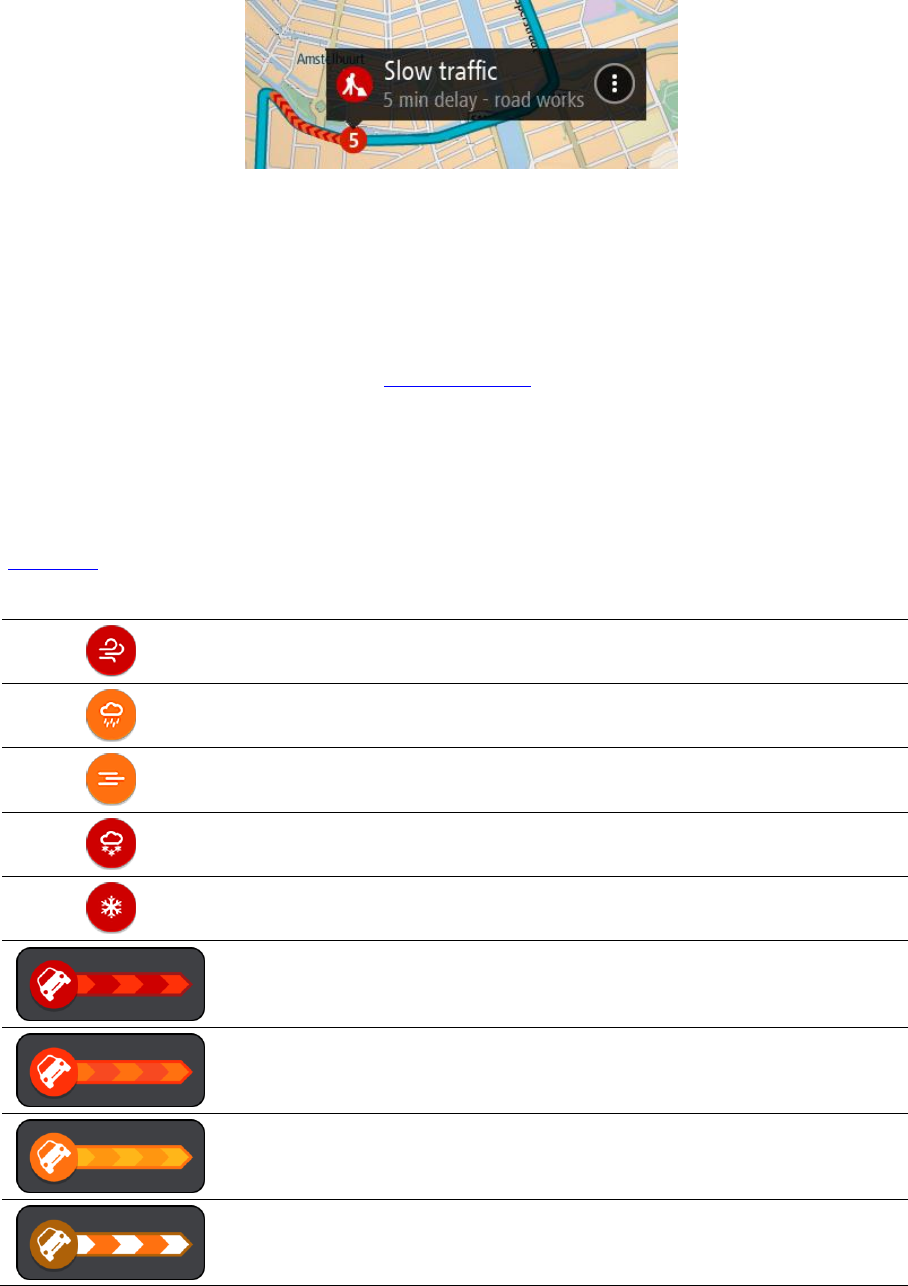
28
To get more information about an incident, select an incident in the route bar. The map opens
zoomed in on the incident and a pop-up opens showing detailed information about the traffic
incident.
The information shown includes:
The type of traffic incident - general, accident, road works, lane closure or weather such as
heavy rain or snow.
The severity of the incident - slow traffic, queuing traffic or stationary traffic.
The delay time.
The length of the incident.
For a complete list of incident types, see Traffic incidents.
Select the back button to go back to the guidance view.
Traffic incidents
Traffic incidents and warnings are shown in the map view and in the route bar. Symbols shown in a
circle are traffic incidents. Checks are done to see if a faster route is available and your route is
replanned to avoid traffic incidents.
Traffic incident symbols:
Wind
Rain
Fog
Snow
Ice
Stationary traffic
Queuing traffic
Slow traffic
Unknown accident
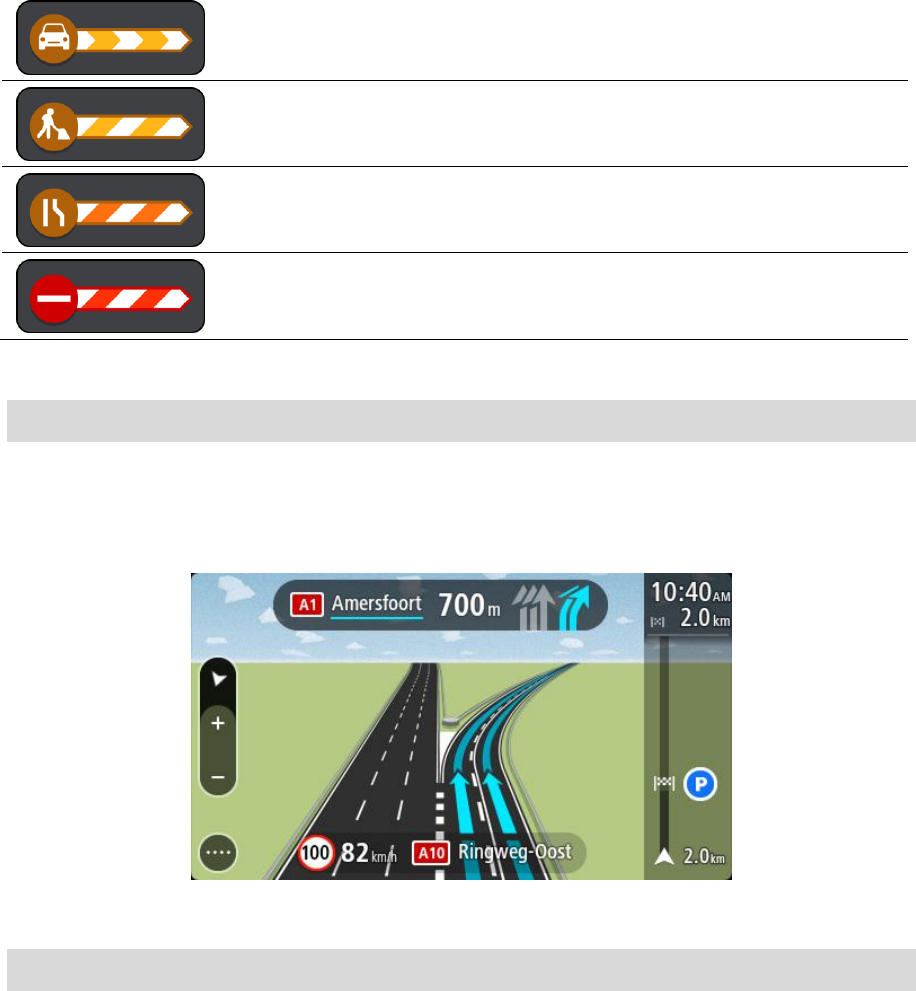
29
Unknown incident
Roadworks
Lane closure
Road closure
Advanced Lane Guidance
Note: Lane guidance is not available for all junctions or in all countries.
Advanced Lane Guidance helps you prepare for motorway exits and junctions by showing the correct
driving lane for your planned route.
As you approach an exit or junction, the lane you need is shown on the screen and in the instruction
panel.
Tip: To close the lane image, select anywhere on the screen or press the back button.
To turn lane images off, select the Settings button in the Main Menu, then select Appearance.
Switch off the Show previews of motorway exits setting.
Time-dependent speed limits
Some speed limits change depending on the time of day. For example, you may see the speed limit
near schools decrease to 40 km/h or 25 mph in the morning between 08.00 - 09.00 and in the
afternoon between 15.00 - 16.00. Where possible, the speed limit shown in the speed panel changes
to show these variable speed limits.
Some speed limits change depending on driving conditions. For example, the speed limit will
decrease if there is heavy traffic, or the weather conditions are bad. These variable speed limits are
not shown in the speed panel. The speed shown in the speed panel is the maximum speed limit
allowed in good driving conditions.

30
Important: The speed limit shown in the speed panel is only an indication. You must always obey
the actual speed limit for the road you are on and the conditions you are driving in.
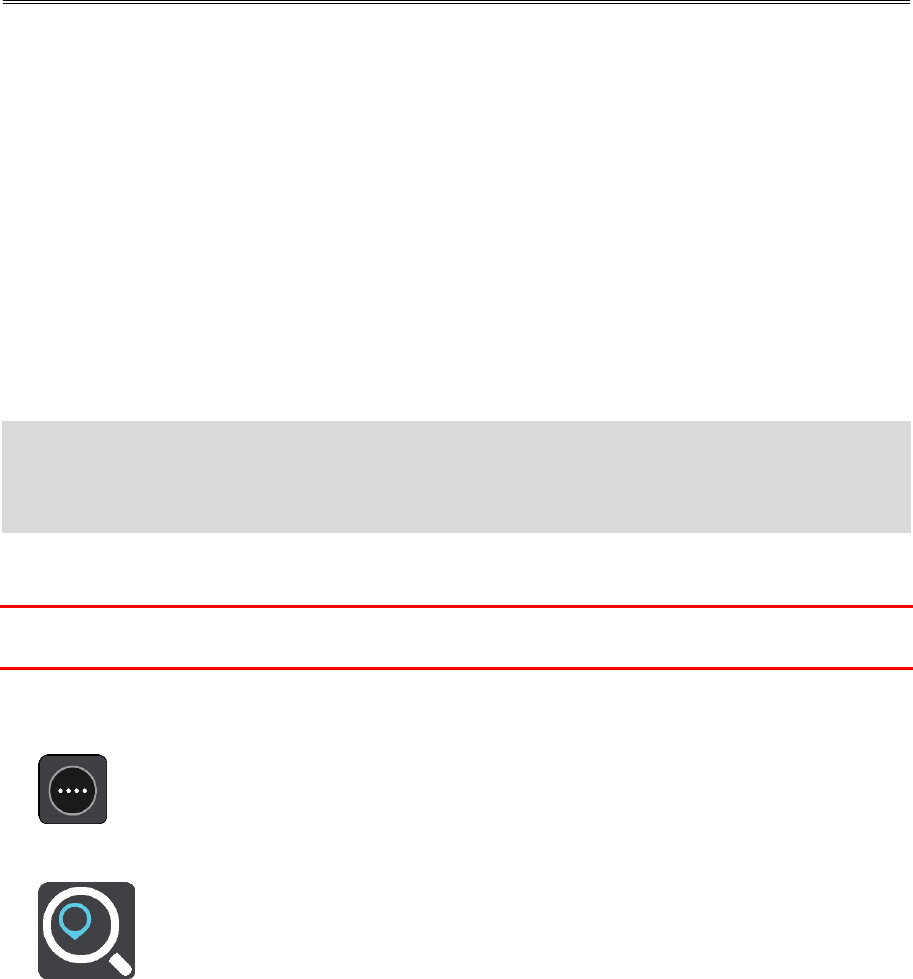
31
About search
You use search to find a wide range of places and then navigate to them. You can search for the
following:
A specific address, for example, 123 Oxford Street, London.
A partial address, for example, Oxford st Lon.
A type of place, for example, petrol station or restaurant.
A place by name, for example, Starbucks.
A postcode, for example, W1D 1LL for Oxford Street, London.
A city to navigate to a city centre, for example, London.
A POI (Point of Interest) near your current location, for example, restaurant near me.
A mapcode, for example, WH6SL.TR10
Latitude and longitude coordinates, for example,
N 51°30′31″ W 0°08′34″.
Tip: To search for a specific street in the United Kingdom or the Netherlands, type in a postcode,
then leave a space and then type in the house number. For example, "1017CT 35". For other
countries, postcodes are area-based and will give you a list of matching cities, towns and streets
in your search results.
Planning a route to a POI using search
Important: In the interest of safety and to avoid distractions while you are driving, you should
always plan a route before you start driving.
To plan a route to a POI type or a specific POI using search, do the following:
1. Select the Main Menu button to open the Main Menu.
2. Select Search.
The search screen opens with the keyboard showing.
3. Use the keyboard to enter the name of the place you want to plan a route to.
Using Quick Search
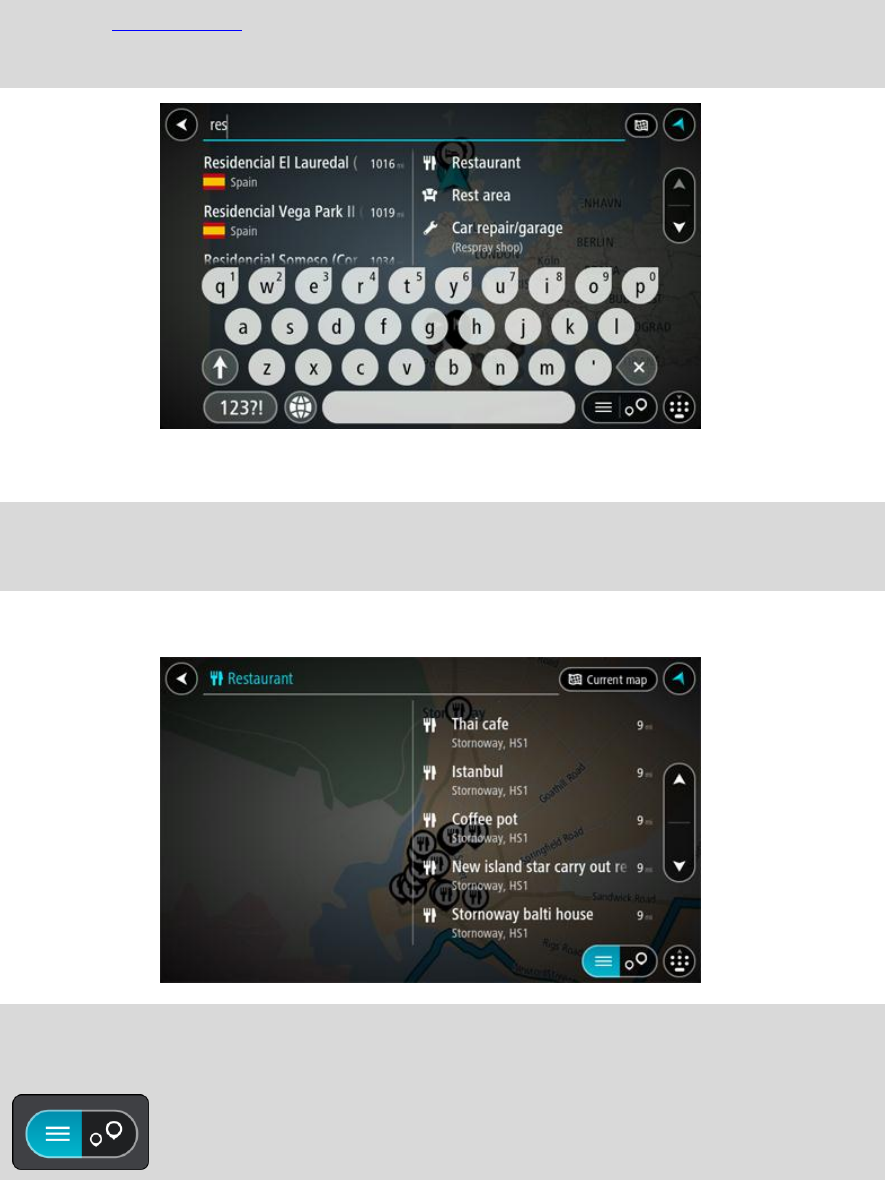
32
Tip: If you press and hold a letter key on the keyboard, you get access to extra characters if
they are available. For example, press and hold the letter "e" to access characters 3 e è é ê ë
and more.
You can search for a POI (Point of Interest) type, such as a restaurant or tourist attraction.
Alternatively, you can search for a specific POI, for example "Rosie's Pizzeria".
Note: When searching, the whole map is searched. If you want to change how the search is
done, select the button to the right of the search box. You can then change where the search
is done, for example along the route or in a city.
4. As you type, suggestions based on what you have entered are shown in columns. You can
continue typing or select a suggestion.
Tip: To see more results, hide the keyboard or swipe the results list to scroll it.
Tip: You can switch between seeing the results on the map or in a list by selecting the
list/map button:
5. Select a POI type or an individual POI. If you selected a POI type, select a POI.
The location is shown on the map.
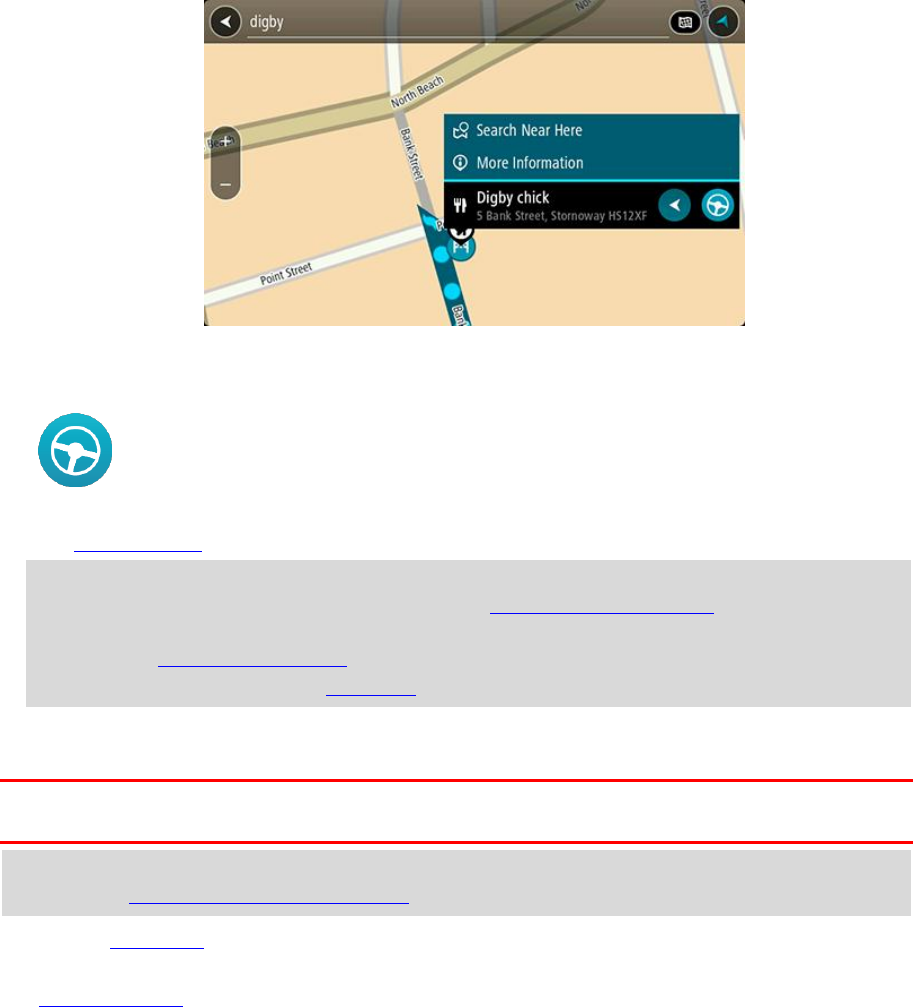
33
6. To see more information about the POI, select the POI on the map and then select the pop-up
menu button. Select More Information on the pop-up menu.
You see more information about the POI such as the phone number, full address and email.
7. To plan a route to this destination, select the drive button:
A route is planned and then guidance to your destination begins. As soon as you start driving,
the guidance view is shown automatically.
Tip: If your destination is in a different time zone, you see a plus (+) or a minus (-) sign and
the time difference in hours and half hours in the arrival information panel. The estimated
time of arrival is the local time at your destination.
Tip: You can add a stop to a route that you have already planned.
Tip: You can save a route using My Routes.
Planning a route to a POI using online search
Important: In the interest of safety and to avoid distractions while you are driving, you should
always plan a route before you start driving.
Note: Searching online is only available on connected devices. To search online on your Rider,
you must be connected to TomTom services.
If you did a POI search but could not find the POI you were looking for, you can search TomTom
Places online. To find POIs by searching online, do the following:
1. Search for a POI using Search in the Main Menu.
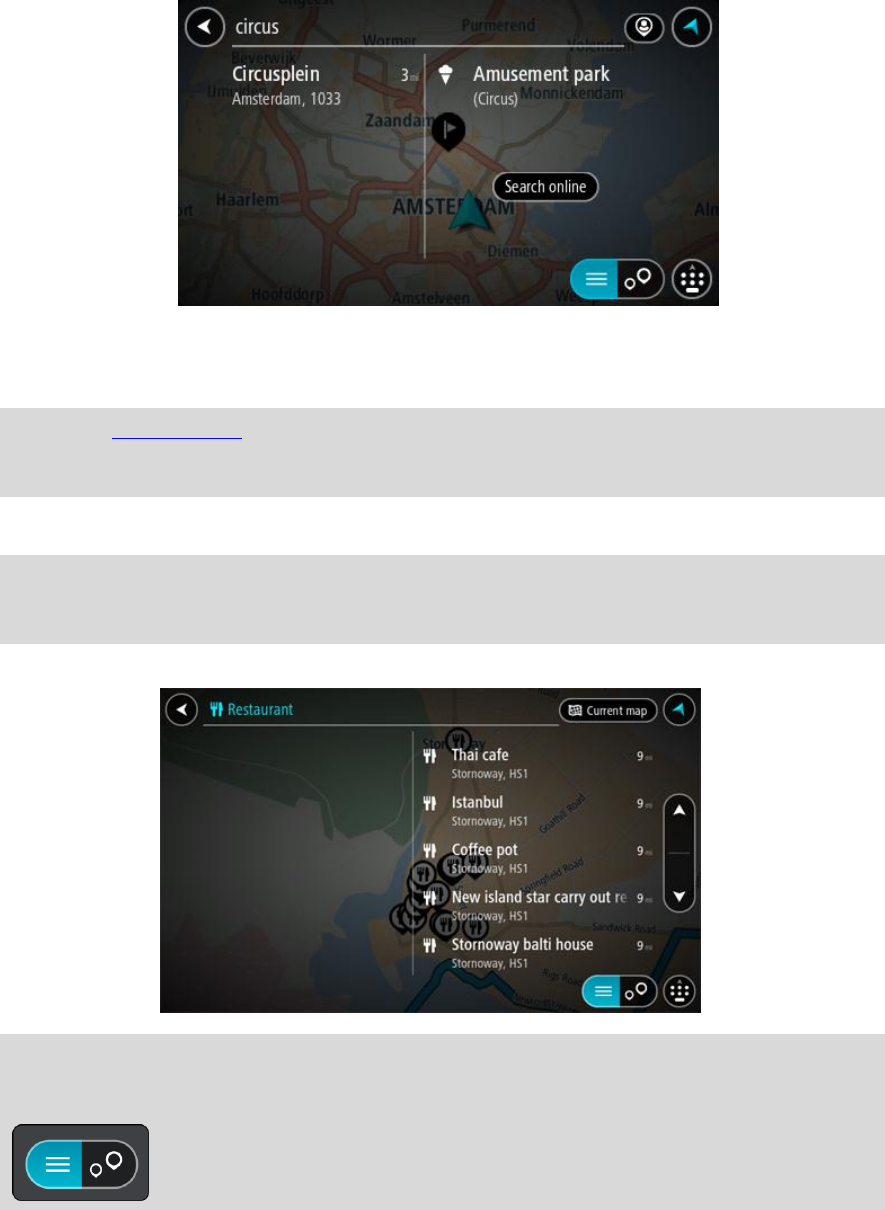
34
The search results are shown in two columns.
2. Select Search Places Online.
3. Use the keyboard to enter the name of the POI you want to find, then press the Search button
on the keyboard.
Tip: If you press and hold a letter key on the keyboard, you get access to extra characters if
they are available. For example, press and hold the letter "e" to access characters 3 e è é ê ë
and more.
You can search for a POI (Point of Interest) type, such as a restaurant or tourist attraction.
Alternatively, you can search for a specific POI, for example "Rosie's Pizzeria".
Note: When searching, you can search near your current location, in a town or city, or near
your destination. If you want to change how the search is done, select the button to the right
of the search box.
The search results are shown in a column.
Tip: To see more results, hide the keyboard or swipe the results list to scroll it.
Tip: You can switch between seeing the results on the map or in a list by selecting the
list/map button:
4. Select an individual POI from the list.
The location is shown on the map.
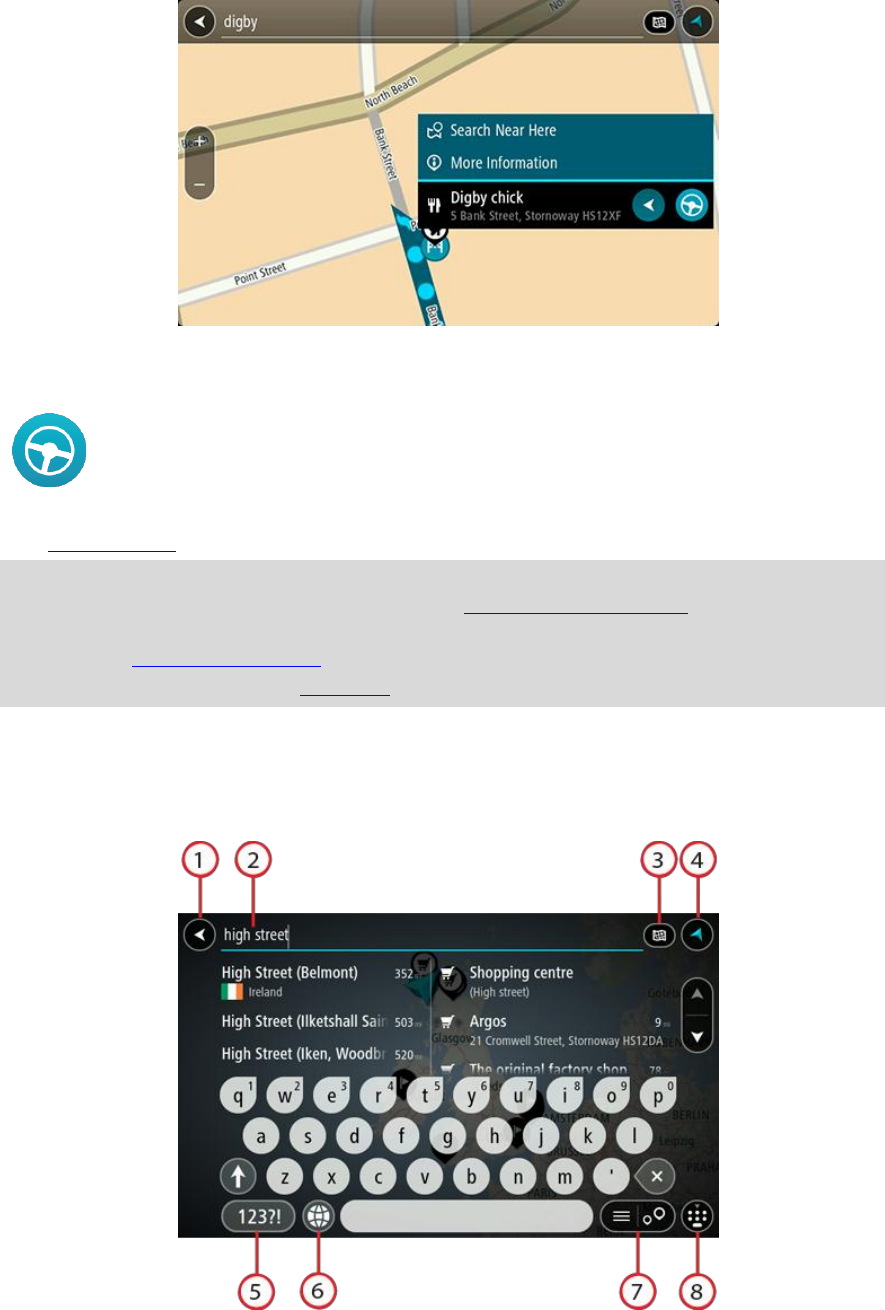
35
5. To see more information about the POI, select the POI on the map and then select the pop-up
menu button. Select More Information on the pop-up menu.
You see more information about the POI such as the phone number, full address and email.
6. To plan a route to this destination, select the drive button:
A route is planned and then guidance to your destination begins. As soon as you start driving,
the guidance view is shown automatically.
Tip: If your destination is in a different time zone, you see a plus (+) or a minus (-) sign and
the time difference in hours and half hours in the arrival information panel. The estimated
time of arrival is the local time at your destination.
Tip: You can add a stop to a route that you have already planned.
Tip: You can save a route using My Routes.
Entering search terms
Select Search in the Main menu to start searching for addresses and POIs. The search screen opens
showing the keyboard and the following buttons:
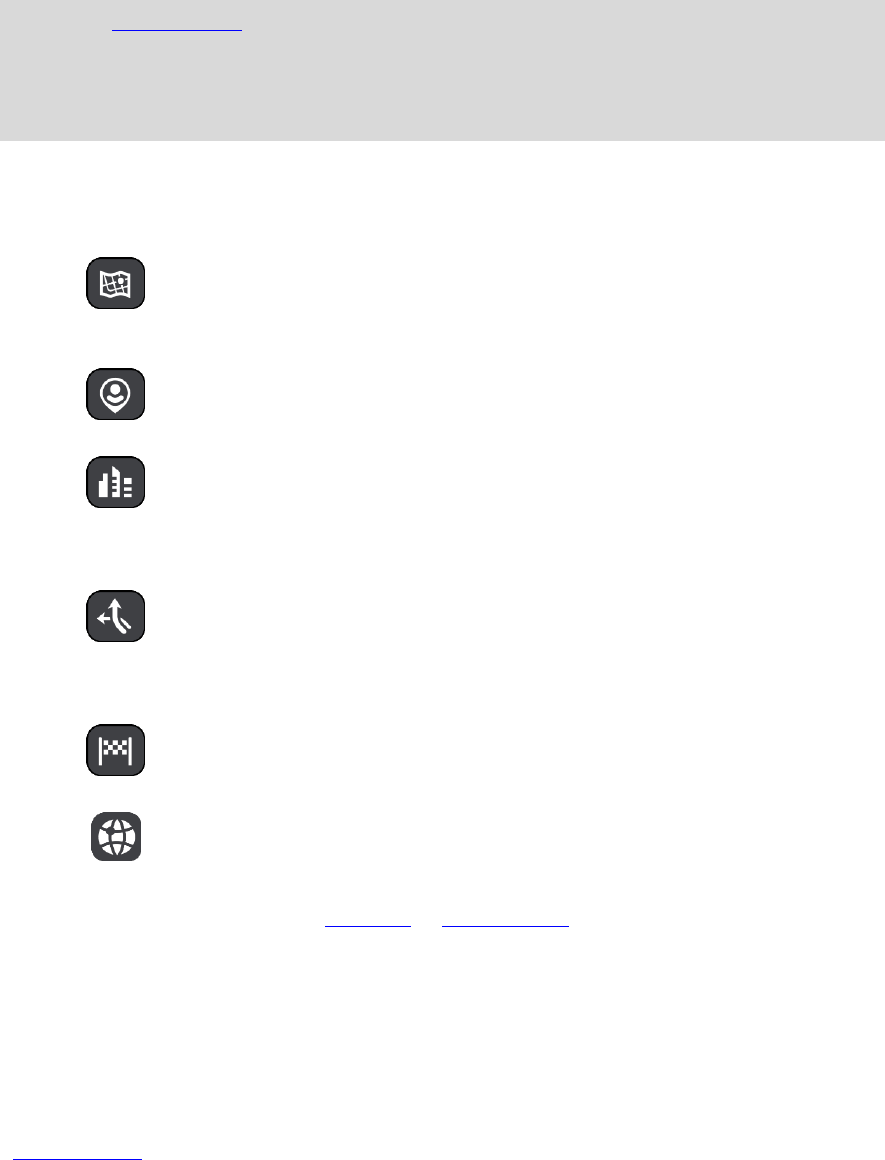
36
1. Back button.
Select this button to go back to the previous screen.
2. Search input box.
Enter your search term here. As you type, matching addresses and POIs are shown.
Tip: If you press and hold a letter key on the keyboard, you get access to extra characters if
they are available. For example, press and hold the letter "e" to access characters 3 e è é ê ë
and more.
Tip: To edit, select a word you have already typed to place the cursor. You can then insert or
delete characters.
3. Type of search.
By default, the whole of the current map is searched. Once you have used search, the last
search type you selected is used. Select this button to change the type of search to any of the
following:
Whole map
Select this option to search the whole of your current map with no
limit to the search radius. Your current location is the centre of the
search. The results are ranked by exact match.
Near me
Select this option to search with your current GPS location as the
search centre. The results are ranked by distance.
In town or city
Select this option to use a town or city as the centre for your search.
You need to enter the town or city name using the keyboard. When
you have selected the town or city from the results list, you can
search for an address or POI in that city.
Along route
When a route has been planned, you can select this option to search
along your route for a specific type of location, for example, petrol
stations. When prompted, enter the type of location and then select it
in the right-hand column to carry out the search.
Near destination
When a route has been planned, you can select this option to use your
destination as the centre for your search.
Latitude Longitude
Select this option to enter a pair of latitude longitude coordinates.
4. View button.
Select this button to return to the map view or guidance view.
5. 123?! button.
Select this button to use numbers and symbols on your keyboard. Select the =\< button to
toggle between the numbers and more symbols. Select the ABC button to go back to the general
keyboard.
6. Keyboard layout button.
Select this button to change your keyboard layout to another language. You can choose up to
four layouts from the list. If you have more than one layout selected, selecting the keyboard
layout button opens a pop-up so you can quickly swap between your selected keyboard layouts.
Press and hold this button to go directly to the list of all the layouts.
7. List/map button.
Select this button to switch between showing the results in a list or showing the results on the
map.
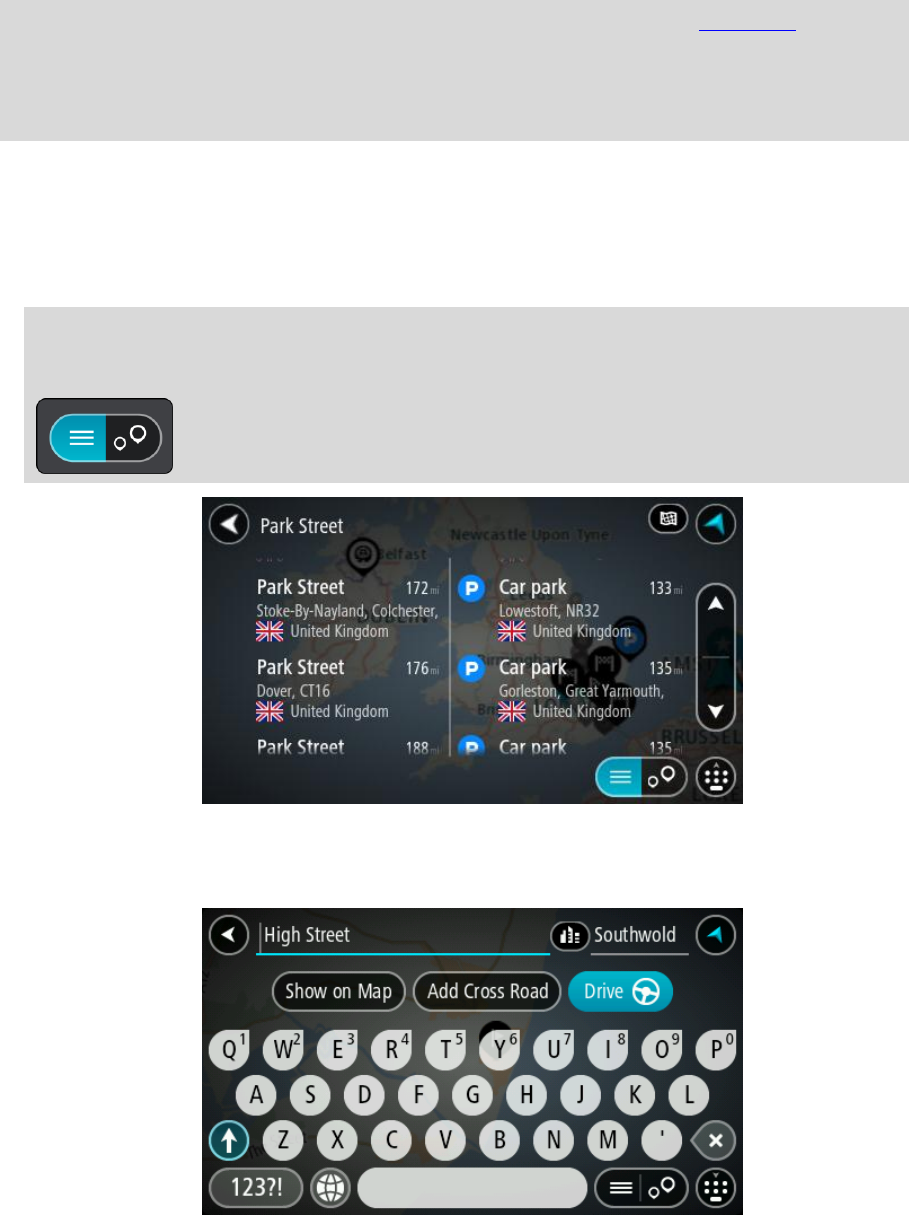
37
8. Show/hide keyboard.
Select this button to show or hide the keyboard.
Tip: Select the Shift key once to make the next letter you type upper case. Double tap the Shift
key to use Caps-Lock where all the letters you type are upper case. Select the Shift key once to
quit Caps-Lock.
Tip: To cancel a search, select the map/guidance view button in the top right-hand corner of the
screen.
Working with search results
Your search results are shown in two columns.
Address and city matches are shown in the left-hand column, and POIs, types of POIs and Places are
shown in the right-hand column.
Tip: To see more results, hide the keyboard or swipe the results list to scroll it.
Tip: You can switch between seeing the results on the map or in a list by selecting the
list/map button:
When you select an address from the list of search results, you can choose to show it on the map,
add a crossroad or plan a route to that chosen location. To get an exact address you can add the
house number.
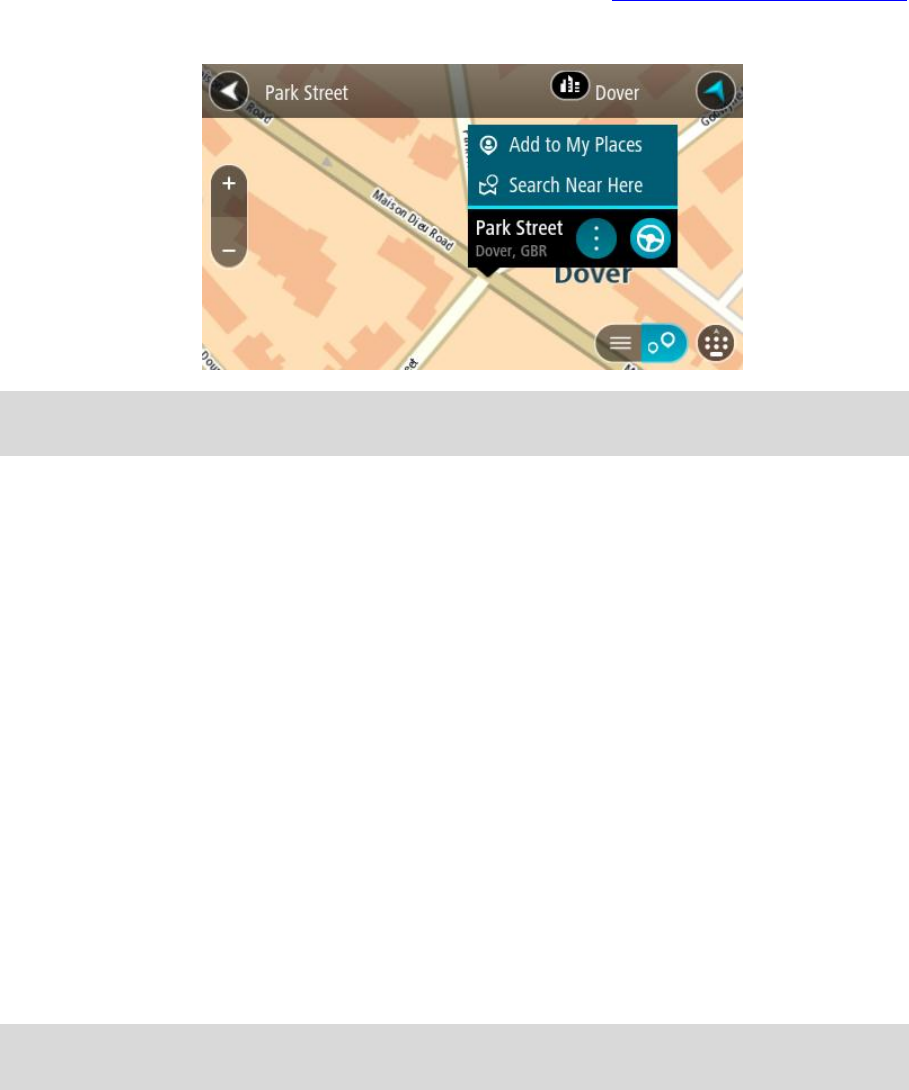
38
If you show the result on the map, you can use the pop-up menu to adding a location from My Places
or search near this location. If a route is already planned, you can add the location to your current
route.
Note: The best search results are shown on the map. When you zoom in, the lower ranked search
results are gradually shown.
About postcodes
When searching using a postcode, your results depend on the type of postcode used in the country
that you are searching in.
The following types of postcodes are used:
Postcodes that navigate you to a street or part of a street.
Postcodes that navigate you to an area comprising, for example, a single town, several villages
in a rural area or a district in a large city.
Postcodes for streets
Countries such as the Netherlands and the United Kingdom use this type of postcode. When you
search using this type of postcode, enter the postcode, then leave a space and then optionally enter
the house number. For example, "1017CT 35". Your device then plans a route to a specific house or
building on a specific street.
Postcodes for areas
Countries such as Germany, France and Belgium use this type of postcode. If you search using a
postcode for an area, your results include all the streets in a city district, the whole town, or the
villages within that postcode.
You may get results from multiple countries if you enter a postcode for an area.
Note: If you search using a postcode for an area, you will not get a specific address in your
results.
This type of postcode is still very useful in reducing the number of search results. For example, a
search for Neustadt in Germany returns a long list of possible results. Adding a space followed by
the postcode for an area narrows the results down to the Neustadt that you are looking for.
As another example, if you want to search in a city, enter a postcode for an area and select the city
centre you are searching for from the results.
About mapcodes
In countries where roads and houses have no names or addresses, you can use a mapcode instead. A
mapcode represents a location.
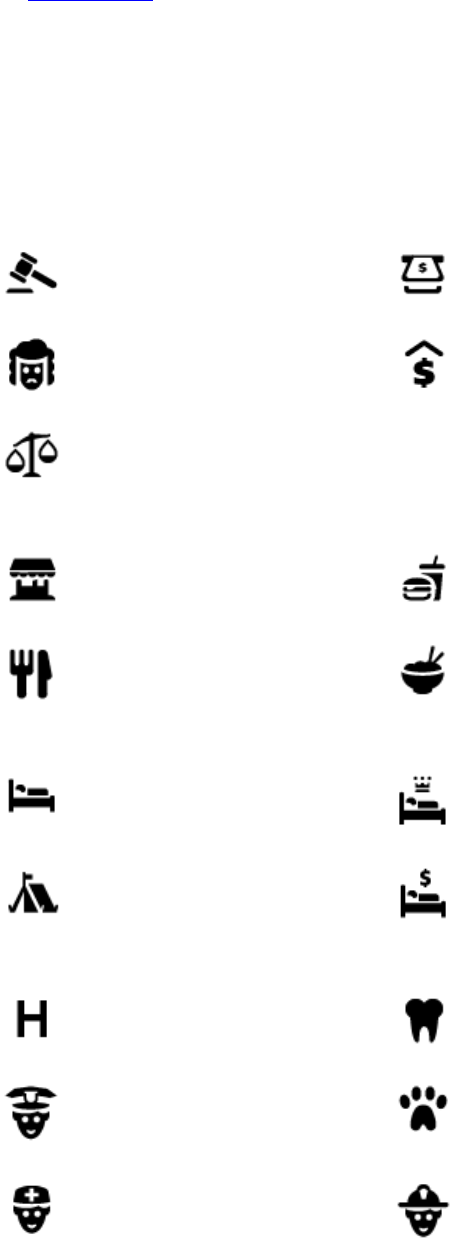
39
Every location on Earth, including those in the sea like islands and oil rigs, can be represented by a
mapcode. Mapcodes are short, and easy to recognise, remember and communicate. They are
precise to a few metres, which is good enough for every-day use.
Go to mapcode.com for instructions on how to find the mapcode for a location.
Mapcodes are more precise and more flexible than the address on a business card. You can choose a
location that you want to associate with your address, for example, the main entrance or the
entrance to a car park.
List of POI type icons
Legal and financial services
Court house
Cash dispenser
Legal - Solicitors
Financial institution
Legal - other services
Food services
Convenience store
Fast food restaurant
Restaurant
Chinese restaurant
Accommodation
Hotel or motel
Luxury hotel
Camping ground
Economy chain hotel
Emergency services
Hospital or polyclinic
Dentist
Police station
Veterinarian
Doctor
Fire station
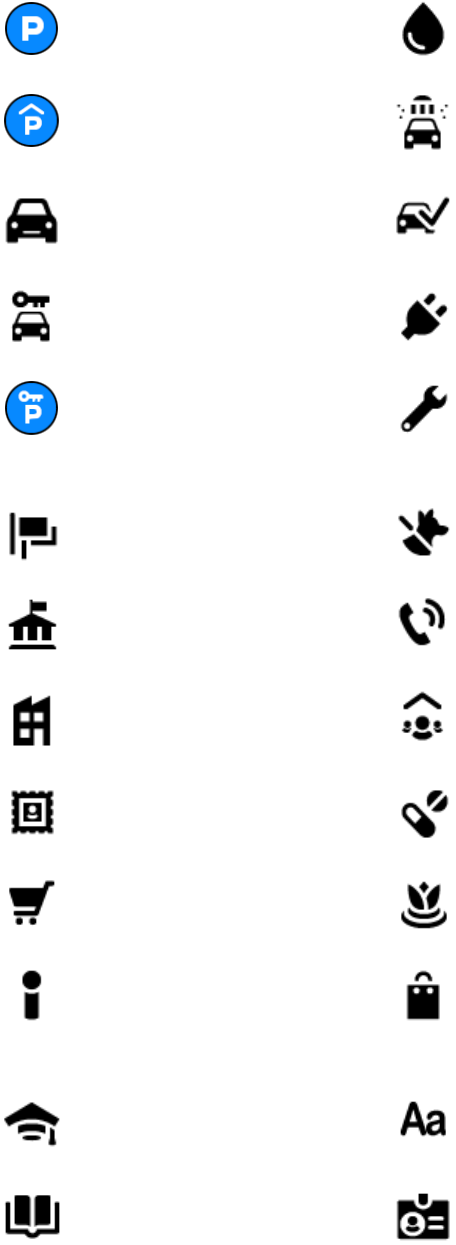
40
Car-related services
Outside parking
Petrol station
Parking garage
Car wash
Car dealer
Vehicle inspection centre
Rental car facility
Electrical car charging
point(s)
Rental car parking
Car repair facility
Other services
Embassy
Pet services
Government office
Telecommunication
Company
Community service
Post office
Pharmacy
Shopping centre
Beauty services
Tourist information office
Shop
Education
College or university
School
Library
Convention centre
Leisure
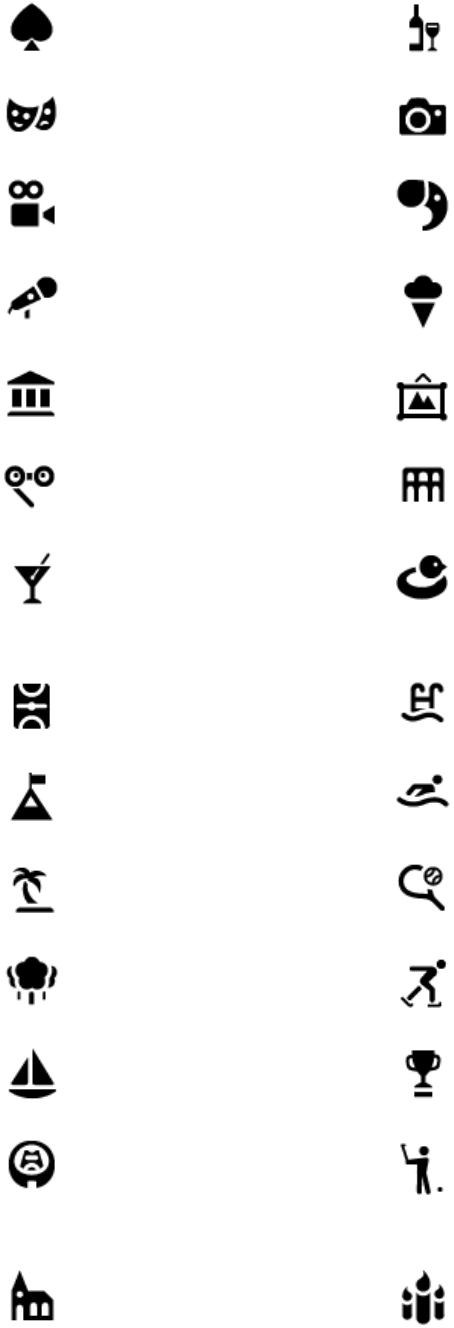
41
Casino
Winery
Theatre
Tourist attraction
Cinema
Zoo
Concert hall
Amusement park
Museum
Exhibition centre
Opera
Cultural centre
Nightlife
Leisure centre
Sport
Playing field
Swimming pool
Mountain peak
Water sports
Beach
Tennis court
Park or recreation area
Ice skating rink
Yacht basin or marina
Sports centre
Stadium
Golf course
Religion
Church
Place of worship
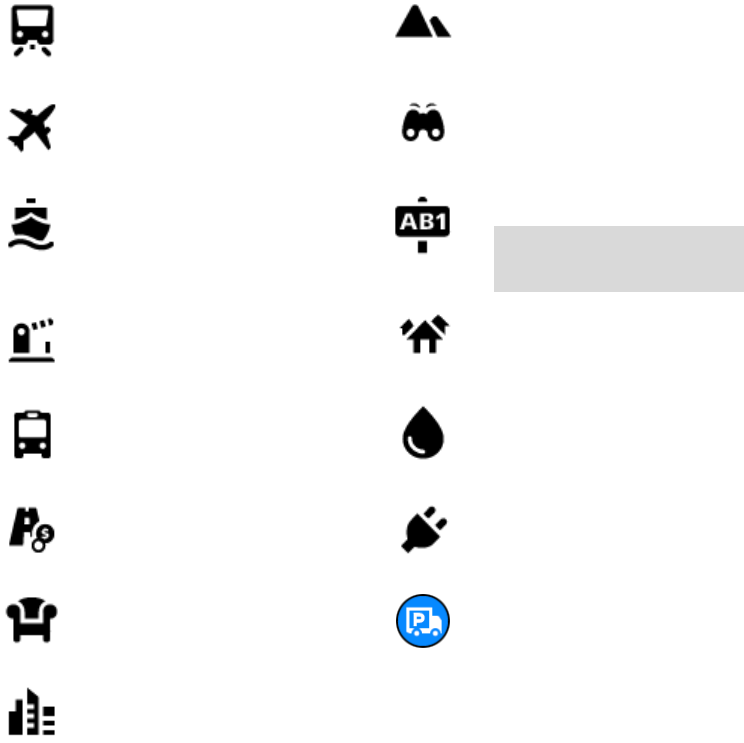
42
Travel
Railway station
Mountain pass
Airport
Scenic or panoramic view
Ferry terminal
Postcode
Note: Not used in all
countries.
Border crossing
Residential area
Bus station
Petrol station
Toll gate
Electrical car charging
stations
Rest area
Truck stop
City centre
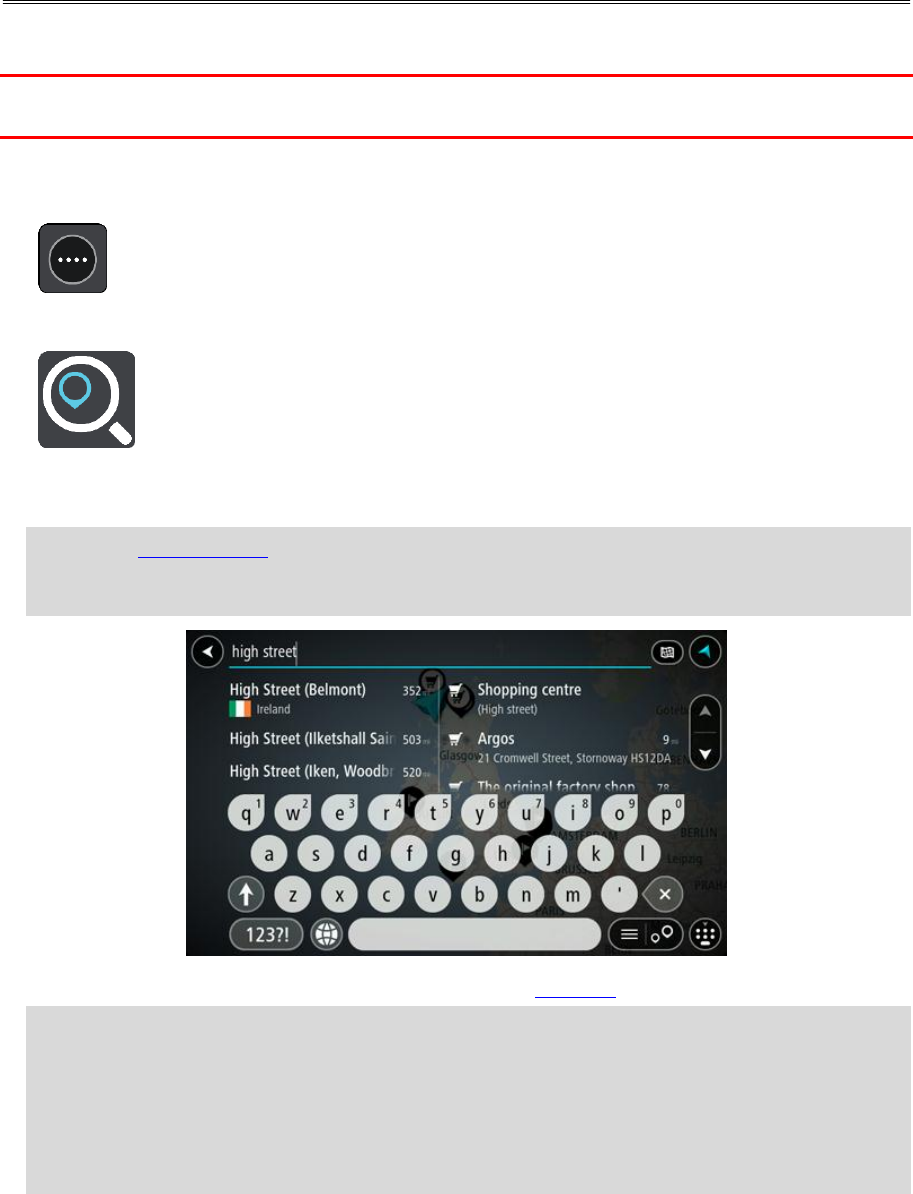
43
Planning a route to an address using search
Important: In the interest of safety and to avoid distractions while you are driving, you should
always plan a route before you start driving.
To plan a route to an address using search, do the following:
1. Select the Main Menu button to open the Main Menu.
2. Select Search.
The search screen opens with the keyboard showing.
3. Use the keyboard to enter the name of the place you want to plan a route to.
Tip: If you press and hold a letter key on the keyboard, you get access to extra characters if
they are available. For example, press and hold the letter "e" to access characters 3 e è é ê ë
and more.
You can search for an address, town, city, postcode or mapcode.
Tip: To search for a specific street in the United Kingdom or the Netherlands, type in a post-
code, then leave a space and then type in the house number. For example, "1017CT 35". For
other countries, postcodes are area-based and will give you a list of matching cities, towns and
streets in your search results.
Note: When searching, the whole map is searched. If you want to change how the search is
done, select the button to the right of the search box. You can then change where the search
is done, for example, to being along the route or in a city.
Planning a route
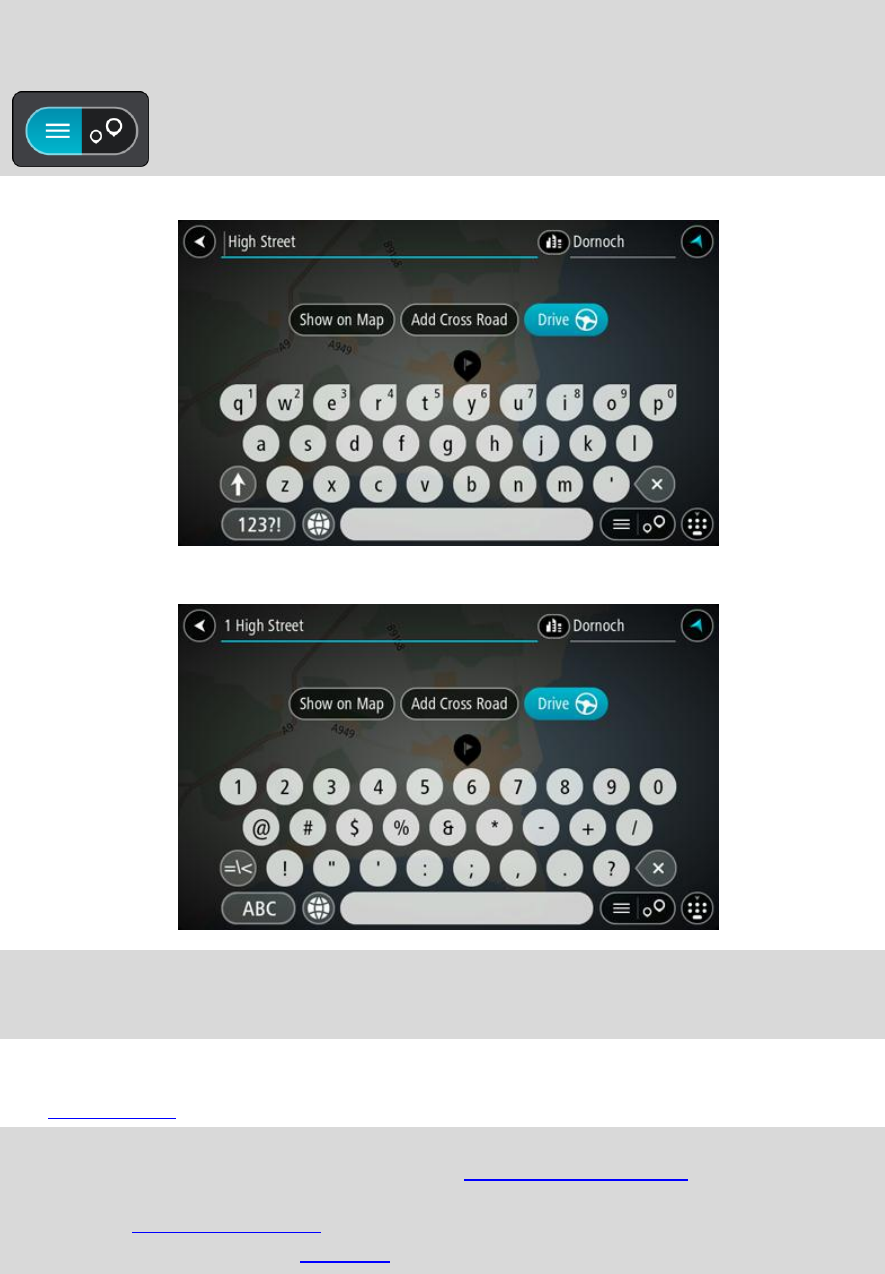
44
4. As you type the address, suggestions based on what you have entered are shown in columns. You
can continue typing or select a suggestion.
Tip: To see more results, hide the keyboard or swipe the results list to scroll it.
Tip: You can switch between seeing the results on the map or in a list by selecting the
list/map button:
5. Select an address suggestion.
6. Enter the house number if you have one and haven't entered it already.
Tip: If you enter a house number that is not found, then the number appears red. The nearest
house number that is found is shown in the Drive button. You can enter a new house number,
or you can select Drive to drive to the nearest house number.
7. Select Drive.
A route is planned and then guidance to your destination begins. As soon as you start driving,
the guidance view is shown automatically.
Tip: If your destination is in a different time zone, you see a plus (+) or a minus (-) sign and
the time difference in hours and half hours in the arrival information panel. The estimated
time of arrival is the local time at your destination.
Tip: You can add a stop to a route that you have already planned.
Tip: You can save a route using My Routes.
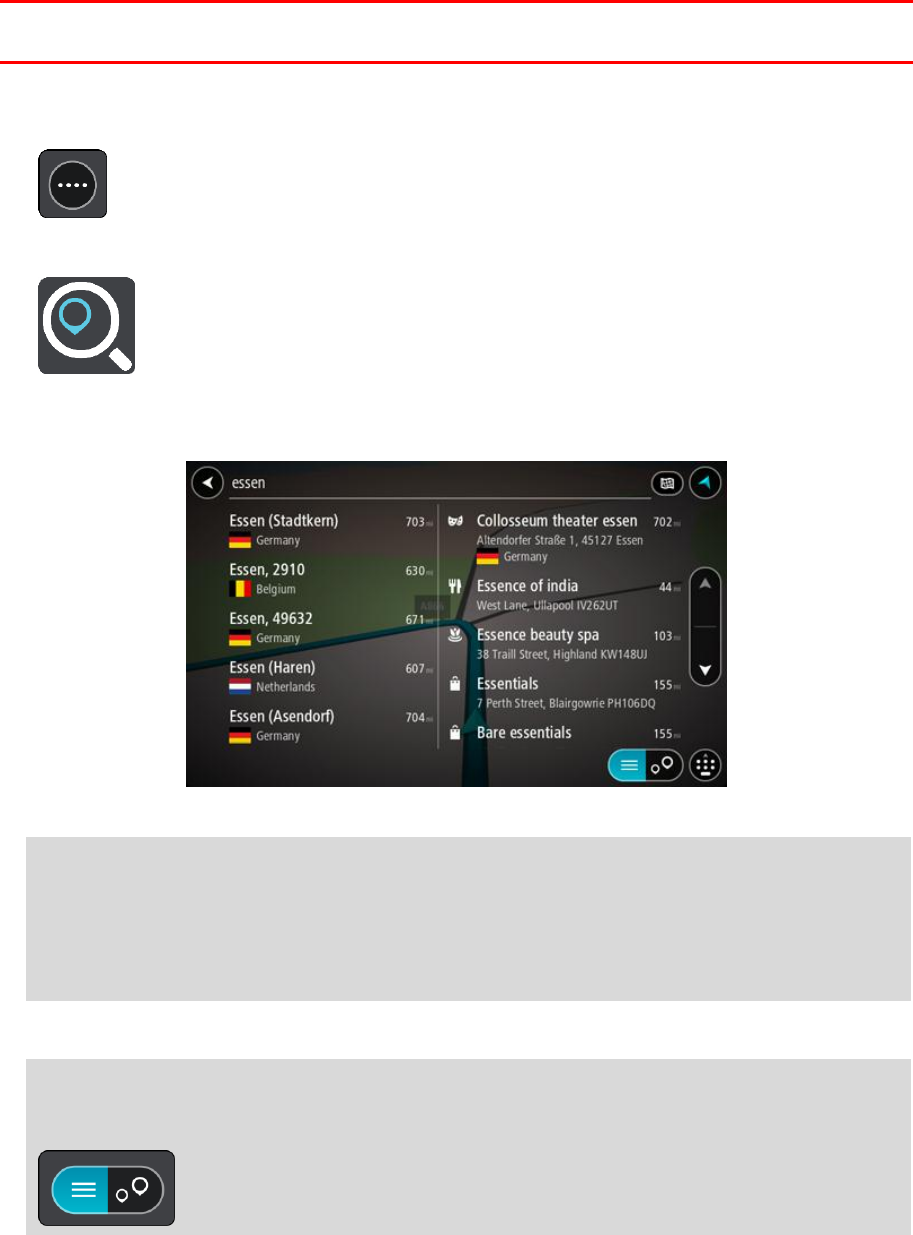
45
Planning a route to a city centre
Important: In the interest of safety and to avoid distractions while you are driving, you should
always plan a route before you start driving.
To plan a route to a city centre using search, do the following:
1. Select the Main Menu button to open the Main Menu.
2. Select Search.
The search screen opens with the keyboard showing.
3. Use the keyboard to enter the name of the city or town you want to plan a route to.
You can search for a town, city, or postcode.
Tip: To search for a specific city you can use the city's postcode or the country. For example,
searching for Essen will return many results. If you search for Essen 2910 or Essen Belgium then
that city will be at the top of the results. You can then search in the city.
Tip: When searching, the whole map is searched. If you want to change how the search is
done, select the button to the right of the search box. You can then change where the search
is done, for example, to being along the route or in a city.
4. As you type the address, suggestions based on what you have entered are shown in columns. You
can continue typing or select a suggestion.
Tip: To see more results, hide the keyboard or swipe the results list to scroll it.
Tip: You can switch between seeing the results on the map or in a list by selecting the
list/map button:
5. Select the city in the left-hand column.
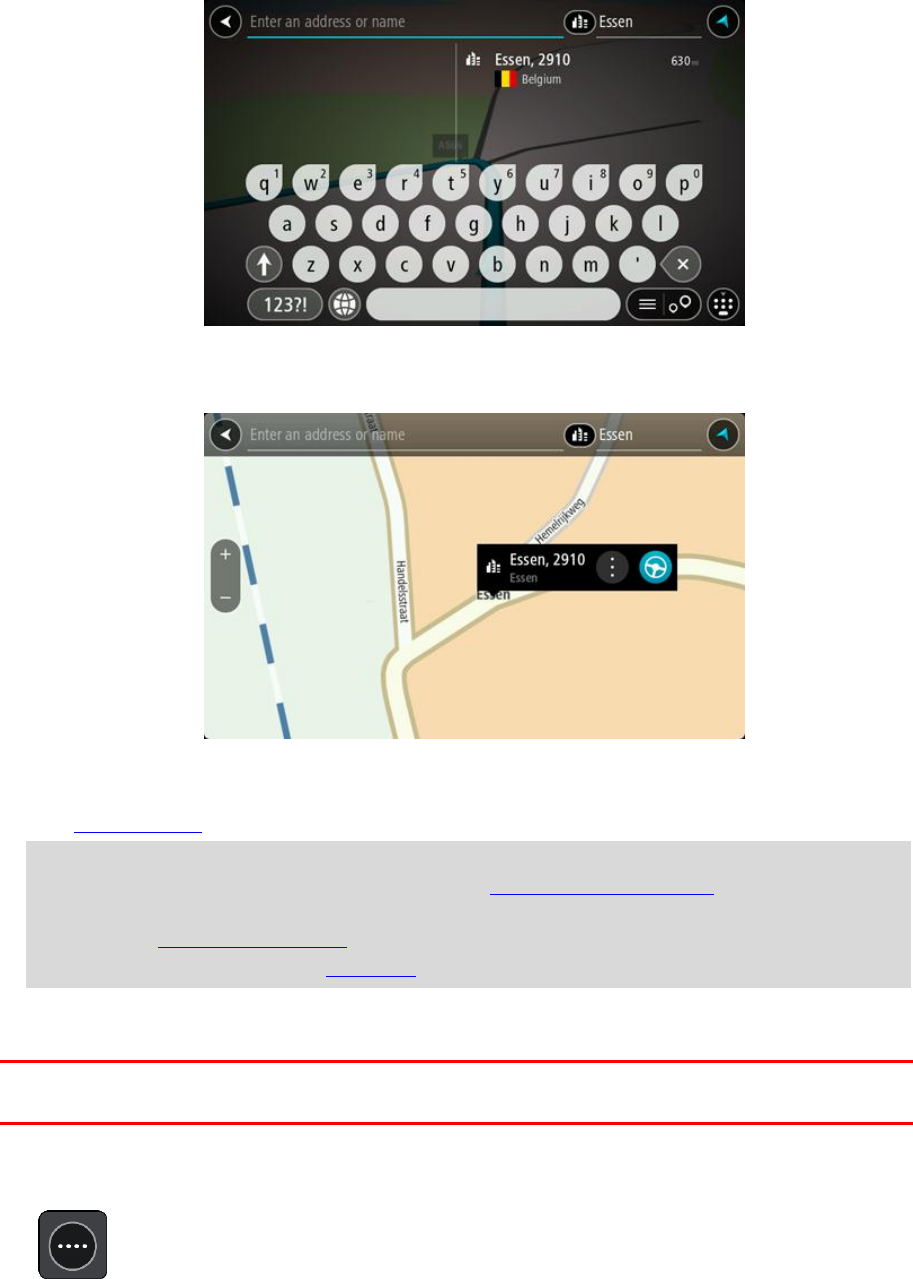
46
The city name is shown in the right side of the search input box, and the city centre POI is
shown below in the right-hand column.
6. Select the city centre POI.
The city centre location is shown on the map.
7. Select Drive.
A route is planned and then guidance to your destination begins. As soon as you start driving,
the guidance view is shown automatically.
Tip: If your destination is in a different time zone, you see a plus (+) or a minus (-) sign and
the time difference in hours and half hours in the arrival information panel. The estimated
time of arrival is the local time at your destination.
Tip: You can add a stop to a route that you have already planned.
Tip: You can save a route using My Routes.
Planning a route to a POI using search
Important: In the interest of safety and to avoid distractions while you are driving, you should
always plan a route before you start driving.
To plan a route to a POI type or a specific POI using search, do the following:
1. Select the Main Menu button to open the Main Menu.
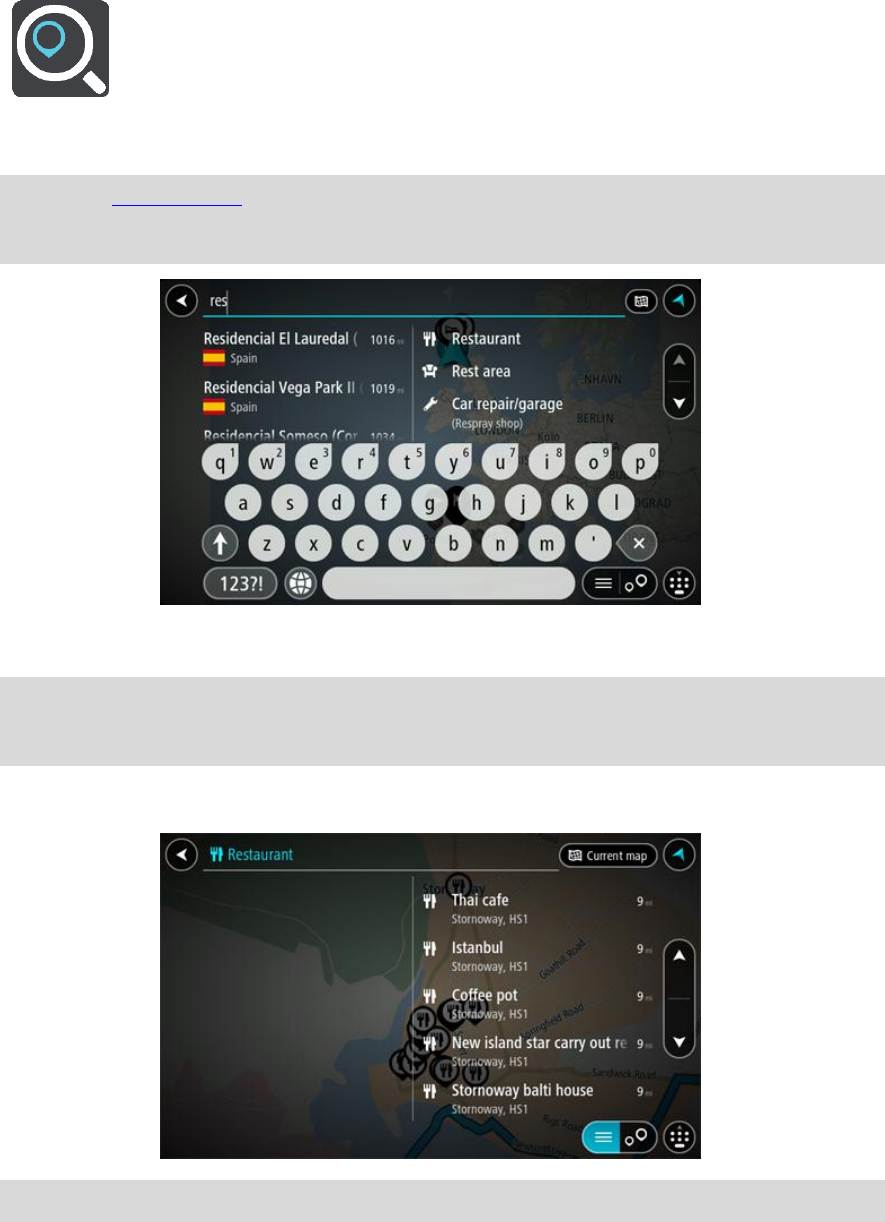
47
2. Select Search.
The search screen opens with the keyboard showing.
3. Use the keyboard to enter the name of the place you want to plan a route to.
Tip: If you press and hold a letter key on the keyboard, you get access to extra characters if
they are available. For example, press and hold the letter "e" to access characters 3 e è é ê ë
and more.
You can search for a POI (Point of Interest) type, such as a restaurant or tourist attraction.
Alternatively, you can search for a specific POI, for example "Rosie's Pizzeria".
Note: When searching, the whole map is searched. If you want to change how the search is
done, select the button to the right of the search box. You can then change where the search
is done, for example along the route or in a city.
4. As you type, suggestions based on what you have entered are shown in columns. You can
continue typing or select a suggestion.
Tip: To see more results, hide the keyboard or swipe the results list to scroll it.
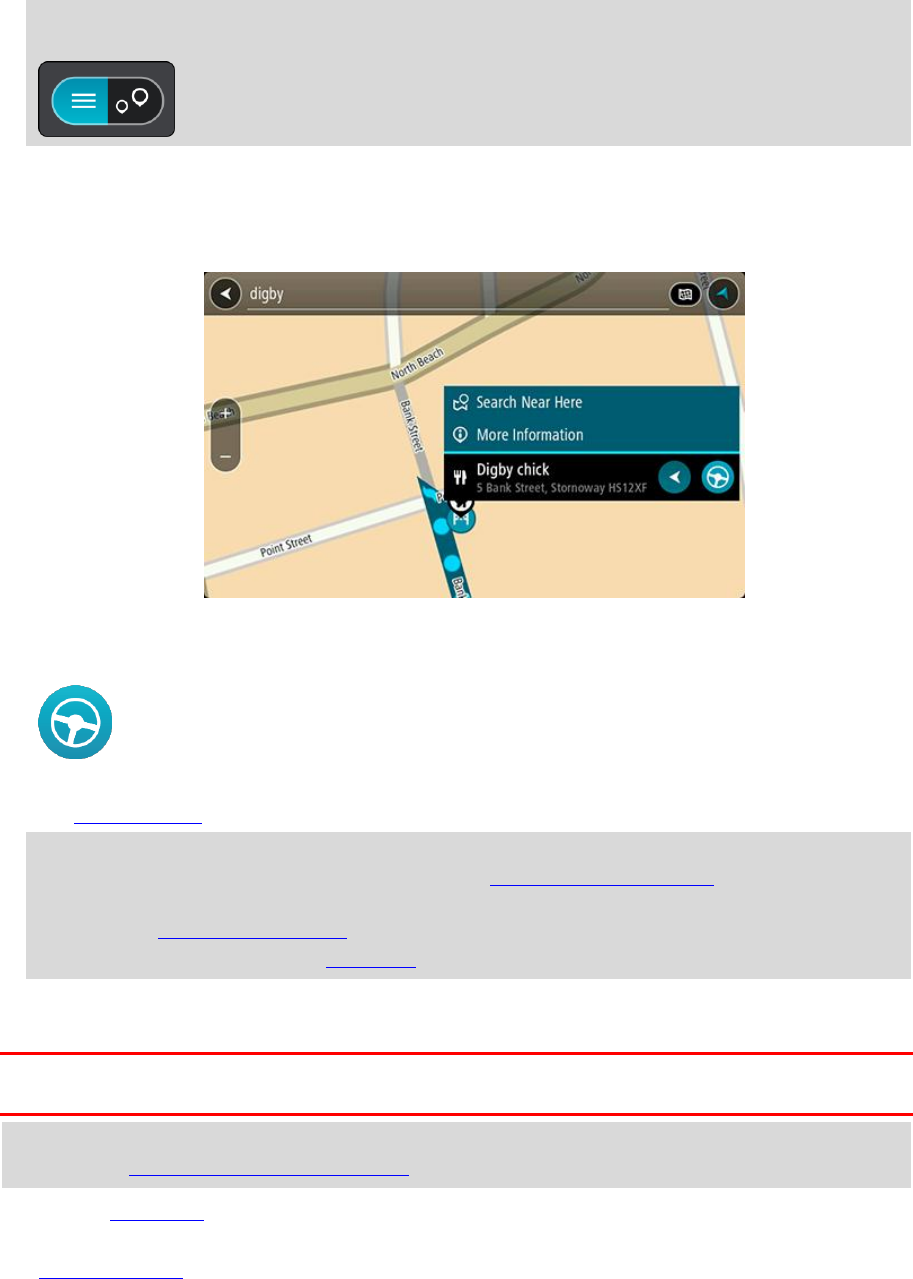
48
Tip: You can switch between seeing the results on the map or in a list by selecting the
list/map button:
5. Select a POI type or an individual POI. If you selected a POI type, select a POI.
The location is shown on the map.
6. To see more information about the POI, select the POI on the map and then select the pop-up
menu button. Select More Information on the pop-up menu.
You see more information about the POI such as the phone number, full address and email.
7. To plan a route to this destination, select the drive button:
A route is planned and then guidance to your destination begins. As soon as you start driving,
the guidance view is shown automatically.
Tip: If your destination is in a different time zone, you see a plus (+) or a minus (-) sign and
the time difference in hours and half hours in the arrival information panel. The estimated
time of arrival is the local time at your destination.
Tip: You can add a stop to a route that you have already planned.
Tip: You can save a route using My Routes.
Planning a route to a POI using online search
Important: In the interest of safety and to avoid distractions while you are driving, you should
always plan a route before you start driving.
Note: Searching online is only available on connected devices. To search online on your Rider,
you must be connected to TomTom services.
If you did a POI search but could not find the POI you were looking for, you can search TomTom
Places online. To find POIs by searching online, do the following:
1. Search for a POI using Search in the Main Menu.
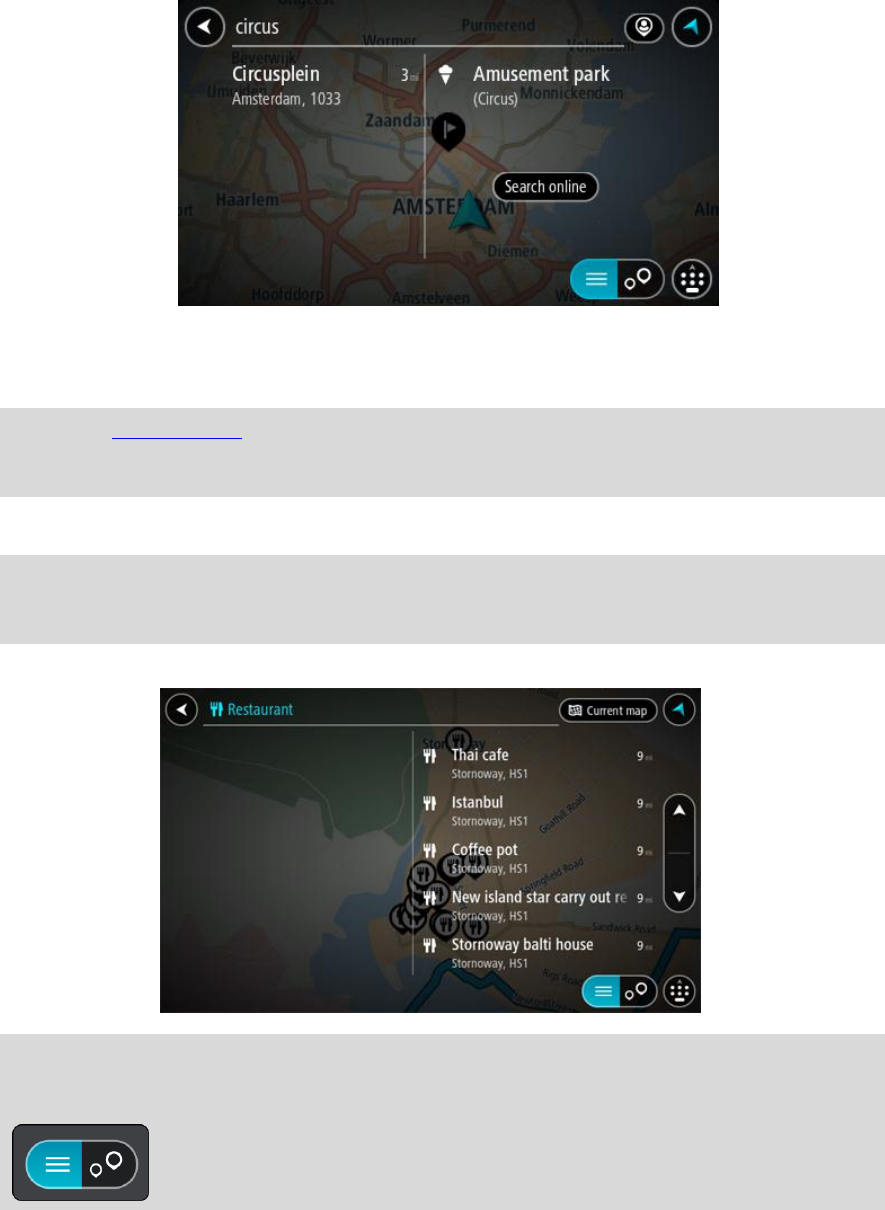
49
The search results are shown in two columns.
2. Select Search Places Online.
3. Use the keyboard to enter the name of the POI you want to find, then press the Search button
on the keyboard.
Tip: If you press and hold a letter key on the keyboard, you get access to extra characters if
they are available. For example, press and hold the letter "e" to access characters 3 e è é ê ë
and more.
You can search for a POI (Point of Interest) type, such as a restaurant or tourist attraction.
Alternatively, you can search for a specific POI, for example "Rosie's Pizzeria".
Note: When searching, you can search near your current location, in a town or city, or near
your destination. If you want to change how the search is done, select the button to the right
of the search box.
The search results are shown in a column.
Tip: To see more results, hide the keyboard or swipe the results list to scroll it.
Tip: You can switch between seeing the results on the map or in a list by selecting the
list/map button:
4. Select an individual POI from the list.
The location is shown on the map.
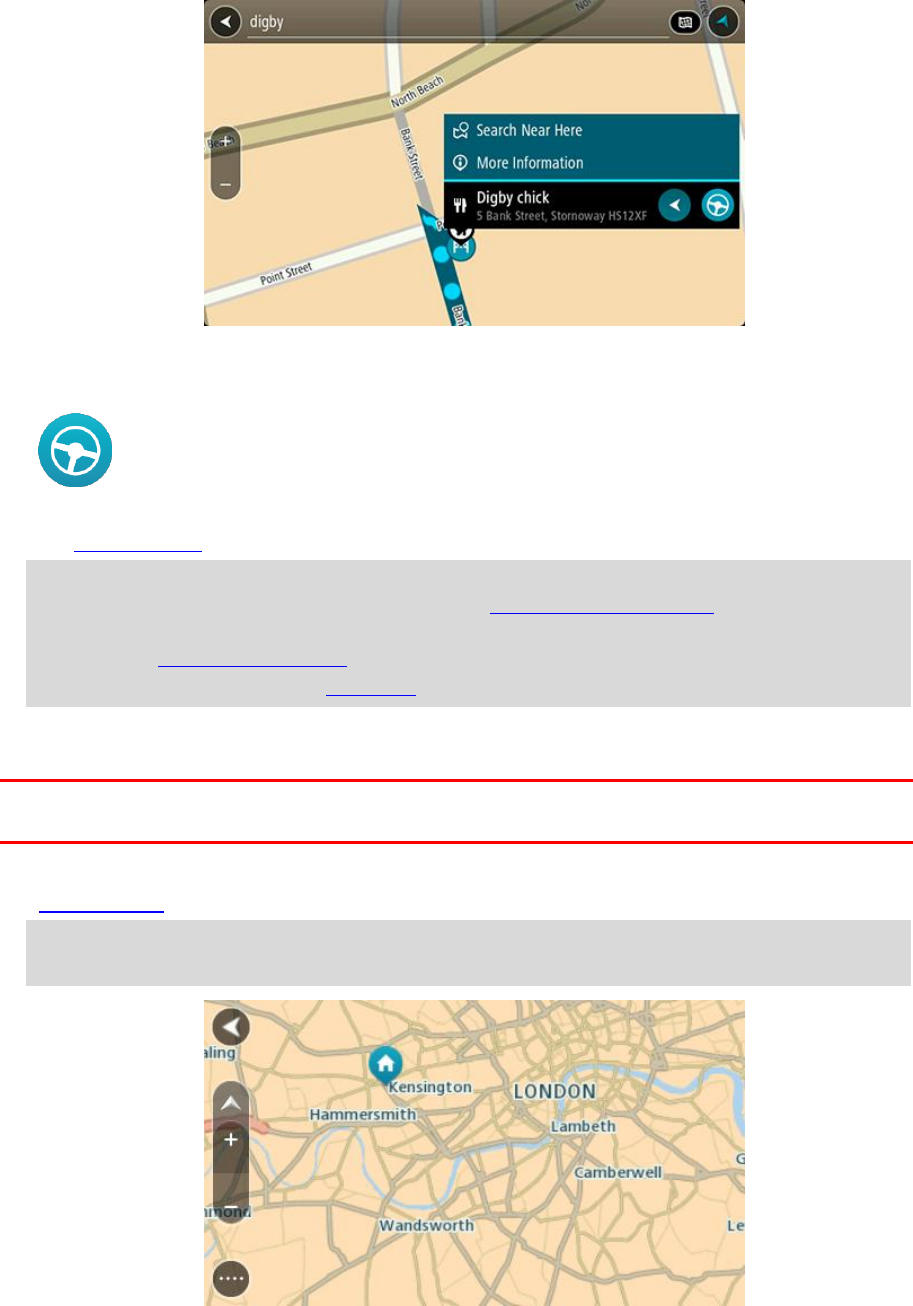
50
5. To see more information about the POI, select the POI on the map and then select the pop-up
menu button. Select More Information on the pop-up menu.
You see more information about the POI such as the phone number, full address and email.
6. To plan a route to this destination, select the drive button:
A route is planned and then guidance to your destination begins. As soon as you start driving,
the guidance view is shown automatically.
Tip: If your destination is in a different time zone, you see a plus (+) or a minus (-) sign and
the time difference in hours and half hours in the arrival information panel. The estimated
time of arrival is the local time at your destination.
Tip: You can add a stop to a route that you have already planned.
Tip: You can save a route using My Routes.
Planning a route using the map
Important: In the interest of safety and to avoid distractions while you are driving, you should
always plan a route before you start driving.
To plan a route using the map, do the following:
1. Move the map and zoom in until you can see the destination that you want to navigate to.
Tip: You can also select a map symbol to open the pop-up menu, then select the drive button
to plan a route to that location.
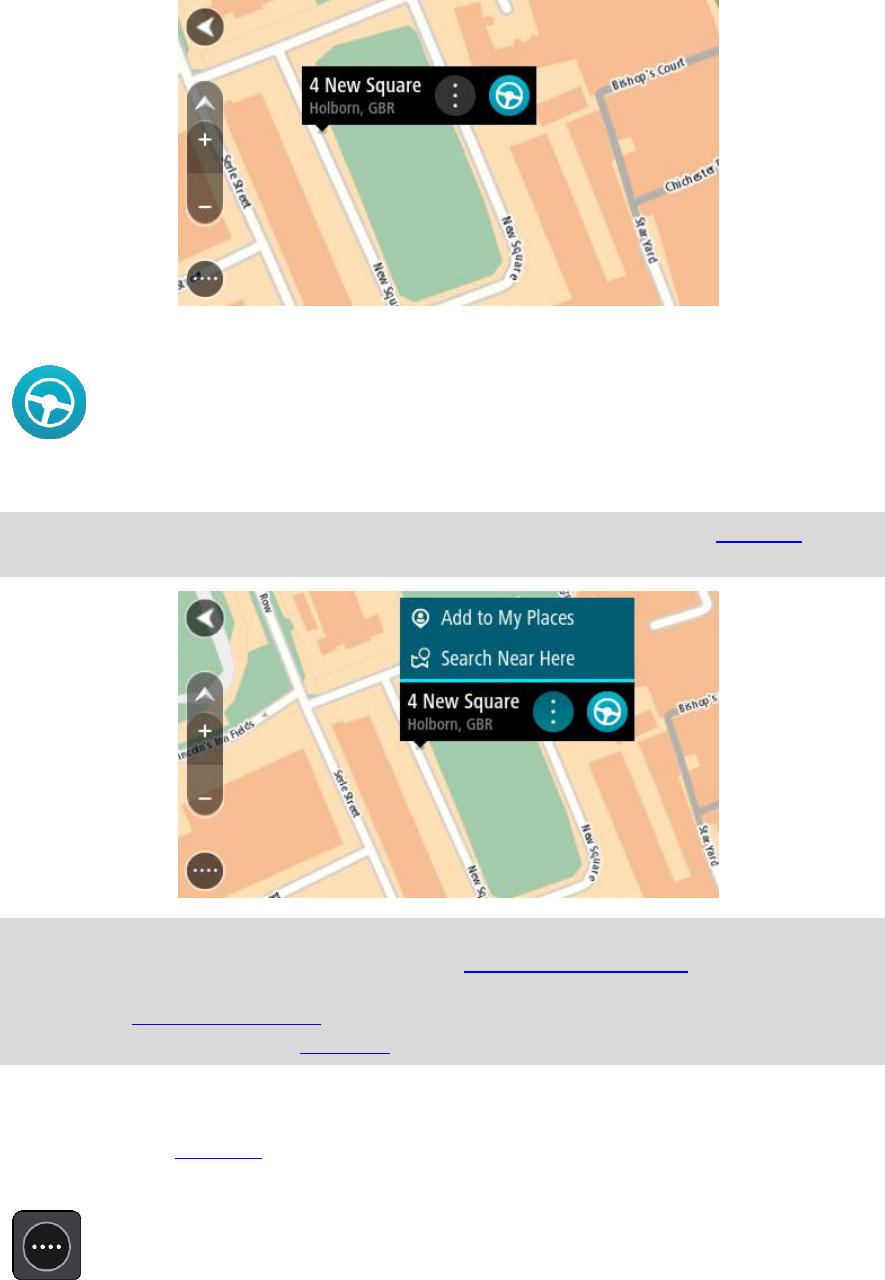
51
2. When you have found your destination on the map, select it by pressing and holding the screen
for about one second.
A pop-up menu shows the nearest address.
3. To plan a route to this destination, select the drive button:
A route is planned and then guidance to your destination begins. As soon as you start driving,
the guidance view is shown automatically.
Tip: You can use the location you selected in other ways, such as adding it to My Places, by
selecting the pop-up menu button.
Tip: If your destination is in a different time zone, you see a plus (+) or a minus (-) sign and
the time difference in hours and half hours in the arrival information panel. The estimated
time of arrival is the local time at your destination.
Tip: You can add a stop to a route that you have already planned.
Tip: You can save a route using My Routes.
Planning a route using My Places
To navigate to one of My Places from your current location, do the following:
1. Select the Main Menu button to open the Main Menu.
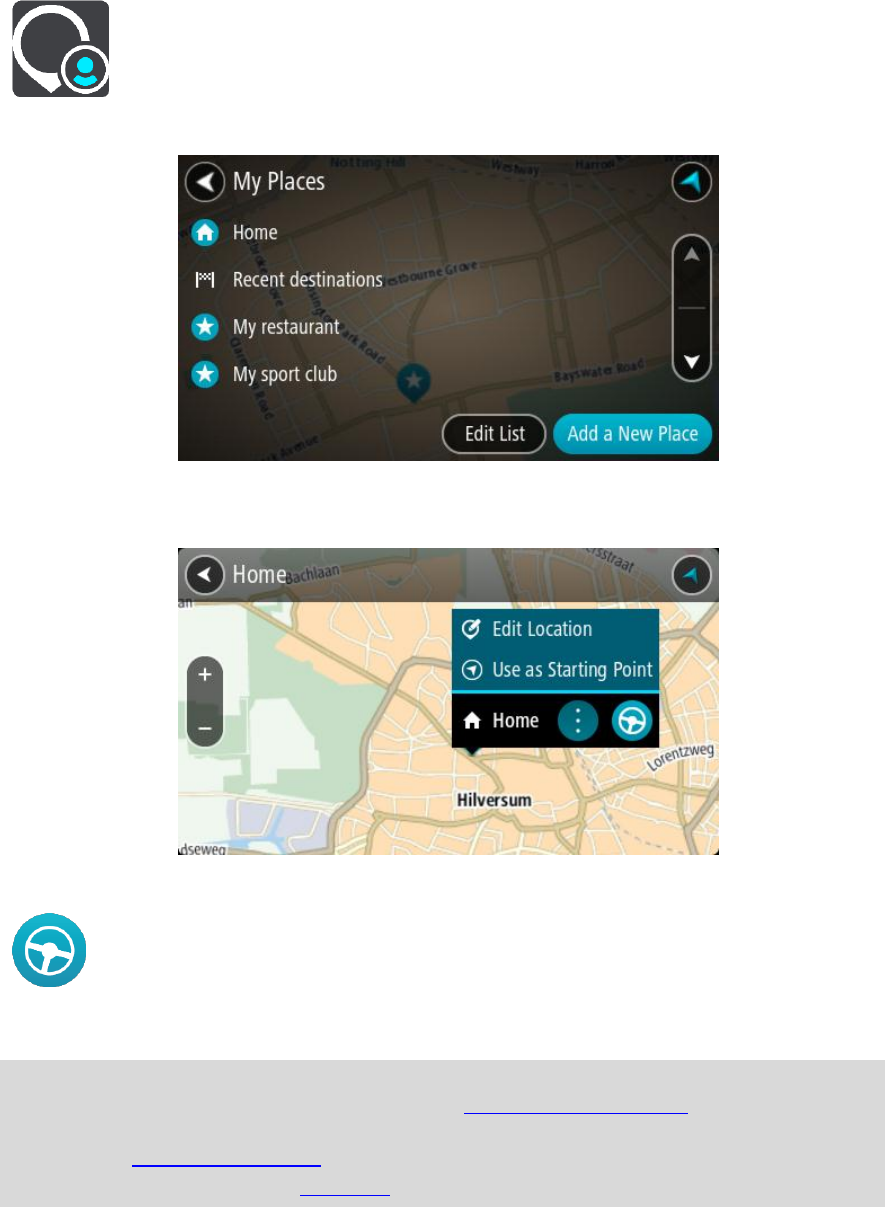
52
2. Select My Places.
A list of all your Places opens.
3. Select the Place you want to navigate to, for example Home.
Your chosen Place is shown on the map with a pop-up menu.
4. To plan a route to this Place, select the drive button:
A route is planned and then guidance to your destination begins. As soon as you start driving,
the guidance view is shown automatically.
Tip: If your destination is in a different time zone, you see a plus (+) or a minus (-) sign and
the time difference in hours and half hours in the arrival information panel. The estimated
time of arrival is the local time at your destination.
Tip: You can add a stop to a route that you have already planned.
Tip: You can save a route using My Routes.
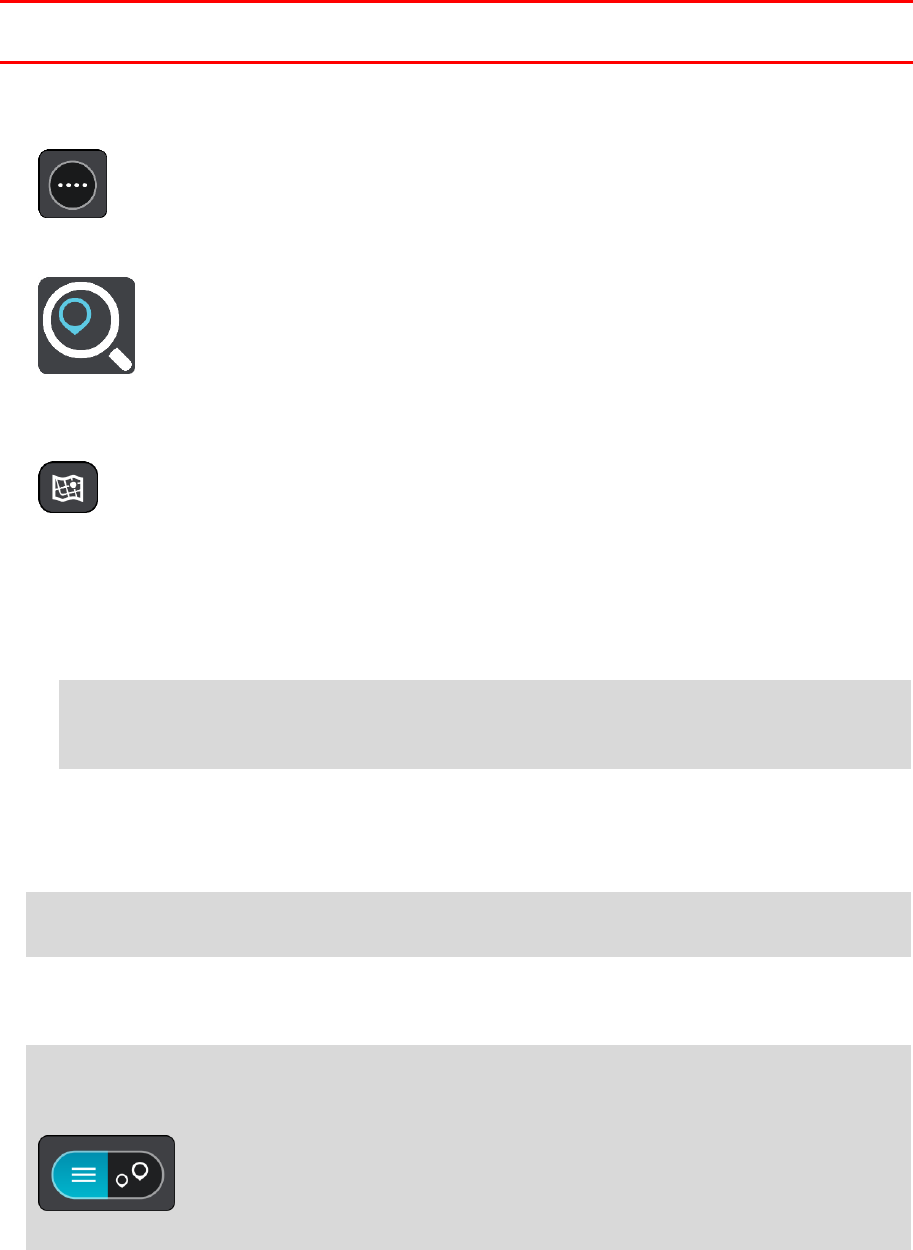
53
Planning a route using coordinates
Important: In the interest of safety and to avoid distractions while you are driving, you should
always plan a route before you start driving.
To plan a route using a pair of coordinates, do the following:
1. Select the Main Menu button to open the Main Menu.
2. Select Search.
The search screen opens with the keyboard showing.
3. Select the type of search button to the right of the search box.
4. Select Latitude Longitude.
5. Type in your pair of coordinates. You can enter any of these coordinate types:
Decimal values, for example:
N 51.51000 W 0.13454
51.51000 -0.13454
Tip: For decimal values you don't have to use a letter to indicate the latitude and longi-
tude. For locations west of the 0 meridian and locations south of the equator, use a minus
sign (-) before the coordinate.
Degrees, minutes and seconds, for example:
N 51°30′31″ W 0°08′34″
GPS standard coordinates, for example:
N 51 30.525 W 0 08.569
Note: The bar below the coordinates goes red if you enter coordinates that are not recognised
by your Rider.
6. As you type in the coordinates, suggestions are shown based on what you have entered. You can
continue typing or select a suggestion.
Towns and roads are shown on the left, POIs are shown on the right.
Tip: To see more results, hide the keyboard or swipe the results list to scroll it.
Tip: You can switch between seeing the results on the map or in a list by selecting the
list/map button:
7. Select a suggestion for your destination.
The location is shown on the map.
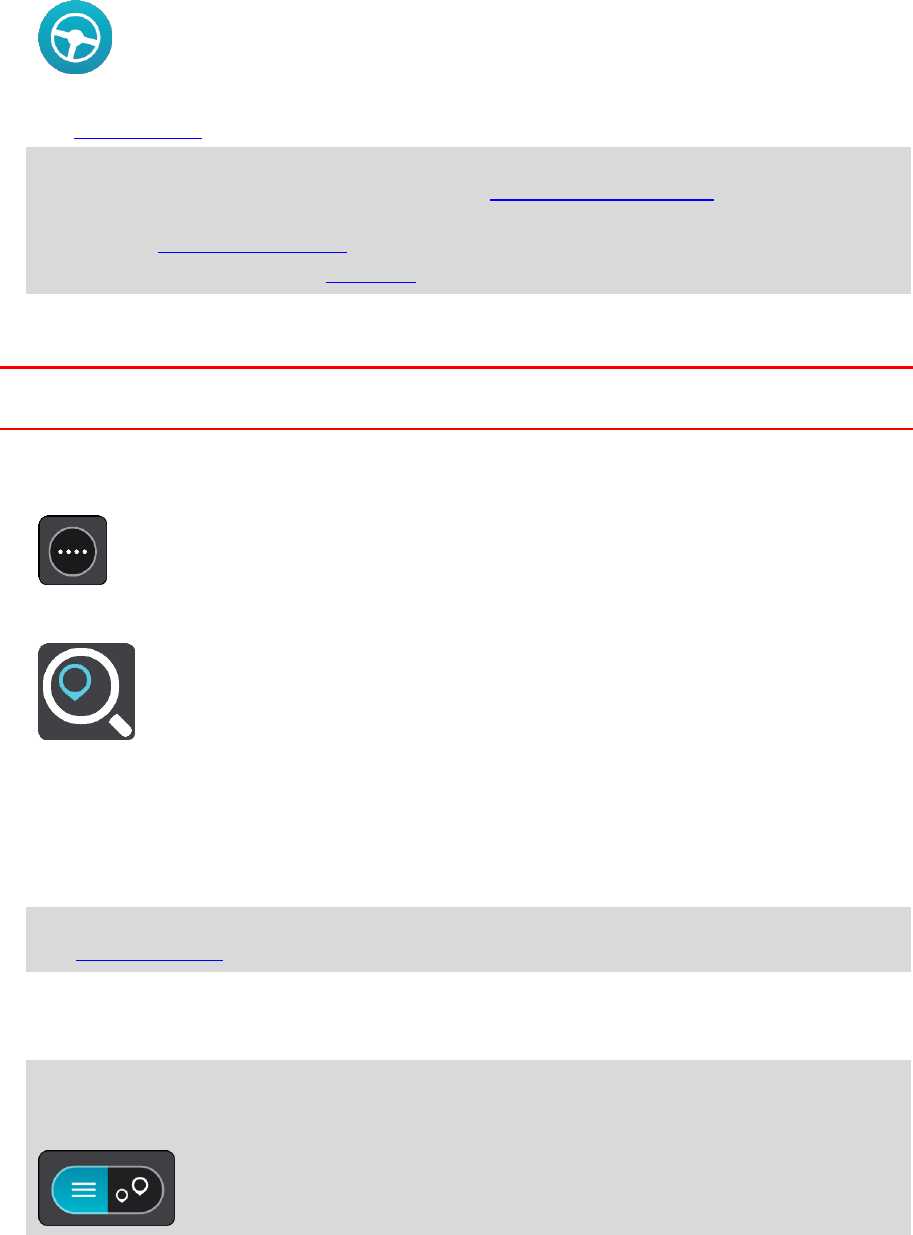
54
8. To plan a route to this destination, select the drive button:
A route is planned and then guidance to your destination begins. As soon as you start driving,
the guidance view is shown automatically.
Tip: If your destination is in a different time zone, you see a plus (+) or a minus (-) sign and
the time difference in hours and half hours in the arrival information panel. The estimated
time of arrival is the local time at your destination.
Tip: You can add a stop to a route that you have already planned.
Tip: You can save a route using My Routes.
Planning a route using a mapcode
Important: In the interest of safety and to avoid distractions while you are driving, you should
always plan a route before you start driving.
To plan a route using a mapcode, do the following:
1. Select the Main Menu button to open the Main Menu.
2. Select Search.
The search screen opens with the keyboard showing.
3. Type in your mapcode. You can enter any of these mapcode types:
International, for example, WH6SL.TR10.
Country-specific, for example, GBR 8MH.51.
Alternative country-specific, for example, GBR 28.Y6VH or GBR LDGZ.VXR.
Tip: All the mapcodes in this example are for the same location - Edinburgh Castle in the UK.
See About mapcodes for information on how to get a mapcode for a location.
4. As you type in the mapcode, suggestions are shown based on what you have entered. You can
continue typing or select a suggestion.
Towns and roads are shown on the left, POIs are shown on the right.
Tip: To see more results, hide the keyboard or swipe the results list to scroll it.
Tip: You can switch between seeing the results on the map or in a list by selecting the
list/map button:
5. Select a suggestion for your destination.
6. Select Drive.
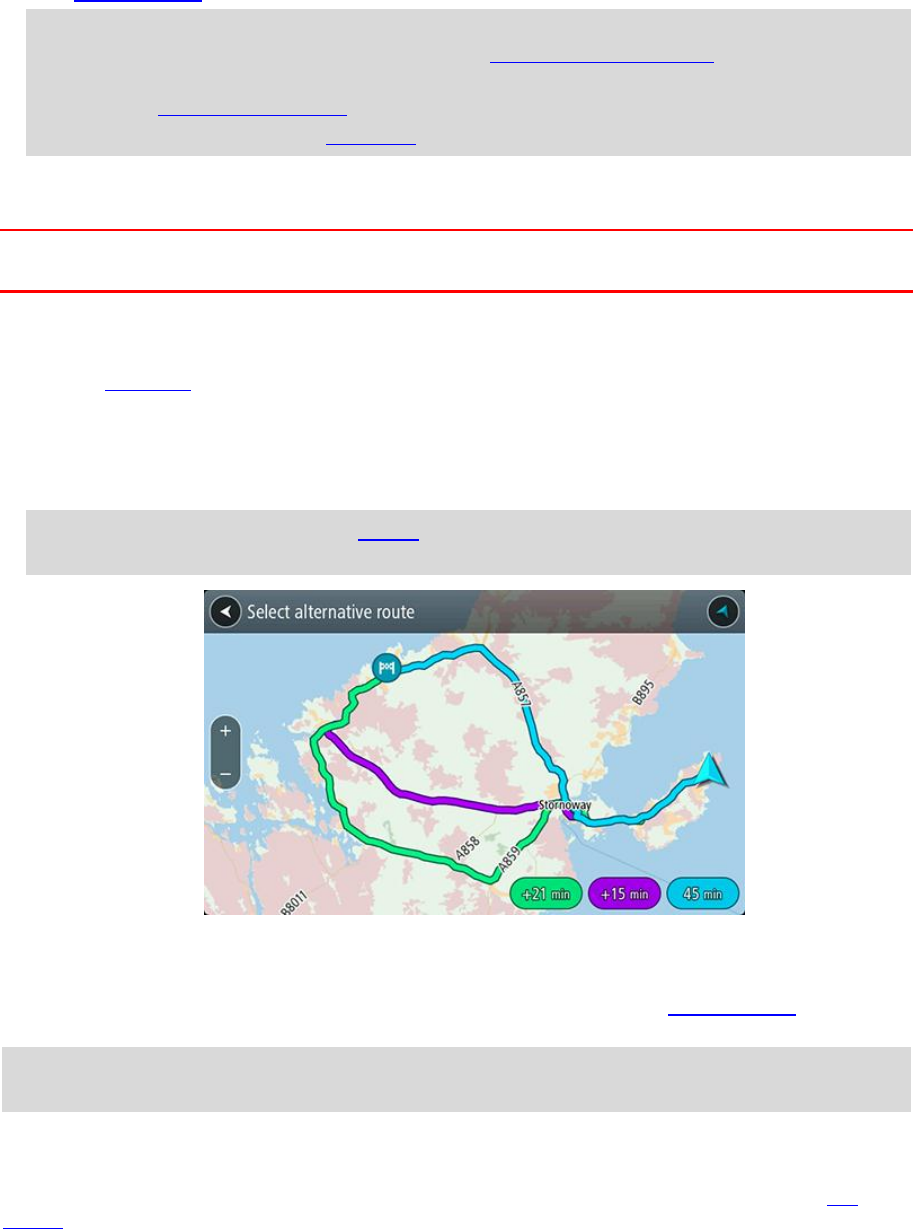
55
A route is planned and then guidance to your destination begins. As soon as you start driving,
the guidance view is shown automatically.
Tip: If your destination is in a different time zone, you see a plus (+) or a minus (-) sign and
the time difference in hours and half hours in the arrival information panel. The estimated
time of arrival is the local time at your destination.
Tip: You can add a stop to a route that you have already planned.
Tip: You can save a route using My Routes.
Finding an alternative route
Important: In the interest of safety and to avoid distractions while you are driving, you should
always plan a route before you start driving.
To find an alternative route, do the following:
1. Plan a route as usual.
2. On the map view, select the route itself.
3. Select the pop-up menu button to open the menu.
4. Select Alternative Route and then select Find alternative.
Up to three alternative routes are shown on the map view. Each alternative route shows the
difference in travel time in a balloon.
Tip: Information from the Lifetime Traffic service is used when calculating alternative routes.
Any route that is 50% longer in time than the original route is not shown.
5. Select your chosen route by tapping on the time balloon.
6. Select Let's go.
7. Guidance to your destination begins. As soon as you start driving, the guidance view is shown
automatically.
Note: You can also find alternative routes by selecting Current Route in the main menu,
followed by Find Alternative.
Planning a route in advance
You can plan a route in advance before you drive it. You can save the route as part of your My
Routes list.
To plan a route in advance, do the following:
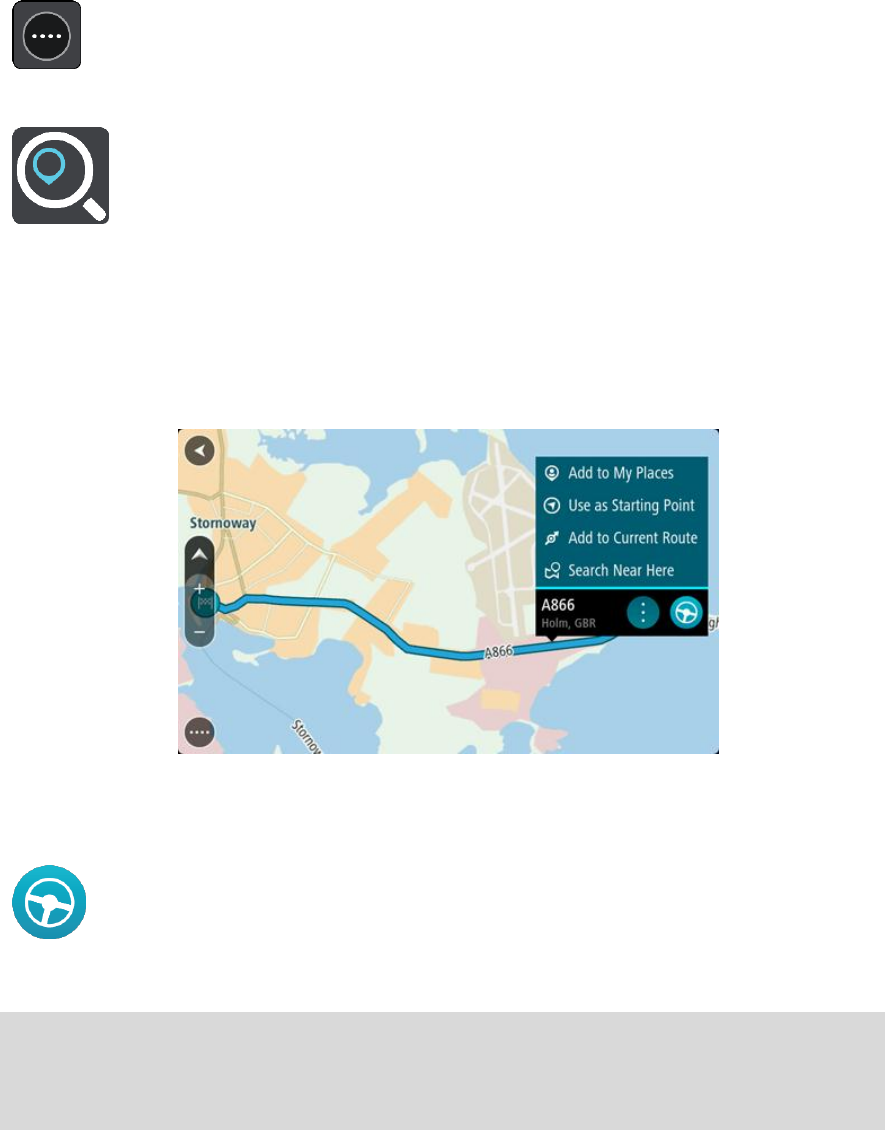
56
1. Select the Main Menu button to open the Main Menu.
2. Select Search.
The search screen opens with the keyboard showing.
3. Use the keyboard to enter the name of the location you want to use as a starting point.
4. Select an address or POI suggestion.
5. Select Show on Map.
6. Select the pop-up menu button.
A pop-up menu shows a list of options.
7. Select Use as Starting Point.
8. Repeat the search steps to choose your destination, and then select the drive button in the
pop-up menu:
Your route is planned using your chosen starting point and destination. The estimated time of
arrival is shown at the top of the route bar.
Tip: If you don't want to use search to choose your starting point and destination, go to the
map view and press and hold to select a location.
Tip: Stops, POIs, Places and the destination can all be selected as starting points using their
pop-up menus.
Changing the starting point to be your current location
1. Select the starting point of the route in the map view.
2. Select the pop-up menu button.
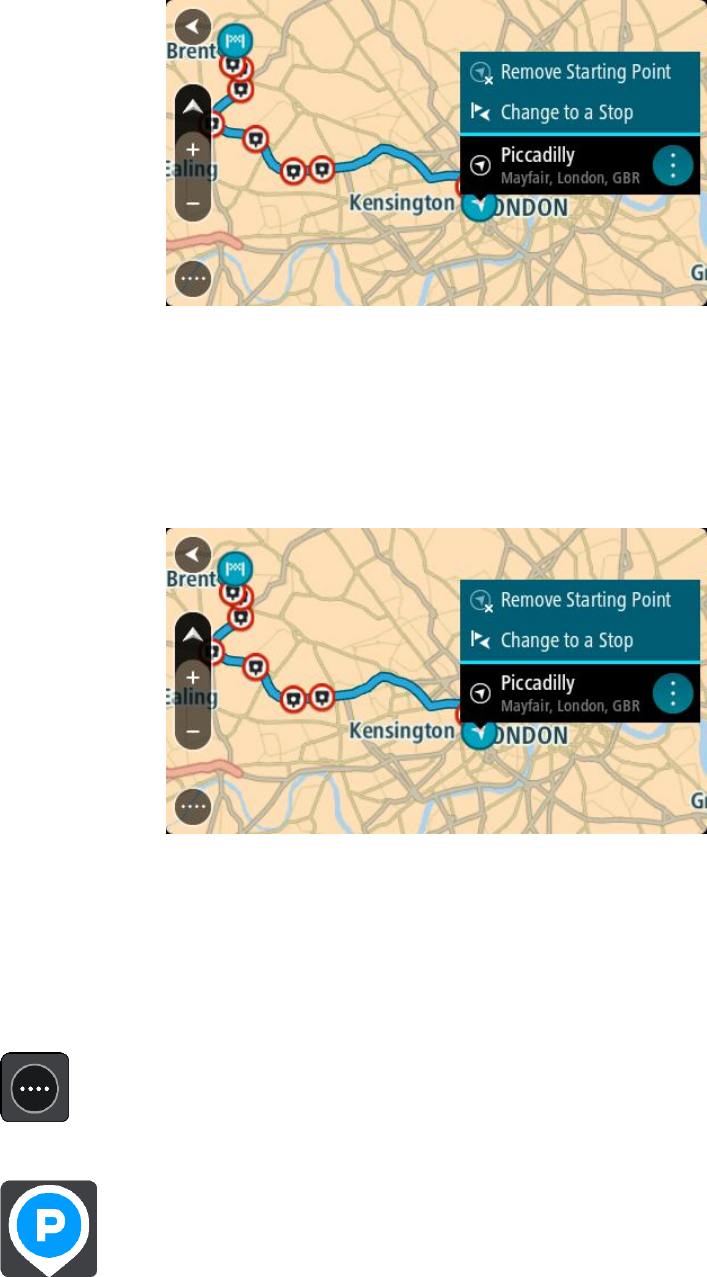
57
A pop-up menu shows a list of options.
3. Select Remove Starting Point.
Your route is replanned with your current location as the starting point.
Changing the starting point into a stop
1. Select the starting point on the route in the map view.
2. Select the pop-up menu button.
A pop-up menu shows a list of options.
3. Select Change to a Stop.
Your route is replanned with the starting point changed into a stop.
Finding a car park
To find a car park, do the following:
1. Select the Main Menu button to open the Main Menu.
2. Select Parking.
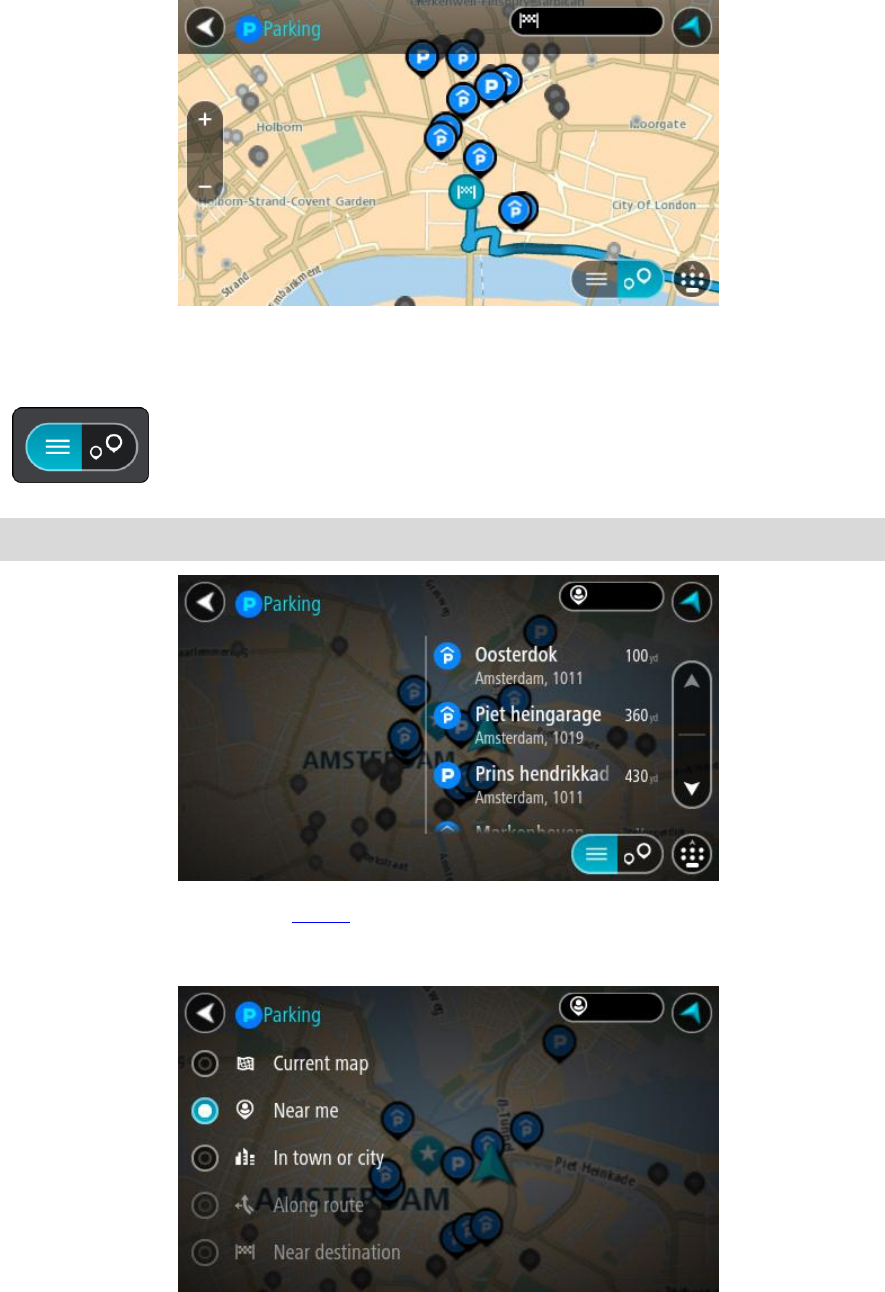
58
The map opens showing the locations of car parks.
If a route is planned, the map shows car parks near your destination. If a route isn't planned,
the map shows car parks near your current location.
You can change the screen to show a list of car parks by pressing this button:
You can select a car park from the list to locate it on the map.
Tip: You can scroll down the list of results using the scroll bar on the right side of the screen.
If you want to change how the search is done, select the button to the right of the search box.
You can then change where the search is carried out, for example, to search near you or the
whole map.
3. Select a car park from the map or the list.
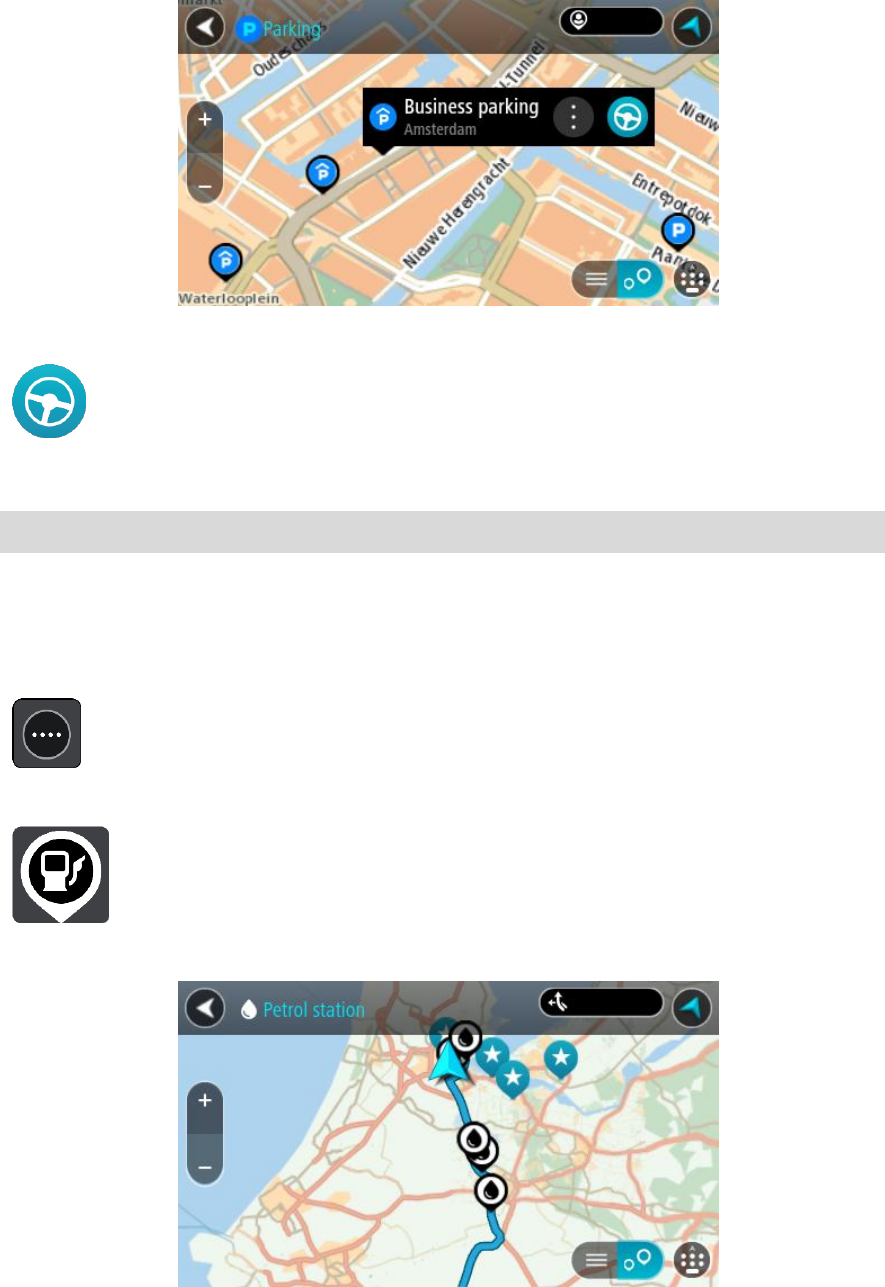
59
A pop-up menu opens on the map showing the name of the car park.
4. To plan a route to your chosen car park, select the drive button:
A route is planned and then guidance to your destination begins. As soon as you start driving,
the guidance view is shown automatically.
Tip: You can add a car park as a stop on your route by using the pop-up menu.
Finding a petrol station
To find a petrol station, do the following:
1. Select the Main Menu button to open the Main Menu.
2. Select Petrol Station.
The map opens showing the locations of petrol stations.
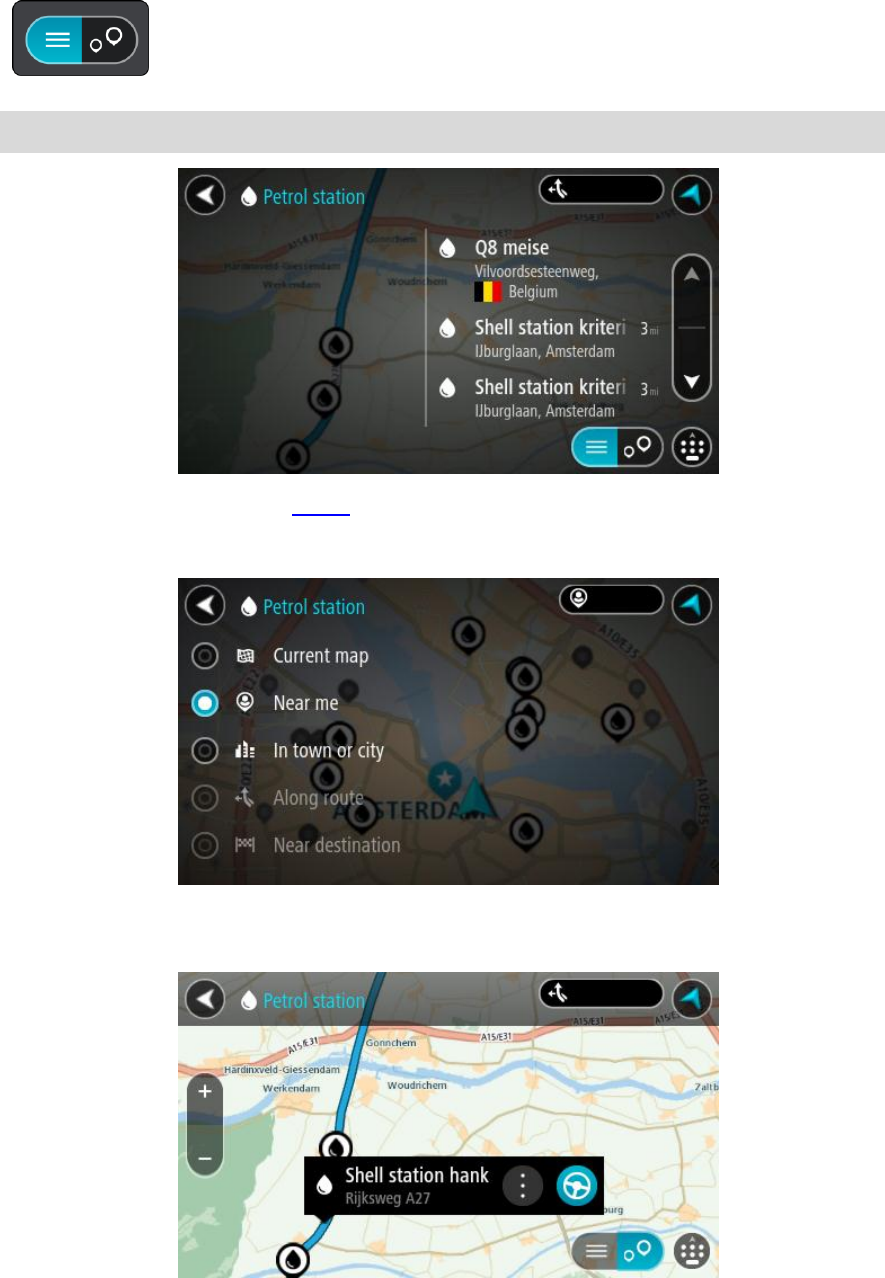
60
If a route is planned, the map shows petrol stations along your route. If a route isn't planned,
the map shows petrol stations near your current location.
You can change the screen to show a list of petrol stations by pressing this button:
You can select a petrol station from the list to locate it on the map.
Tip: You can scroll down the list of results using the scroll bar on the right side of the screen.
If you want to change how the search is done, select the button to the right of the search box.
You can then change where the search is carried out, for example, to search near you or the
whole map.
3. Select a petrol station from the map or the list.
A pop-up menu opens on the map showing the name of the petrol station.

61
4. To plan a route to your chosen petrol station, select the drive button:
A route is planned and then guidance to your destination begins. As soon as you start driving,
the guidance view is shown automatically.
Tip: You can add a petrol station as a stop on your route by using the pop-up menu. A petrol
station that is a stop on your route has a blue icon.
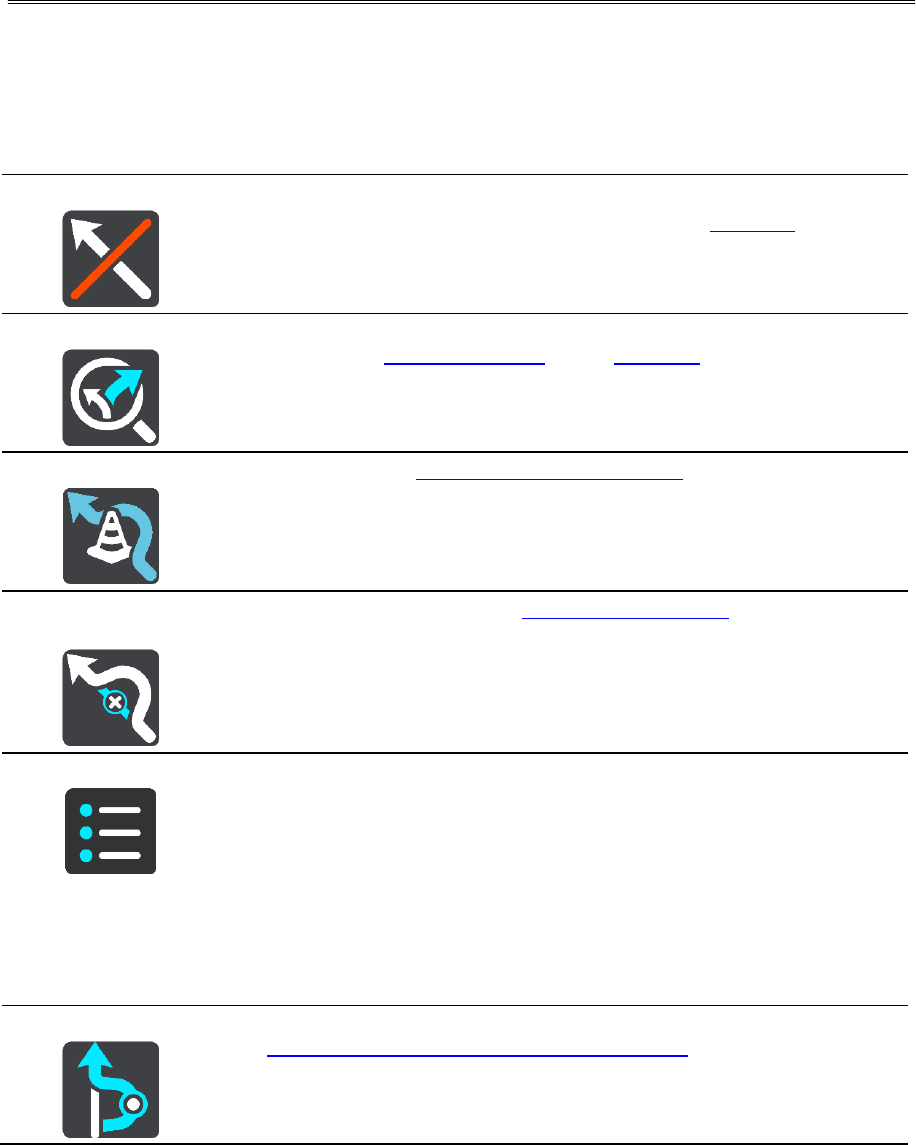
62
The Current Route Menu
When you have planned a route, select the Current Route button in the Main Menu to open the
Current Route Menu.
The following buttons are available in the Current Route Menu:
Clear Route
Select this button to clear the currently planned route.
The Current Route Menu closes and you return to the map view.
Find Alternative
You see this button when you have planned a route. Select this button to
show up to three alternative routes on the map view.
Avoid Blocked Road
Select this button to avoid an unexpected obstacle that is blocking the
road on your route.
Avoid Toll Roads
and More
Select this button to avoid some types of route features that are on your
currently planned route. These include ferries, toll roads and unpaved
roads.
Show Instructions
Select this button to see a list of turn-by-turn text instructions for your
planned route.
The instructions include the following:
The street name.
Up to two road numbers shown in road shields whenever available.
An instruction arrow.
An instruction description.
The distance between two consecutive instructions.
Exit number.
Add Stop to Route
Select this button to add a stop to your currently planned route. You can
also add a stop to your route directly from the map.
Changing your route
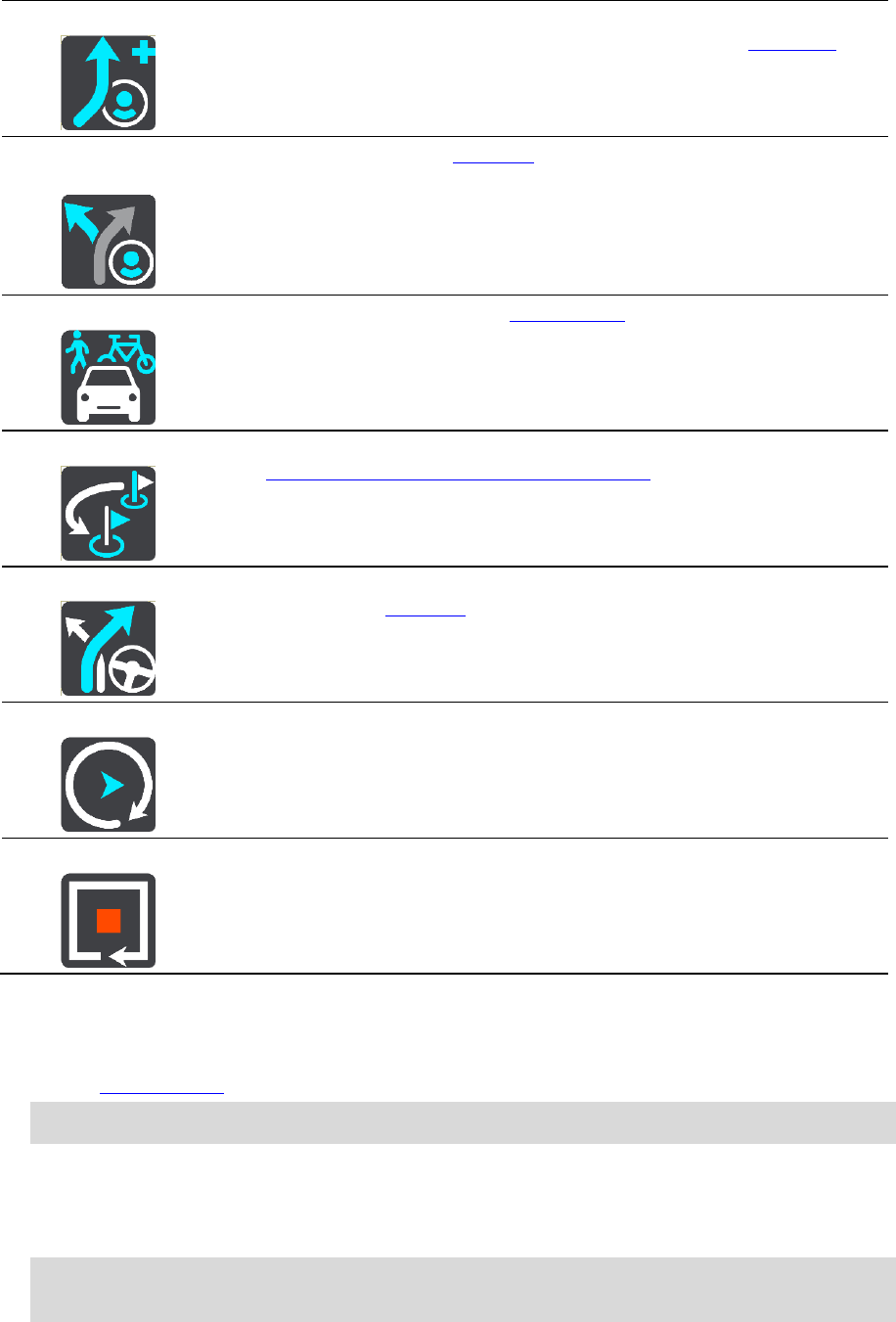
63
Add to My Routes
If you plan a new route that has not already been saved, you see this
button. Select this button to save this route as part of your My Routes list.
Save Changes to
Route
If you make a change to a My Route, you see this button. Select this
button to save the changes.
Change Route Type
Select this button to change the type of route used to plan your route.
Your route will be recalculated using the new route type.
Reorder Stops
Select this button to see the lists of stops for your current route. You can
then change the order of the stops on your route.
For a route without stops, you can also select this button to reverse your
route.
Drive to Route
Select this button to plan a route from your current location to the
starting point of a My Route. The starting point is converted to a stop.
Play Route Preview
Select this button to watch a preview of your planned route.
Stop Route Preview
Select this button to stop the preview of your planned route.
Avoiding a blocked road
If there is a blocked road on your route you can change your route to avoid it.
1. In the guidance view, select the current location symbol or the speed panel.
Tip: The speed panel is only shown when you have started driving on your route.
2. Select Avoid Blocked Road.
A new route is found that avoids the blocked road. You may get shown up to two alternatives
depending on the road network between you and your destination.
The new route is shown on the map view with the difference in travel time in a balloon.
Note: It may not be possible to find an alternative route around the blocked road if none
exists.
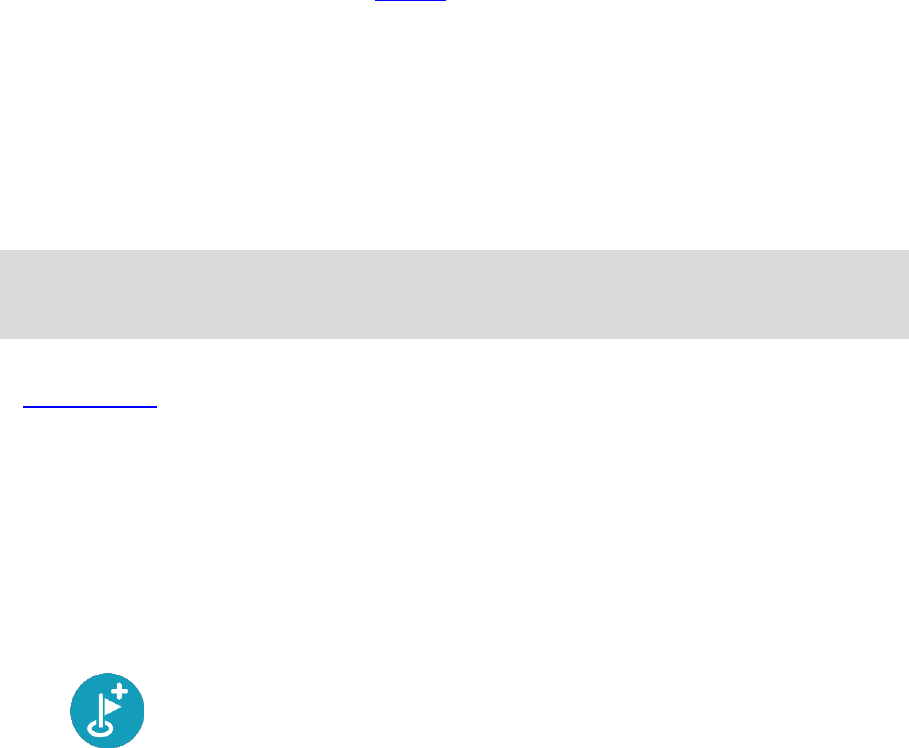
64
3. Select the new route by selecting the time balloon.
4. Select Let's go.
Guidance to your destination resumes avoiding the blocked road. As soon as you start driving,
the guidance view is shown automatically.
Types of route
Select Change Route Type to change the type of route planned to your current destination. Your
route is recalculated using the new route type.
You can select the following types of route:
Fastest route - the fastest route to your destination. Your route is constantly checked taking
into account the traffic conditions.
Shortest route - the shortest route to your destination. This may take much longer than the
fastest route.
Most eco-friendly route - the most fuel-efficient route.
Avoid Motorways - this type of route avoids all motorways.
Walking Route - this type of route is optimised for walking.
Bicycle Route - this type of route is optimised for bicycles.
You can set the default route type in the Settings Menu.
Route features
You can choose to avoid some features that are on your currently planned route. You can avoid the
following route features:
Toll Roads
Ferries and car shuttle trains
Carpool Lanes
Unpaved Roads
Note: Carpool lanes are sometimes known as High Occupancy Vehicle Lanes (HOV lanes) and are
not present in every country. To travel on these lanes, you may need to have more than one
person in the car, for example, or the car may need to use environmentally-friendly fuel.
If you choose to avoid a route feature, a new route is planned.
In Route Planning in the Settings Menu, you can set how each route feature is handled when a new
route is planned.
Adding a stop to your route from the current route menu
1. In the Main Menu, select Current Route.
2. Select Add Stop to Route.
The map view is shown.
3. To select a stop, do one of the following steps:
Zoom in on the map, then press and hold to select a location. In the pop-up menu, select
Add to Current Route.
Select Search and search for a location. When you have found a location, select the Add
Stop to Route button.
Your route is recalculated to include your stop.
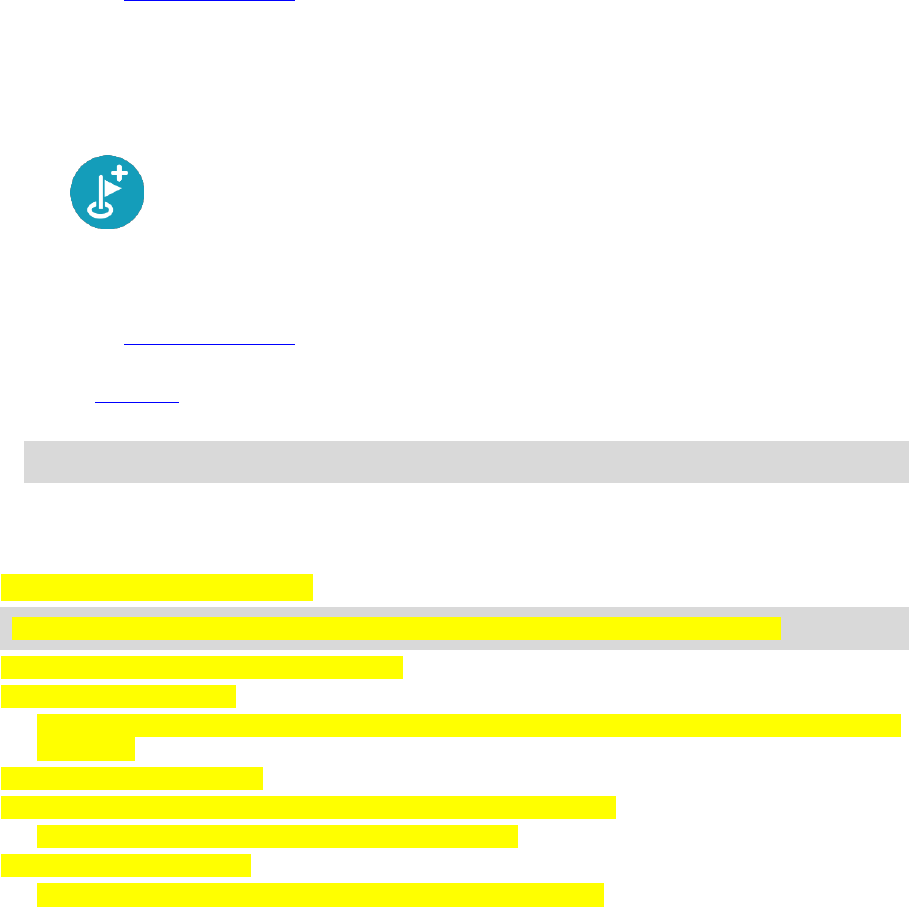
65
Adding a stop to your route using the map
1. Press the switch view button to show the map.
Your complete route is shown on the map.
2. Zoom in on the map, then press and hold to select a location.
3. Select the pop-up menu button.
4. Select Use in Route.
5. Select Add to Current Route.
Your route is recalculated to include your stop.
Deleting a stop from your route
1. Press the switch view button to show the map.
Your complete route is shown on the map.
2. In the route bar, press the stop you want to delete.
The map zooms in to the stop and shows a pop-up menu.
Tip: If you select the wrong stop press the back button to return to the map.
3. Select Delete This Stop.
The stop is deleted and your route is recalculated.
Reordering stops on a route
Note: If you have a route with no stops, you can use this button to reverse the route.
1. In the Main Menu, select Current Route.
2. Select Reorder Stops.
The map view is shown with the route cleared. The starting point, destination and all the stops
are shown.
3. Select the starting point.
4. Select the stops one by one in the order you wish to drive them.
The symbols change to a flag as you select each stop.
5. Select your destination.
Your route is recalculated with the stops in the changed order.
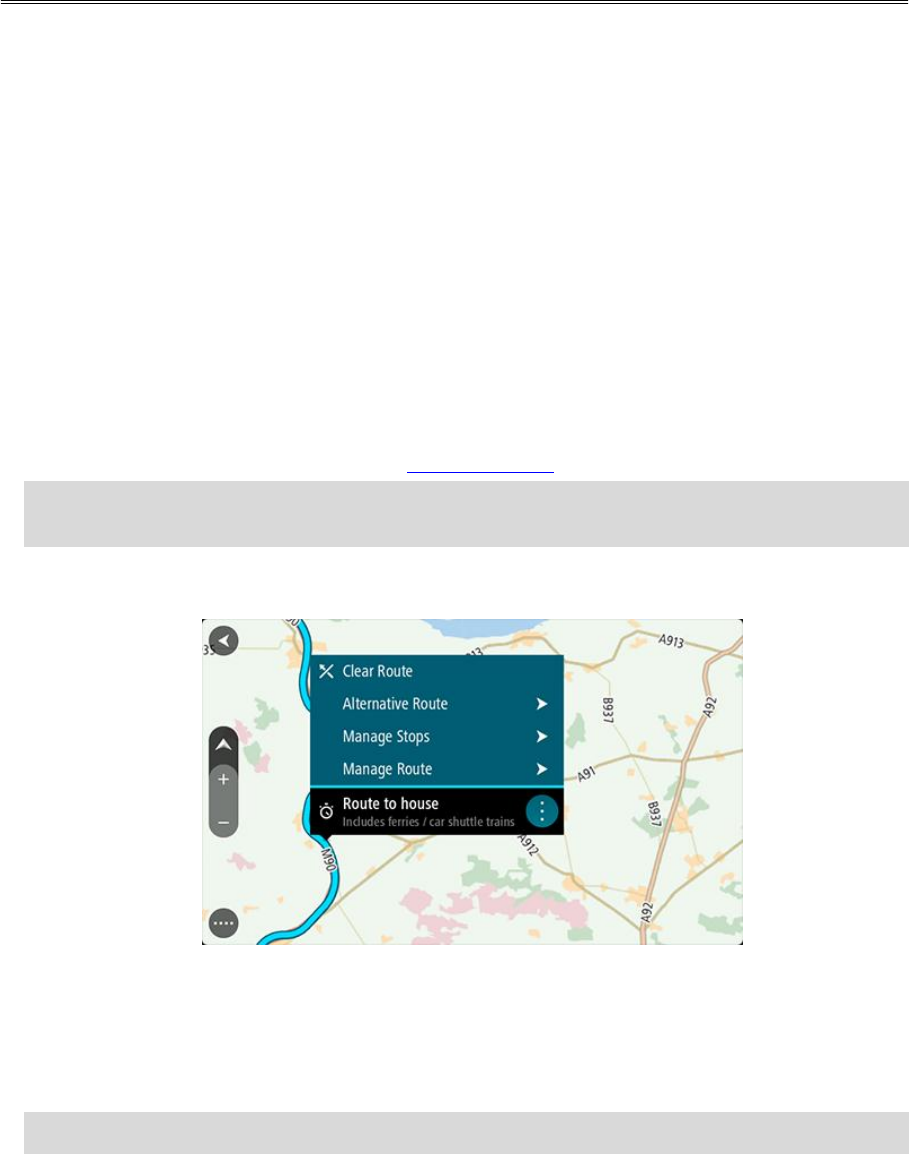
66
About My Routes
My Routes provides an easy way to create saved routes with optional stops, sometimes known as an
itinerary. You can use My Routes to save, retrieve and edit routes.
You may want to use My Routes in one or more of the following situations:
While working - Your job involves driving several routes with multiple stops on a daily basis.
Your routes can change and you need to be flexible and be able to change the order of your
stops or change the planned route.
While on holiday - You are going on holiday and want to plan and save a route. Your route
includes scenic roads, stops at various hotels, and other places like tourist attractions.
While commuting to work - You want to add one or two regular stops between home and work.
Your route back home in the evening is the reverse of your route to work in the morning.
You can add the route that you have planned on the map to your My Routes list by selecting it.
Saving a route
1. Plan a route using the steps described in Planning a route.
Tip: If you cannot see your planned route on the map view, select the back button to show
your route.
2. Select the route.
3. Select the pop-up menu button to open the menu.
4. Select Manage Route.
5. Select Add to My Routes.
The name of the route is shown in the edit screen.
6. Edit the name of the route so that you can easily recognise it.
7. Select Add to save your route in the My Routes list.
Tip: You can also save a route using the Add to My Routes button in the Current Route menu.
My Routes
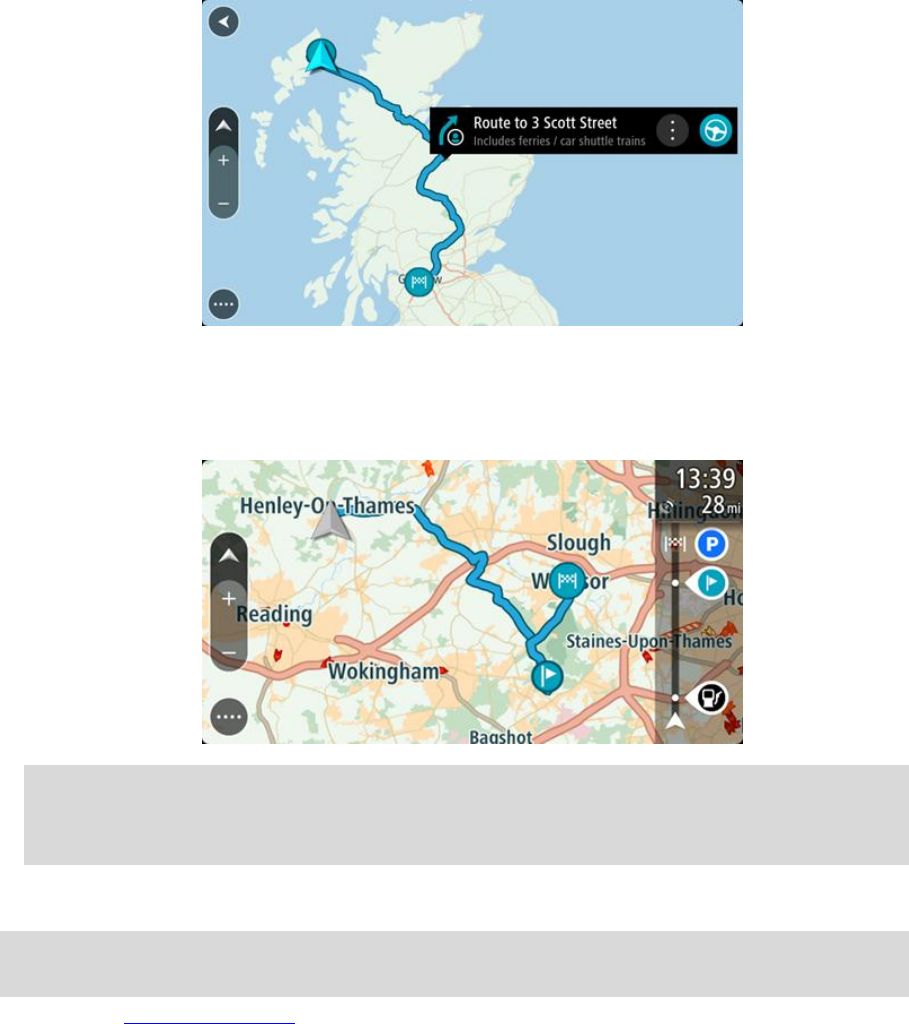
67
Navigating using a saved route
To navigate using a previously saved route, do the following:
1. In the Main Menu, select My Routes.
2. Select a route from your list.
The route is shown on the map view.
3. To navigate to the start of the saved route, select Drive.
The starting point of the saved route is converted to your first stop and then the route is
planned. Guidance to your destination begins from your current location. As soon as you start
driving, the guidance view is shown automatically.
Tip: There are two other ways to navigate using a saved route:
Select the starting point of the route. When the pop-up menu opens, select Change to a Stop.
Alternatively, select Drive to Route in the Current Route menu.
Adding a stop to a saved route using the map
Note: You can also press and hold a location on the map and select Add to Current Route from
the pop-up menu.
1. Press the switch view button to show the map.
Your complete route is shown on the map.
2. Select the route.
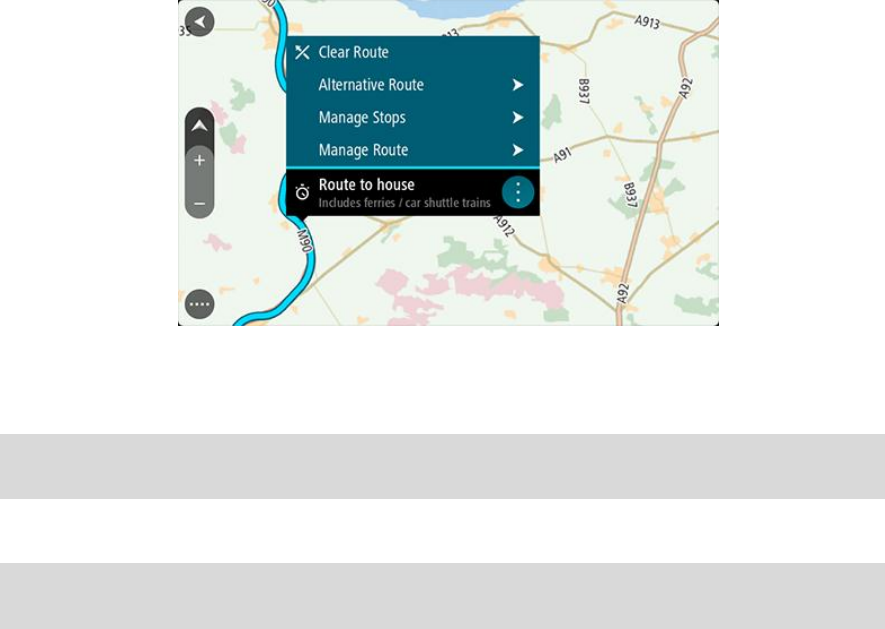
68
3. Select the pop-menu button to open the menu.
4. Select Manage Stops.
5. Select Add Stop to Route.
6. Select your new stop on the map.
Tip: If you know the name of your new stop, you can use Search to select your stop instead of
using the map.
7. Select the Add Stop button to add this location as a stop.
Your route is recalculated to include your stop.
Tip: To update the saved route in your My Routes list with the changes, select the route om
the map then select Save Changes to Route in the pop-up menu.
Deleting a route from My Routes
1. In the Main Menu, select My Routes.
2. Select Edit List.
3. Select the routes you want to delete.
4. Select Delete.
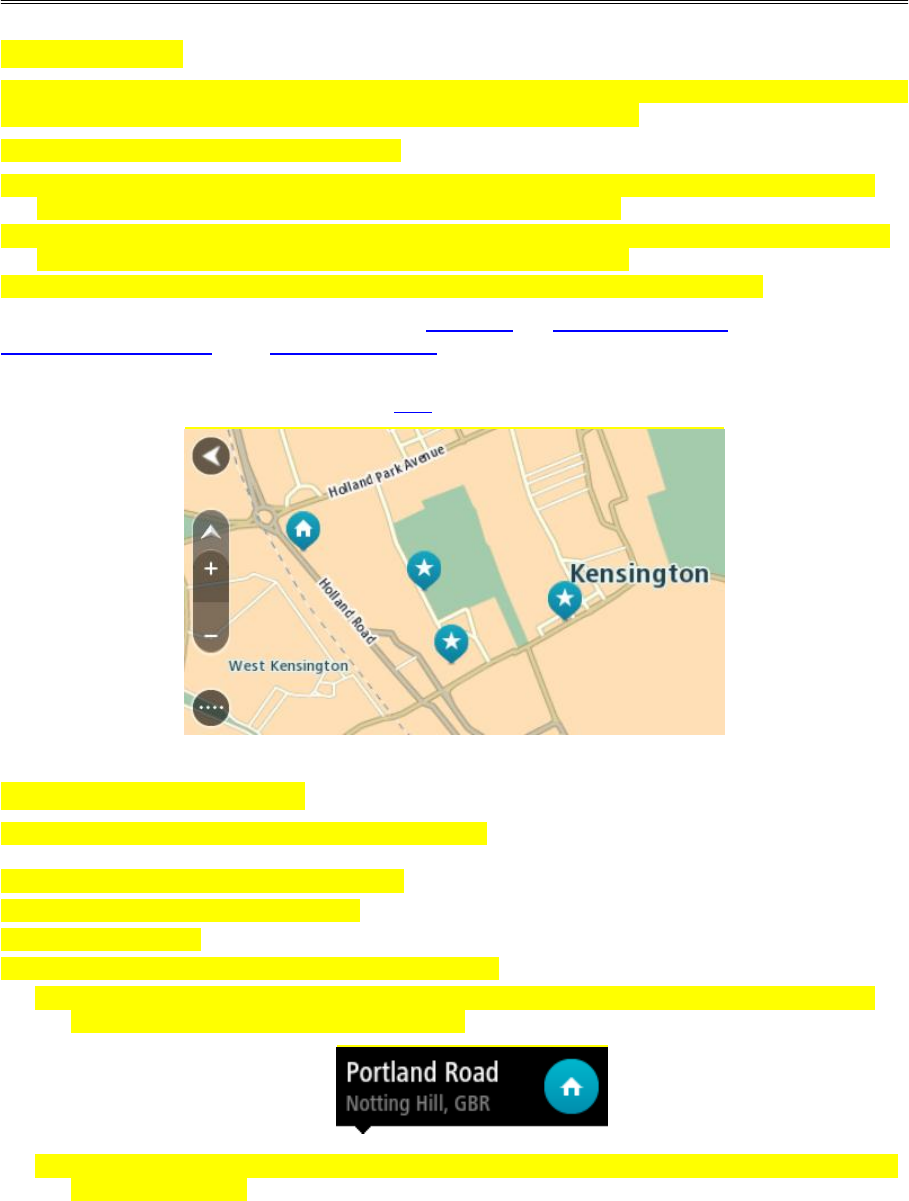
69
About My Places
My Places provides an easy way to select a location without the need to search for the location each
time. You can use My Places to create a collection of useful addresses.
The following items are always in My Places:
Home - Your home location can be your home address or somewhere you often visit, such as
your office. This feature provides an easy way to navigate there.
Recent destinations - Select this button to select your destination from a list of locations you
have recently used as destinations. These also include your stops.
Marked locations - You can mark a location and temporarily add it to My Places.
You can add a location to My Places directly in My Places, by selecting a location from the map, by
searching for a location or by marking a location.
Your home location, marked locations and the locations that you have added appear in a list in My
Places and are shown with a marker on the map.
Setting your home location
You can set your home location in the following ways:
Setting your home location using My Places
1. In the Main Menu, select My Places.
2. Select Add Home.
3. To select a home location, do one of the following:
Zoom in on the map at the location you want to select. Press and hold to select the loca-
tion, then select the home location symbol.
Select the Search button and search for a location. Select a location to set as home. Select
Set home location.
My Places
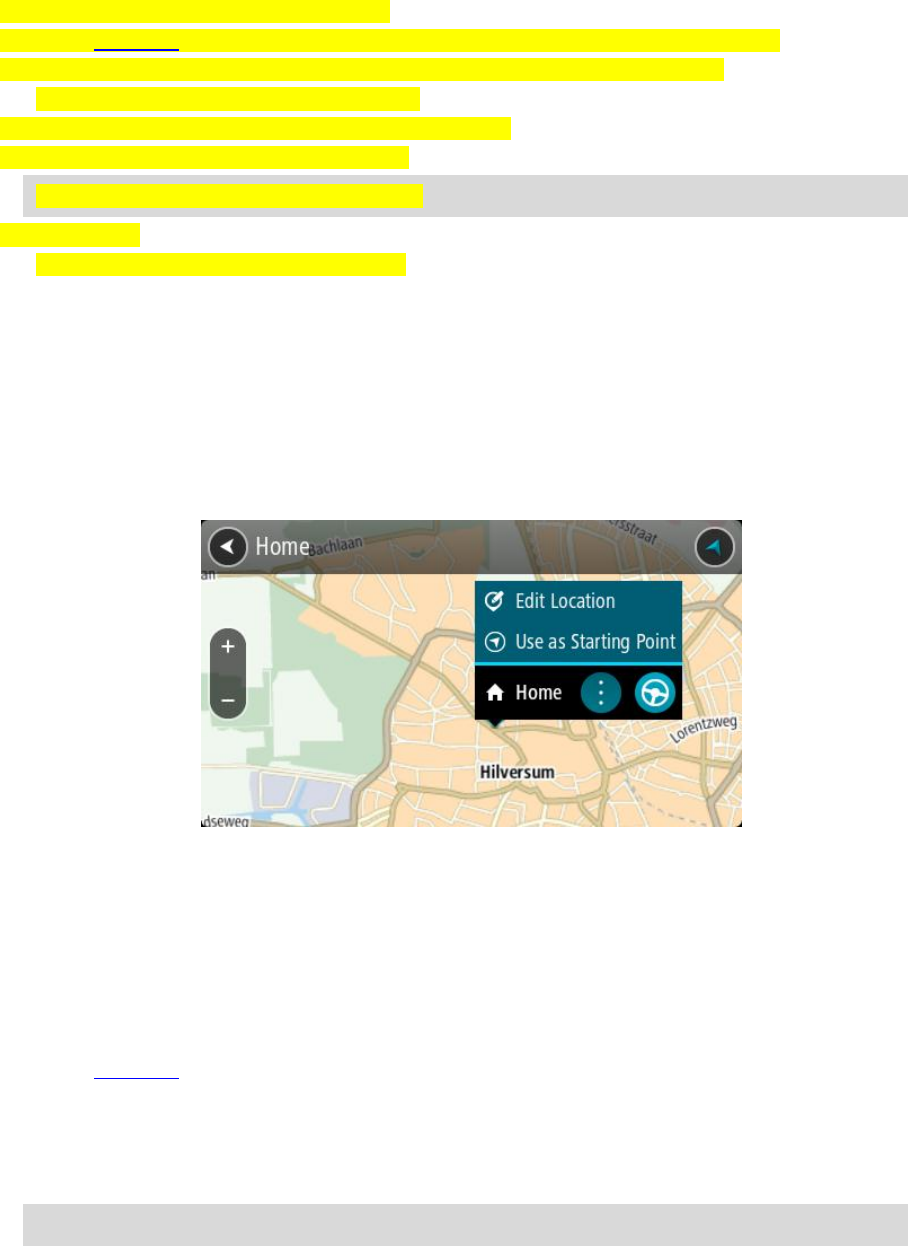
70
Setting your home location using the map
1. In the Map View, move the map and zoom in until you can see your home location.
2. Select the location by pressing and holding the screen for about one second.
A pop-up menu shows the nearest address.
1. Open the pop-up menu and select Add to My Places.
2. In the name bar, enter the name "Home".
Note: "Home" must have a capital letter H.
3. Select Add.
Your home location is shown on the map.
Changing your home location
You can change your home location in the following ways.
Changing your home location using My Places
1. In the Main Menu, select My Places.
2. Select Home.
Your home location is shown on the map, with a pop-up menu.
3. Select Edit Location.
4. To select a new home location, do one of the following:
Zoom in on the map at the location you want to select. Press and hold to select the loca-
tion, then select the home location symbol.
Select the Search button and search for a location. Select a location to set as home. Select
Set home location.
Changing your home location using the map
1. In the Map View, move the map and zoom in until you can see your home location.
2. Select the location by pressing and holding the screen for about one second.
A pop-up menu shows the nearest address.
1. Open the pop-up menu and select Add to My Places.
2. In the name bar, enter the name "Home".
Note: "Home" must have a capital letter H.
3. Select Add.
Your home location is changed to the new location.
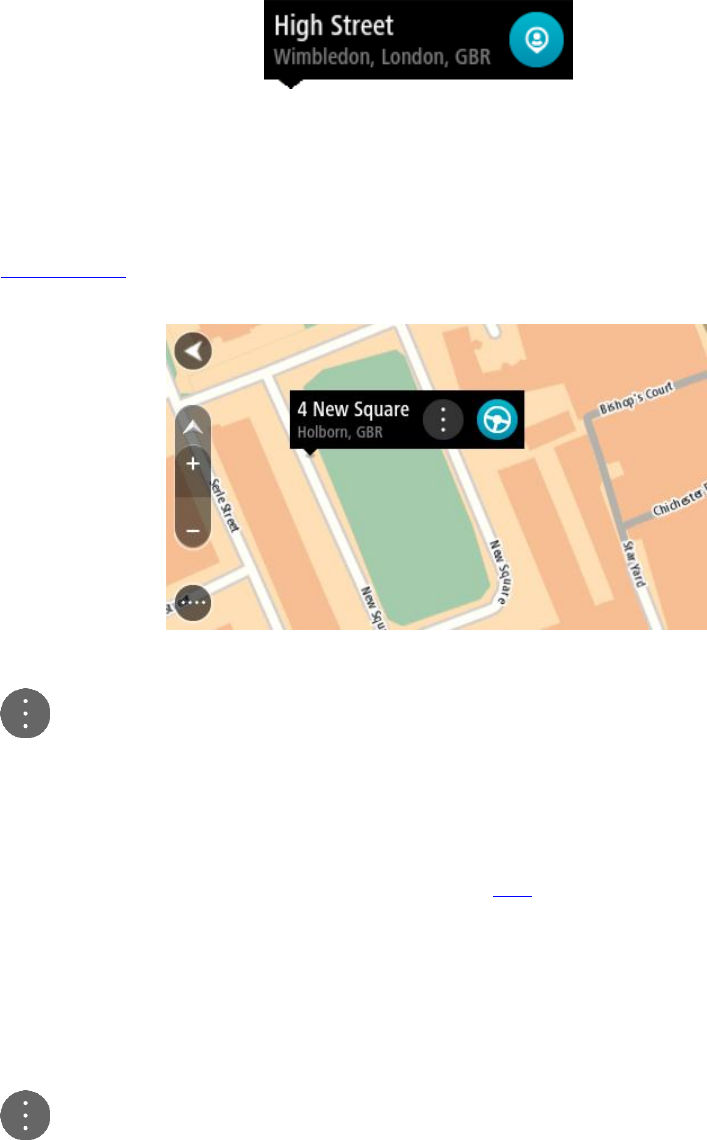
71
Adding a location from My Places
1. In the Main Menu, select My Places.
2. Select Add a new place.
3. To select a location, do one of the following:
Zoom in on the map at the location you want to select. Press and hold to select the loca-
tion, then select the add location symbol.
Search for a location. Select Show on Map, then select the add location symbol.
The name of the location appears in the edit screen.
4. Edit the name of the location so you can easily recognise it.
5. Select Done to save your location in the My Places list.
Add a location to My Places from the map
1. Move the map and zoom in until you can see the destination that you want to navigate to.
2. Press and hold to select the location.
3. Select the pop-up menu button.
4. Select Add to My Places.
The name of the location is shown in the edit screen.
5. Edit the name of the location so you can easily recognise it.
6. Select Done to save your location in the My Places list.
The location you added is shown with a marker on the map.
Adding a location to My Places using search
1. In the Main Menu, select Search.
2. Search for a location.
3. Select the location then select Show on map.
4. When the map view shows the location, select the pop-up menu button.

72
5. Select Add to My Places.
The name of the location appears in the edit screen.
6. Edit the name of the location so you can easily recognise it.
7. Select Done to save your location in the My Places list.
Adding a location to My Places by marking
To mark a location and temporarily add it to My Places, do the following:
1. Make sure that your current location is the location you want to mark.
2. Select the current location symbol or the speed panel in the guidance view to open the quick
menu.
3. Select Mark Location.
4. Once marked, the location is saved in My Places in the Marked Locations list.
If you want to permanently save a marked location, add it My Places by doing the following:
1. From the main menu, select My Places.
2. Select Marked Locations and choose your location from the list.
Your location is shown on the map.
3. Select Add to My Places from the pop-up menu.
The name of the location appears in the edit screen.
4. Edit the name of the location so you can easily recognise it.
5. Select Add.
Deleting a recent destination from My Places
1. In the Main Menu, select My Places.
2. Select Recent Destinations.
3. Select Edit List.
4. Select the destinations you want to delete.
5. Select Delete.
Deleting a location from My Places
1. In the Main Menu, select My Places.
2. Select Edit List.
3. Select the locations you want to delete.
4. Select Delete.
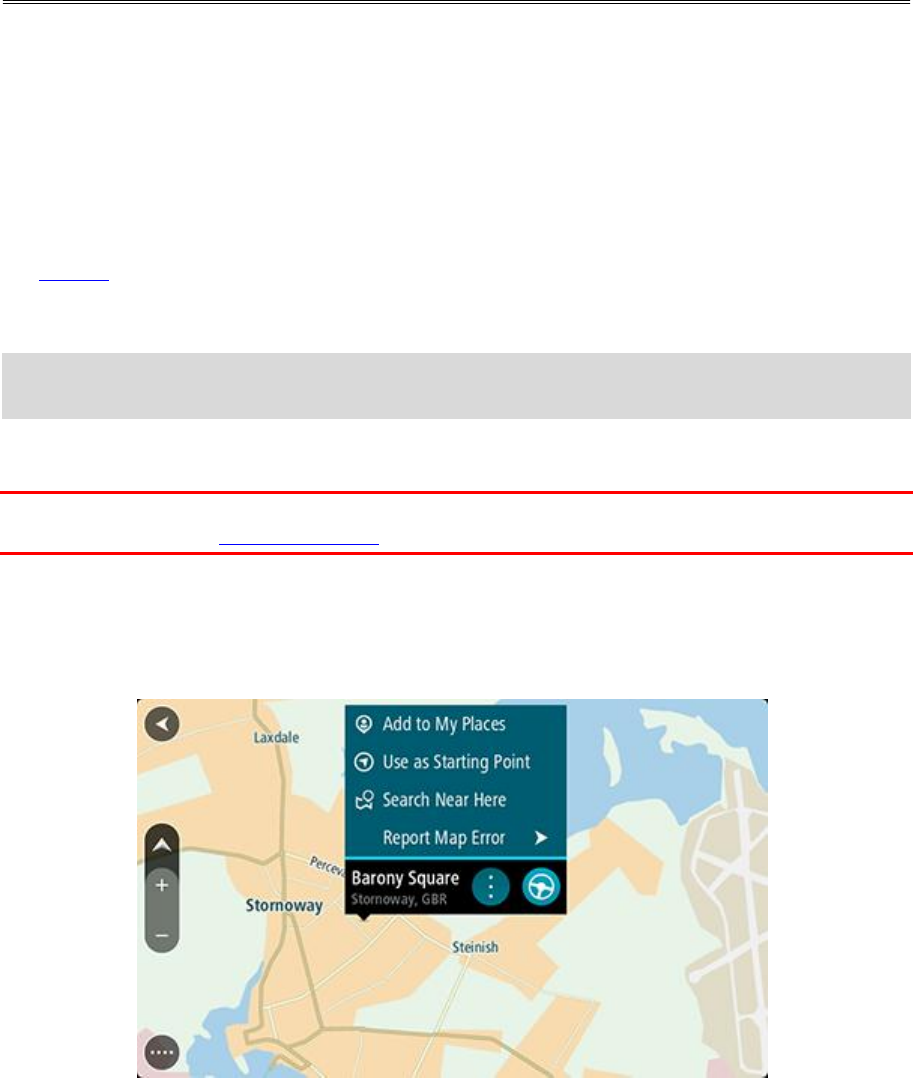
73
About Map Share
You can report map corrections using Map Share. These map corrections are then shared with other
TomTom users when they receive a map update.
There are two ways to report a map correction:
Select a location on the map and create the correction report immediately.
Mark a location and create the correction report later.
To send your map correction reports to TomTom, you must connect your Rider to your computer and
use MyDrive.
All map corrections reported by TomTom users are verified by TomTom. These verified corrections
are then sent back to your own Rider as part of the next map update.
Tip: If a road closure is reported using Map Share, the closure is verified and immediately shown
by TomTom Traffic.
Creating a map correction report
Important: For safety reasons, do not enter the full details of a map correction while you are
driving. You can always mark the location and create the report later.
To create a map correction report, do the following:
1. Press and hold to select the location of the map correction on the map view.
2. Select the pop-up menu button to open the menu.
3. Select Report Map Error from the pop-up menu.
I
4. Select the type of map correction you want to apply.
Map Share
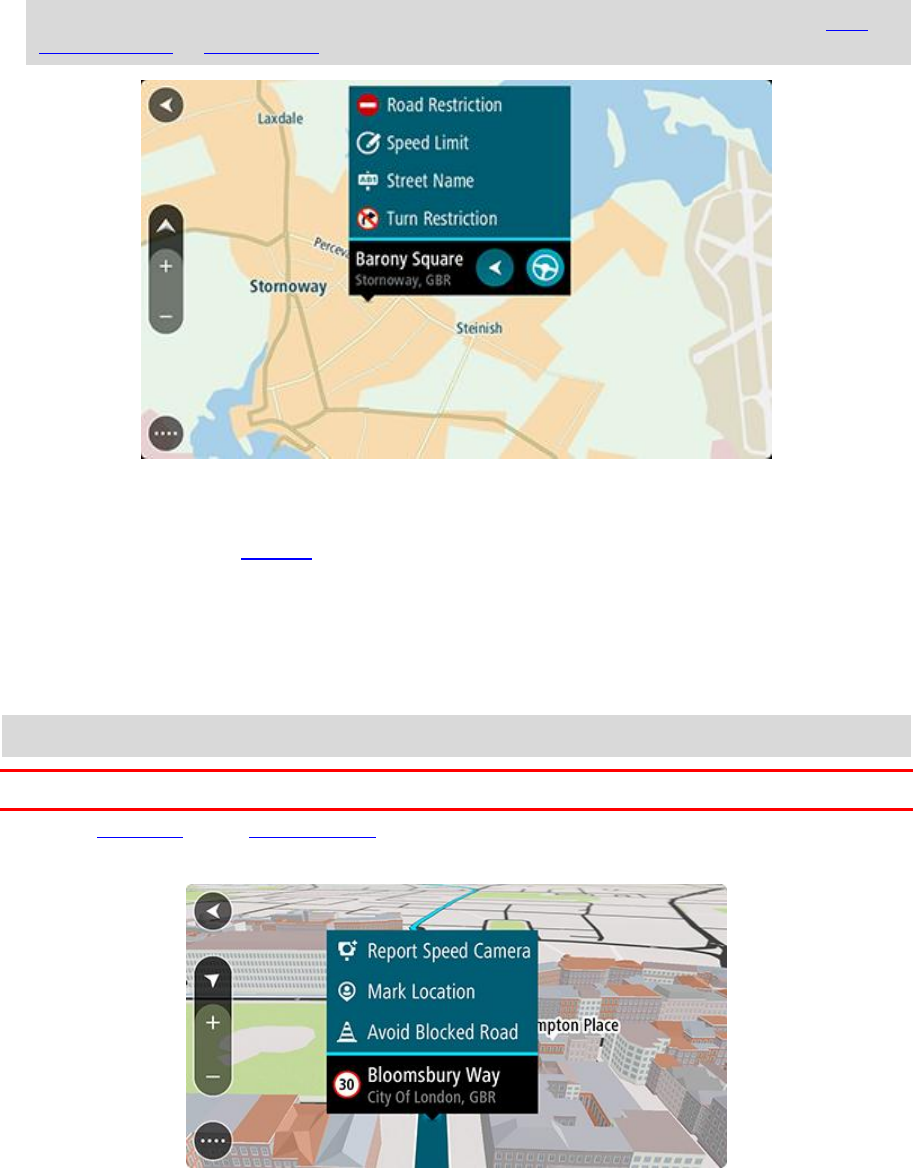
74
Note: If you want to report a map correction of a type not shown in the menu, use the Map
Share Reporter at tomtom.com.
5. Follow the instructions for your chosen type of map correction.
6. Select Report.
7. Connect your Rider to MyDrive to send your map correction report to TomTom and receive map
corrections from other TomTom users.
Creating a map correction report from a marked location
If you see a map error while you are driving, you can mark the location so you can report the error
later.
Tip: You can mark your current location even when you are driving.
Important: Do not report map errors while you are driving.
1. In the map view or the guidance view, select the current location symbol or the speed panel.
The Quick Menu opens.
2. Select Mark Location.
The marked location is stored in My Places with the date and time you saved the location.
3. In the Main Menu, select My Places.
4. Open the Marked locations folder and select the marked location.
The marked location is shown on the map.
5. Select Report Map Error from the pop-up menu.
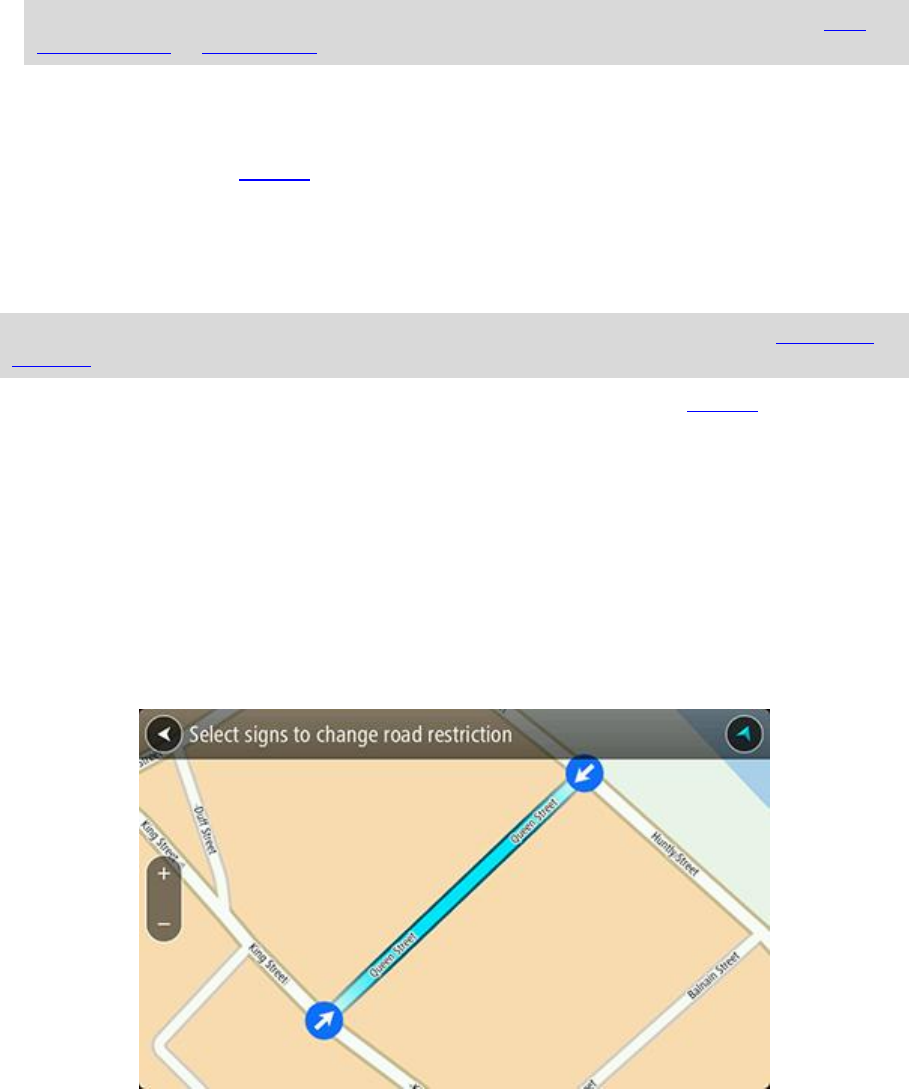
75
6. Select the type of map correction you want to apply.
Note: If you want to report a map correction of a type not shown in the menu, use the Map
Share Reporter at tomtom.com.
7. Follow the instructions for your chosen type of map correction.
8. Select Report.
The marker for the marked location is removed from the map.
9. Connect your Rider to MyDrive to send your map correction report to TomTom and receive map
corrections from other TomTom users.
Types of map correction
There are several types of map correction available.
Note: If you want to report a map correction of a type not described below, use the Map Share
Reporter at tomtom.com.
For all map corrections described below, you need to connect your Rider to MyDrive to send your
map correction report to TomTom and receive map corrections from other TomTom users.
Road Restriction
Select this option to block or unblock a road. You can block or unblock the road in one or both
directions by doing the following:
1. Press and hold to select the location of the map correction on the map view.
2. Select the pop-up menu button to open the menu.
3. Select Report Map Error from the pop-up menu.
4. Select Road Restriction.
Select the road sign at either end of the road to change it from open to closed or vice versa.
5. Select Report.
Street Name
Select this option to correct an incorrect street name.
1. Press and hold to select the location of the map correction on the map view.
2. Select the pop-up menu button to open the menu.
3. Select Report Map Error from the pop-up menu.
4. Select Street Name.
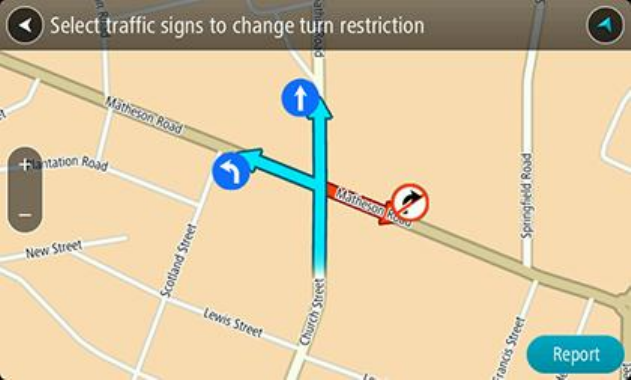
76
5. Enter the correct street name.
6. Select Report.
Turn Restriction
Select this option to report incorrect road turn restrictions.
1. Press and hold to select the location of the map correction on the map view.
2. Select the pop-up menu button to open the menu.
3. Select Report Map Error from the pop-up menu.
4. Select Turn Restriction.
5. If the incorrect junction is shown, select Select another junction.
6. Select the approach direction.
The map rotates so that the direction you are coming from is shown at the bottom of the
screen.
7. Select the traffic signs in turn to change the turn restrictions for each road at the junction.
8. Select Report.
Speed Limit
Select this option to correct the speed limit on the map.
1. Press and hold to select the location of the map correction on the map view.
2. Select the pop-up menu button to open the menu.
3. Select Report Map Error from the pop-up menu.
4. Select Speed Limit.
5. Select the correct speed limit.
If the correct limit is not shown, scroll left or right through the available speed limits.
6. Select Report.
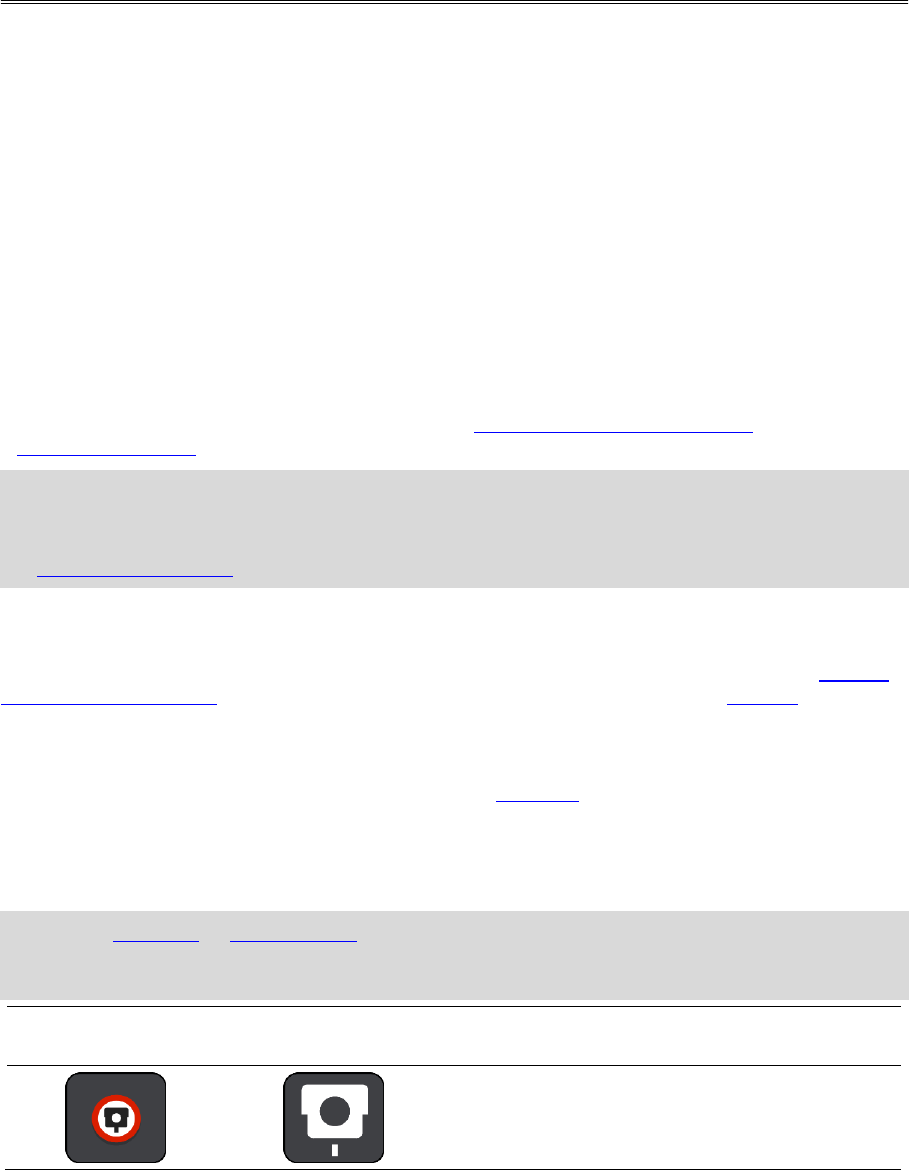
77
About speed cameras
The Speed Cameras service warns you about the following camera locations:
Fixed speed camera locations.
Mobile speed camera locations.
Mobile speed camera hotspots.
Average speed camera locations.
Speed enforcement zones.
Red light camera locations.
Traffic restriction cameras.
The Speed Cameras service also warns you about the following safety hazards:
Accident blackspot locations.
Traffic jams.
To get TomTom services on your Rider, you must be connected to TomTom services and logged in to
a MyTomTom account.
Note: TomTom services are not available on all Rider devices.
Note: TomTom services are not available in all countries or regions, and not all services are
available in all countries or regions. For more information on available services in each region, go
to tomtom.com/services.
Speed camera warnings
Speed camera warning sounds are played for the most common types of speed camera. To change
the way you are warned about speed cameras, select Sounds & Warnings in the Settings menu.
Warnings are given as you approach a speed camera. You are warned in several ways:
A symbol is shown in the route bar and on your route on the map.
Your distance to the speed camera is shown in the route bar.
You hear a warning sound as you get near the camera.
While you are approaching a camera or driving in an average speed check area, your speed is
monitored. If you drive more than 5 km/h or 3 mph over the speed limit the route bar turns red.
If you drive less than 5 km/h or 3 mph over the speed limit the route bar turns orange.
Tip: In the map view or guidance view, you can select a speed camera symbol in the route bar to
see the type of camera, the maximum speed and also the length of an average speed check area.
In the map view, you can also select a speed camera that is shown on your route.
Symbol shown on
map
Symbol shown in
route bar
Description
Fixed speed camera - this type of camera
checks the speed of passing vehicles and is fixed
in one place.
Speed Cameras
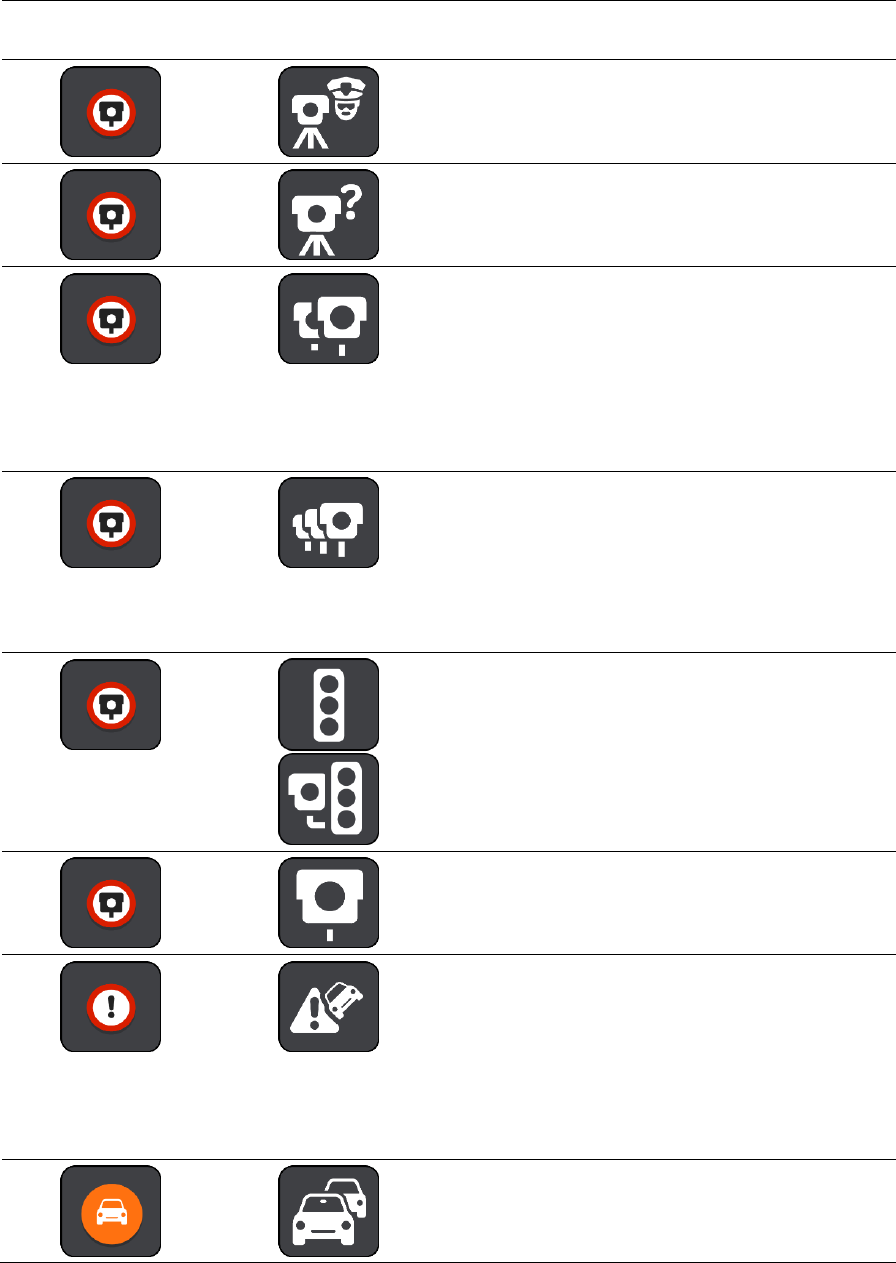
78
Symbol shown on
map
Symbol shown in
route bar
Description
Mobile speed camera - this type of camera
checks the speed of passing vehicles and can be
moved to different locations.
Mobile speed camera hotspots - this type of
warning shows places where mobile cameras are
often used.
Average speed cameras - these types of
cameras measure your average speed between
two points. You are warned at the start and end
of the average speed check area.
While you are driving in an average speed check
area, your average speed is shown, instead of
your current speed. The distance to the end of
the area is shown in the route bar.
Speed enforcement zones - these zones can
contain multiple speed cameras.
You are warned at the start and end of a speed
enforcement zone. While you are driving in a
speed enforcement zone, your current speed is
shown, and the visual warning is shown in the
route bar.
Red light camera - this type of camera checks
for vehicles breaking traffic rules at traffic
lights. There are two types of traffic light
camera - those which check if you drive through
a red light and those which check for driving
through a red light together with speeding.
Traffic restriction - this type of warning warns
you about restricted roads.
Accident blackspot - this type of warning is
given for a place where road traffic accidents
have historically been concentrated.
You are warned at the start and end of the
accident blackspot. While you are driving in an
accident blackspot, your current speed is shown.
When you are in the blackspot, the visual
warning continues to be shown in the route bar.
Traffic jams - warnings are given in the route
bar for traffic jams.
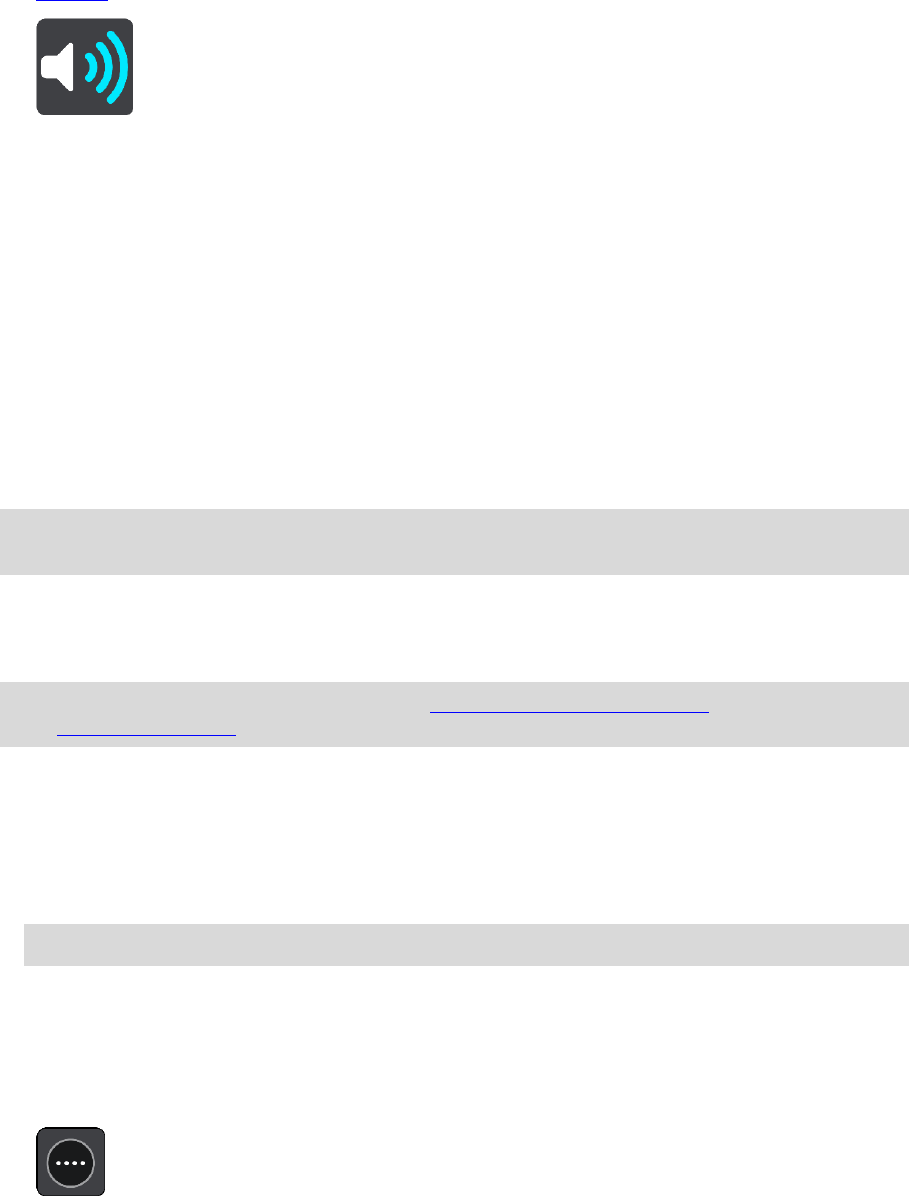
79
Changing the way you are warned
To change the way you are warned about speed cameras, select the Sounds and Warnings button in
the Settings menu.
You can then set how you want to be warned for the different types of cameras and safety hazards.
You can change settings for whether you want to be warned, never warned or warned only if you
are speeding.
For example, to change how you are warned when you approach a fixed speed camera, do the
following:
1. Select Sounds and Warnings in the Settings Menu.
2. Select Speed camera warnings.
3. Select Fixed cameras.
4. Select one of the following warning options:
Always.
Only when speeding.
Never.
5. Select the back button.
Tip: To turn off all audible warnings, select Settings, followed by Sounds and Warnings and then
switch off Warning sounds.
Reporting a new speed camera
If you pass a new speed camera that you were not warned about, you can report it instantly.
Note: To report a speed camera, you must be connected to TomTom services and logged in to
your MyTomTom account.
You can report a speed camera in two ways:
Using the quick menu to report a speed camera
1. Select the current location symbol or the speed panel in the guidance view.
2. Select Report Speed Camera from the pop-up menu.
You see a message thanking you for adding the camera.
Tip: If you make a mistake when reporting a camera, select Cancel in the message.
The speed camera is saved on your Rider automatically and also sent to other users.
Using the Main Menu to report a speed camera
1. Select the Main Menu button to open the Main Menu.
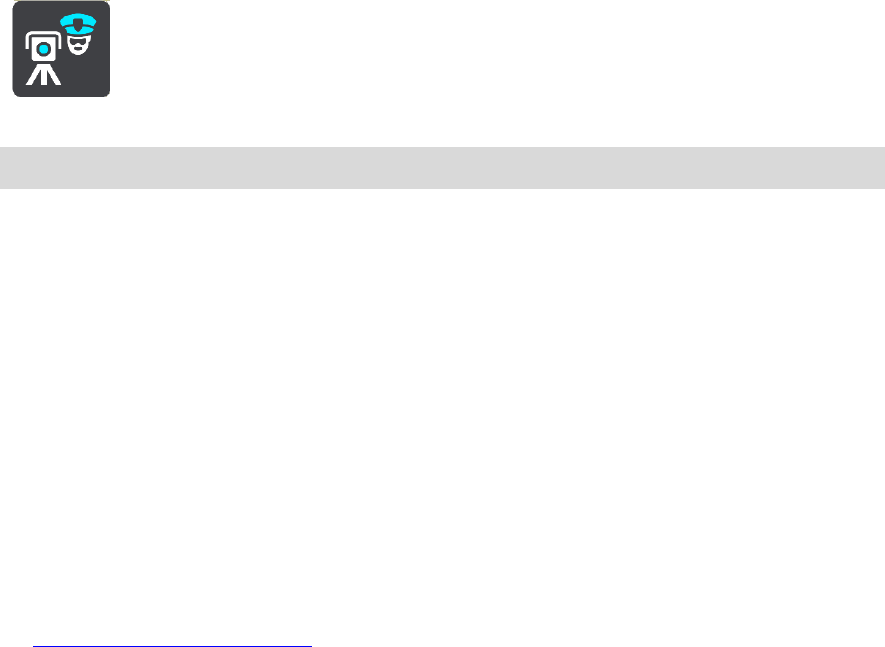
80
2. Select Report Speed Camera.
You see a message thanking you for adding the camera.
Tip: If you make a mistake when reporting a camera, select Cancel in the message.
The speed camera is saved on your Rider automatically and also sent to other users.
Confirm or remove a mobile speed camera
You can confirm the presence of a mobile speed camera or remove a mobile speed camera if it is no
longer present.
1. Just after you pass a mobile speed camera, in the route bar you are asked if the camera was
still there.
2. Select Yes if the mobile speed camera is still there.
3. Select No if the mobile speed camera has been removed.
If you select No, the mobile speed camera is removed from your map.
Updating locations for cameras and hazards
The locations of speed cameras can change frequently. New cameras can also appear without
warning and the locations for other hazards, such as accident blackspots, may also change.
When connected to TomTom services, your TomTom Rider receives all camera updates for fixed and
mobile camera locations in real time. You do not need to do anything to receive updates – they are
sent to your Rider automatically.
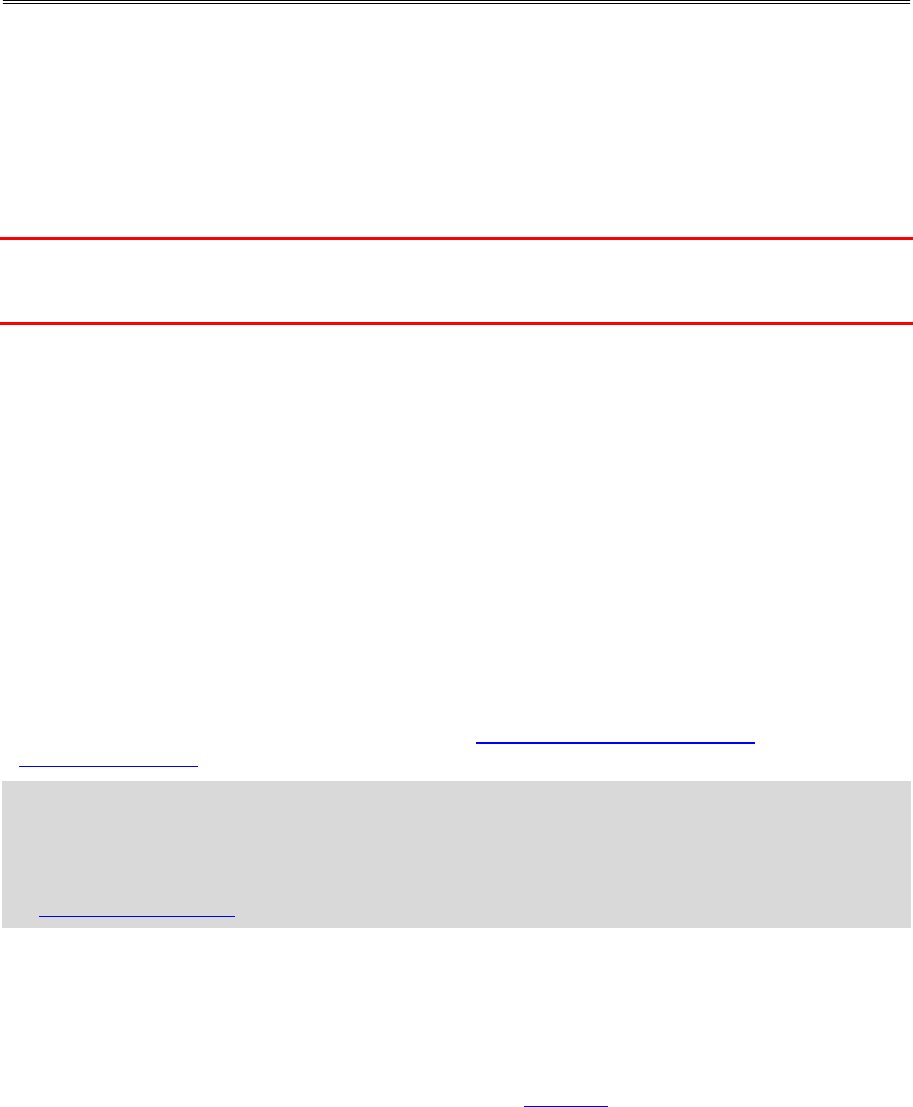
81
About danger zones and risk zones
The Danger Zones service warns you about danger zones and risk zones on your route when you are
in France.
Since 3rd January 2012, it has been illegal to receive warnings about the position of fixed or mobile
speed cameras when you are driving in France. To be compliant with this change in French law,
speed camera locations are no longer reported but instead areas of danger are indicated as danger
zones and risk zones.
Important: Outside of France, you receive warnings about speed cameras. Inside France, you
receive warnings about danger zones and risk zones. When you cross the border, the type of warning
you receive changes.
A danger zone is a zone specified by French law. A risk zone is a temporary danger zone reported by
users. The Danger Zones service warns you about both danger zones and risk zones in the same way.
Danger zones and risk zones may or may not contain one or more speed cameras or a range of other
driving hazards:
Specific locations are not available and a danger zone icon is shown instead as you approach the
zone.
The minimum length of the zone depends on the road type and is 300 m for roads in built-up
areas, 2000 m (2 km) for secondary roads and 4000 m (4 km) for motorways.
The location of one or more speed cameras, if any, can be at any point within the zone.
If two danger zones are close to each other, the warnings can be merged into a single longer
zone.
Information about the location of zones is continually updated by TomTom and other users and
frequently sent to your Rider so that you always have the latest information. You can also
contribute by reporting new risk zone locations.
To get TomTom services on your Rider, you must be connected to TomTom services and logged in to
a MyTomTom account.
Note: You cannot remove a danger zone or a risk zone.
Note: TomTom services are not available on all Rider devices.
Note: TomTom services are not available in all countries or regions, and not all services are
available in all countries or regions. For more information on available services in each region, go
to tomtom.com/services.
Danger zone and risk zone warnings
Warnings are given 10 seconds before you reach a danger zone or risk zone. You are warned in
several ways:
A symbol is shown in the route bar and on your route on the map.
Your distance to the start of the zone is shown in the route bar.
You hear a warning sound as you get near the start of the zone.
While you are approaching a zone or driving in a zone, your speed is monitored. If you drive
more than 5 km/h or 3 mph over the speed limit the route bar turns red. If you drive less than 5
km/h or 3 mph over the speed limit the route bar turns orange.
While you are driving in a zone your distance to the end of the zone is shown in the route bar.
Danger Zones
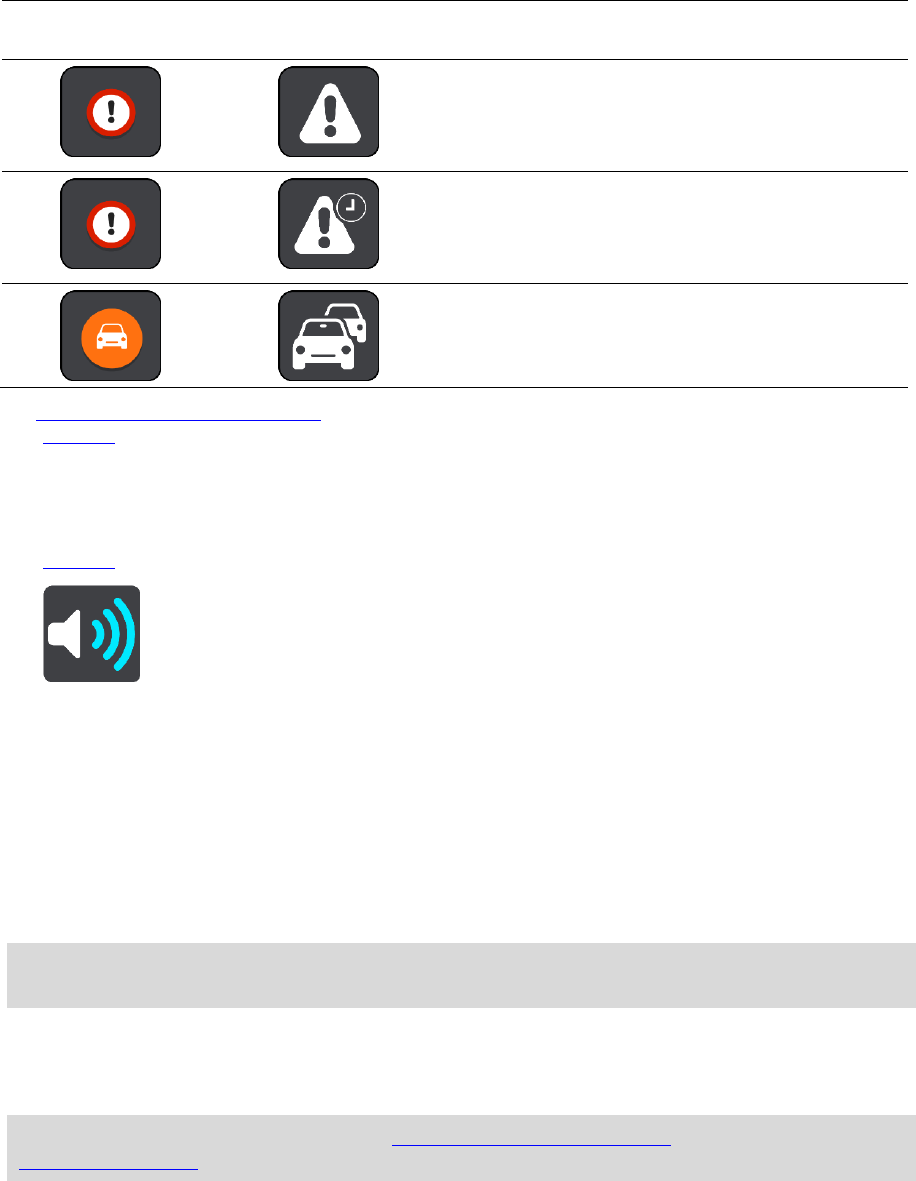
82
Warning sounds are played for these types of zones:
Symbol shown on
map
Symbol shown in
route bar
Description
Danger zone - this type of warning is only given in
France.
You are warned at the start and end of the danger
zone.
Risk zone - this type of warning is only given in
France.
You are warned at the start and end of the risk
zone.
Traffic jams - warnings are given in the route bar
for traffic jams.
To change the way you are warned about danger zones and risk zones, select Sounds & Warnings in
the Settings menu.
Changing the way you are warned
To change the way you are warned about danger zones, select the Sounds and Warnings button in
the Settings menu.
You can change settings for whether you want to be warned or not.
For example, to change how you are warned when you approach a danger zone, do the following:
1. Select Sounds and Warnings in the Settings Menu.
2. Select Safety warnings.
3. Select Danger zones.
4. Select whether you always want to be warned or warned only when you are speeding. Select
Never to turn off the warning.
5. Select the back button.
Tip: To turn off all audible warnings, select Settings, followed by Sounds and Warnings and then
switch off Warning sounds.
Reporting a risk zone
If you pass a new temporary risk zone that you were not warned about, you can report it instantly.
Note: To report a risk zone, you must be connected to TomTom services and logged in to your
MyTomTom account.
If a new temporary risk zone is reported directly before or after an existing risk or danger zone,
then the new zone is added to the existing zone.
If enough Danger Zones users report a new risk zone, that zone may become a danger zone and be
available for all subscribers.
You can report a risk zone in two ways:
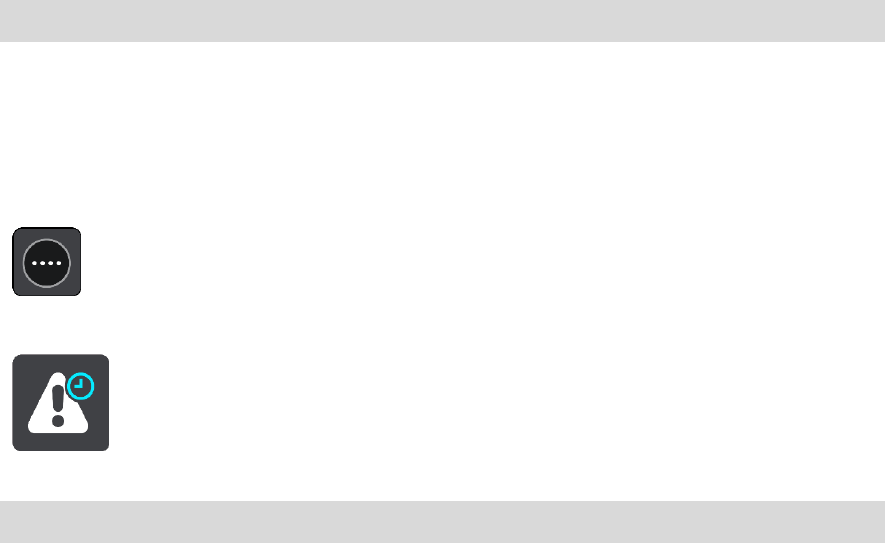
83
Using the quick menu to report a risk zone
1. Select the current location symbol or the speed panel in the guidance view.
2. Select Report Risk Zone from the pop-up menu.
You see a message thanking you for adding the risk zone.
Tip: If you make a mistake when reporting a risk zone, select Cancel in the message.
The risk zone is saved on your Rider automatically and also sent to other users. A reported risk zone
stays on your device for three hours.
Using the Main Menu to report a risk zone
1. Select the Main Menu button to open the Main Menu.
2. Select Report Risk Zone.
You see a message thanking you for adding the risk zone.
Tip: If you make a mistake when reporting a risk zone, select Cancel in the message.
The reported risk zone is shown on your map and also sent to other users. A reported risk zone stays
active for three hours.
Updating locations for danger zones and risk zones
The locations of danger zones and risk zones can change frequently. New zones can also appear
without warning.
Your TomTom Rider receives all zone updates in real time. You do not need to do anything to
receive updates – they are sent to your Rider automatically.
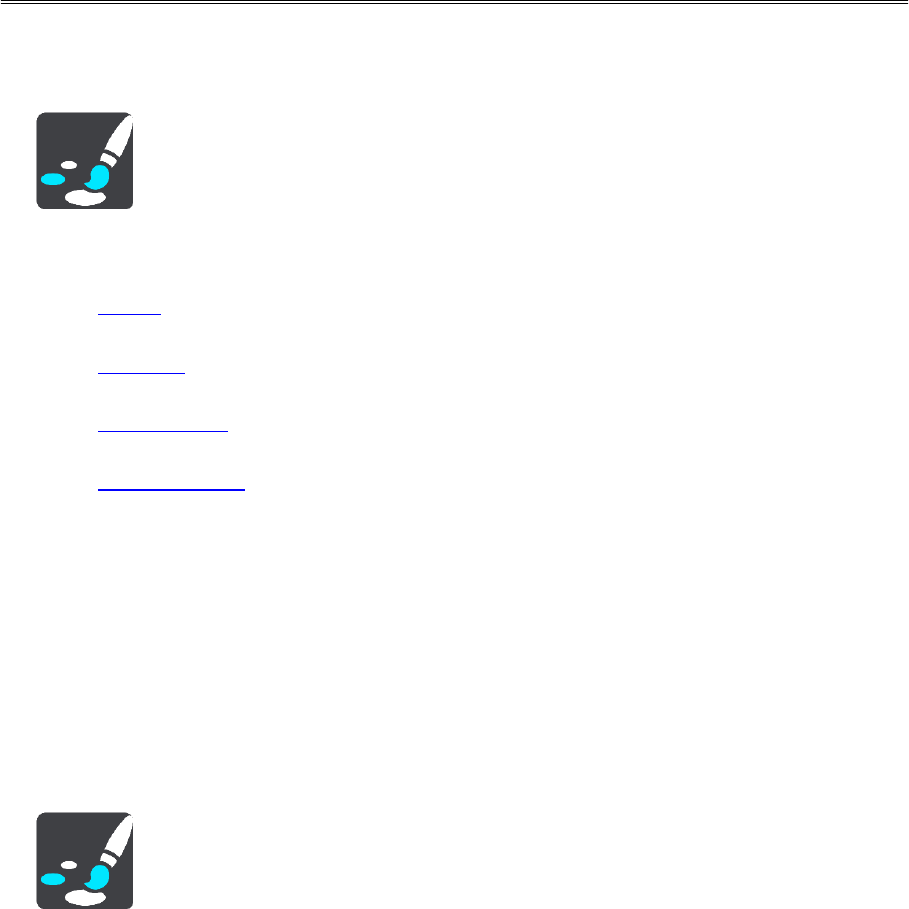
84
Appearance
Select Settings in the Main Menu, then select Appearance.
On this screen, you can change these settings:
Display
Select Display to change the appearance of the display.
Route bar
Select Route bar to change the information you see in the route bar.
Guidance view
Select Guidance view to change the information you see in the guidance view.
Automatic zoom
Select Automatic Zoom to change how you view a junction as you drive.
Automatic map view switching
By default, automatic changing of views is on. This means, for example, that your Rider shows
the map view when an alternative route is being suggested, along with several other sets of
circumstances. Also, for example, that your Rider shows the guidance view when you start
driving and you start to accelerate. Select this setting if you want to turn off automatic chang-
ing between guidance view and map view.
Show previews of motorway exits
Select this setting to control the full screen preview when you approach motorway exits.
Display
Select Settings in the Main Menu, then select Appearance.
Theme colour
Select Theme colour to change the accent colour used in the menus, buttons and icons.
Brightness
Select Brightness to change the following settings:
Day brightness
Move the slider to adjust the brightness level of the screen during the day.
Night brightness
Move the slider to adjust the brightness level of the screen during the night.
Settings
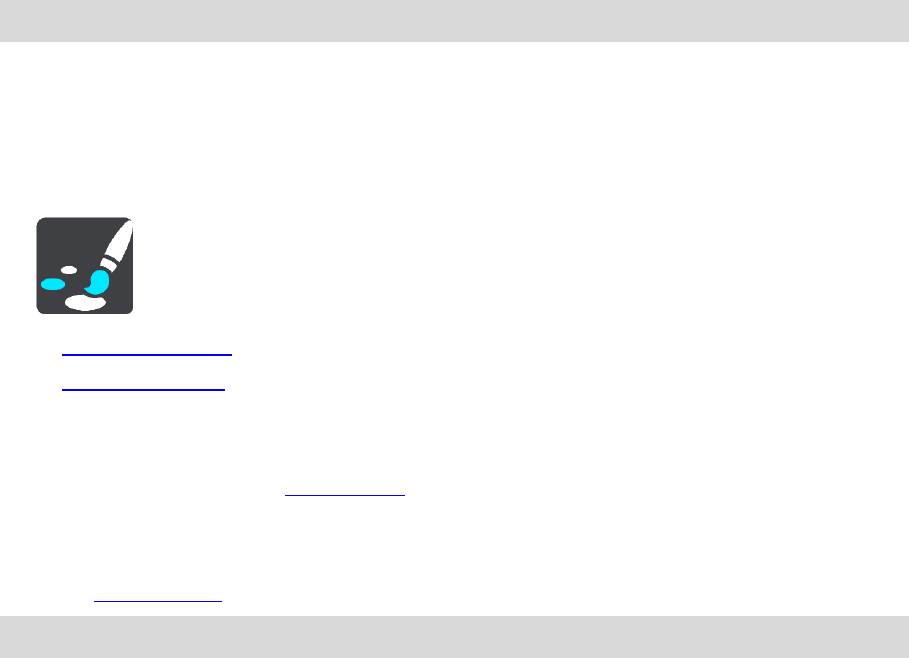
85
Select Switch to night colours when dark to automatically switch to night colours when it gets
dark.
Size of text and buttons
Select Size of text and buttons to change the size of the text and the buttons you see on the
screen.
Note: This feature is only available on devices with a 6 inch / 15 cm or larger screen.
Drag the slider to change the text and button size to small, medium or large, then select Apply this
change. Your Rider restarts and applies the change.
Route Bar
Select Settings in the Main Menu, then select Appearance.
Select Arrival information to change the arrival information you see in the route bar.
Select Route information to change the route information you see on the route bar.
Show current time
Select this setting to show the current time in the guidance view. When switched on, the current
time is shown at the bottom of the route bar.
Show wide route bar if possible
The wide route bar is not shown by default. You can select this setting to switch on the wide route
bar in the guidance view.
Note: The wide route bar can only be shown if the screen is wide enough.
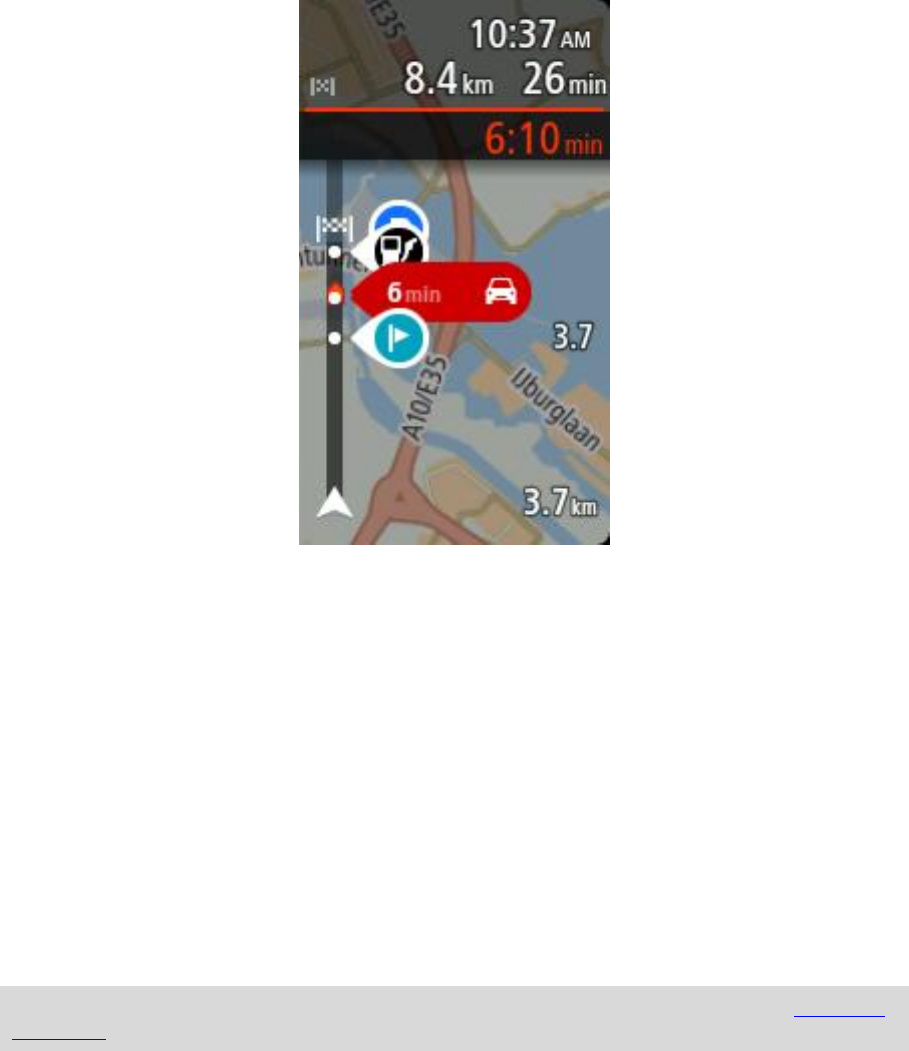
86
When the wide route bar is shown, you see more information about your route. For example, you
see time and distance to traffic queues and more.
Arrival information
Select Arrival information to change the following settings:
Show remaining distance
Select this setting to show the remaining distance left to travel in the arrival information panel
during navigation.
Show remaining time
Select this setting to show the remaining time left to travel in the arrival information panel
during navigation.
Switch between distance and time automatically
Select this setting to control the automatic switching between remaining distance and remain-
ing time in the arrival information panel.
Show arrival information for
Use this setting to control whether you want to see information about the destination or the
next stop in the arrival information panel.
Tip: To find out where the different panels are in the guidance view or map view, see What's on
the screen.
Route Information
You can choose to see any of the following in the route bar:
Parking
Select this setting to see car parks and parking.
Petrol stations
Select this setting to see petrol stations on your route.
Stops
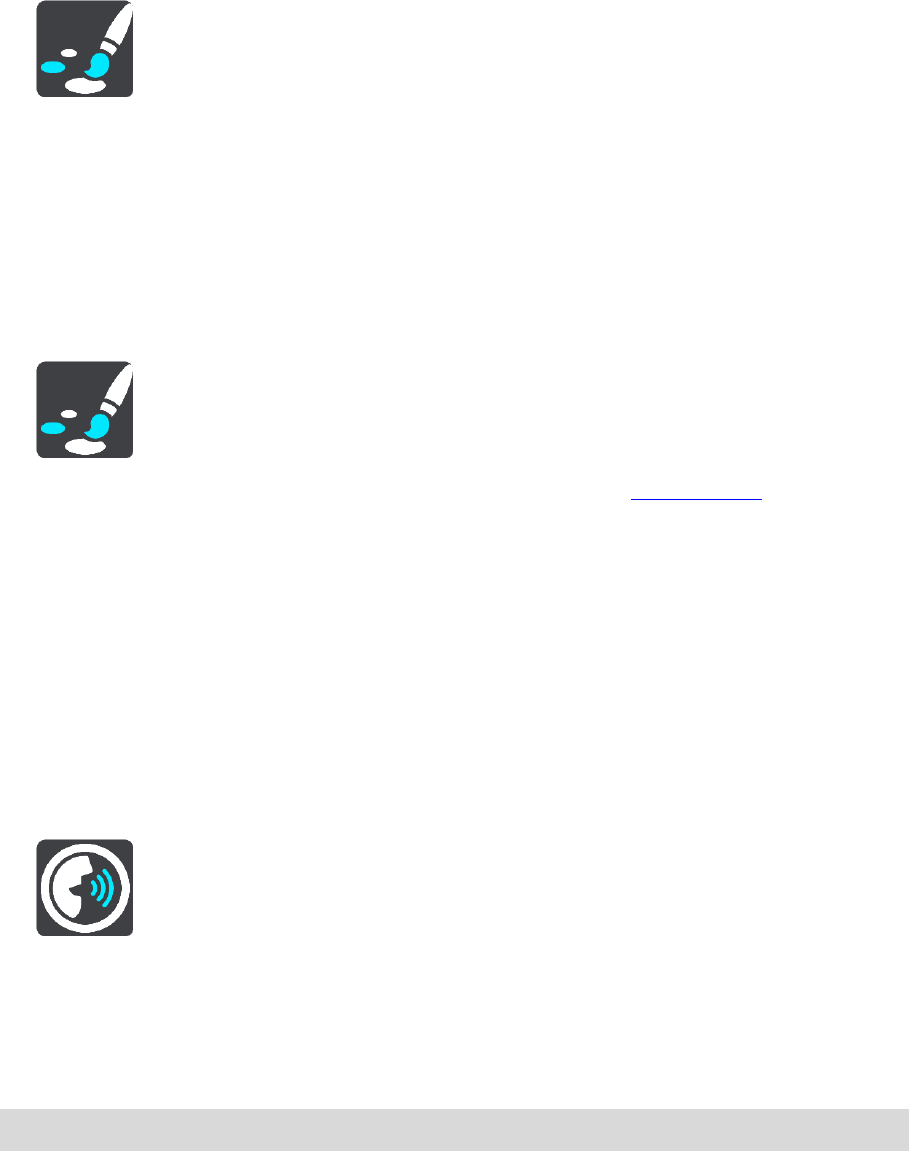
87
Select this setting to see stops on your route.
Rest areas
Select this setting to see rest areas on your route.
Guidance view
Select Settings in the Main Menu, then select Appearance.
Show current street name
This setting displays name of the street you driving along on the guidance view.
Guidance view style
Select this setting to choose from 3D or 2D versions of the guidance view. Both the 2D and 3D
guidance views move in your direction of travel.
Automatic Zoom
Select Settings in the Main Menu, then select Appearance.
Select Automatic zoom to change settings for the automatic zoom in Guidance view when you
approach a turn or a junction. Zooming in can make the turn or junction easier to drive.
Zoom in to next turn
All the turns and junctions on your route are shown zoomed in to the maximum level.
Based on road type
The turns and junctions on your route are shown zoomed in to the standard level for the type of
road you are on.
None
None of the turns and junctions on your route are shown zoomed in.
Voices
Select Settings in the Main Menu, then select Voices.
Choosing a voice
Select Choose a voice to change the voice that gives spoken directions and other route instructions.
A wide range of voices are available. There are computer voices which can read street names and
other information directly from the map and there are recorded voices which have been recorded
by actors.
Note: Computer voices are not available in all languages.
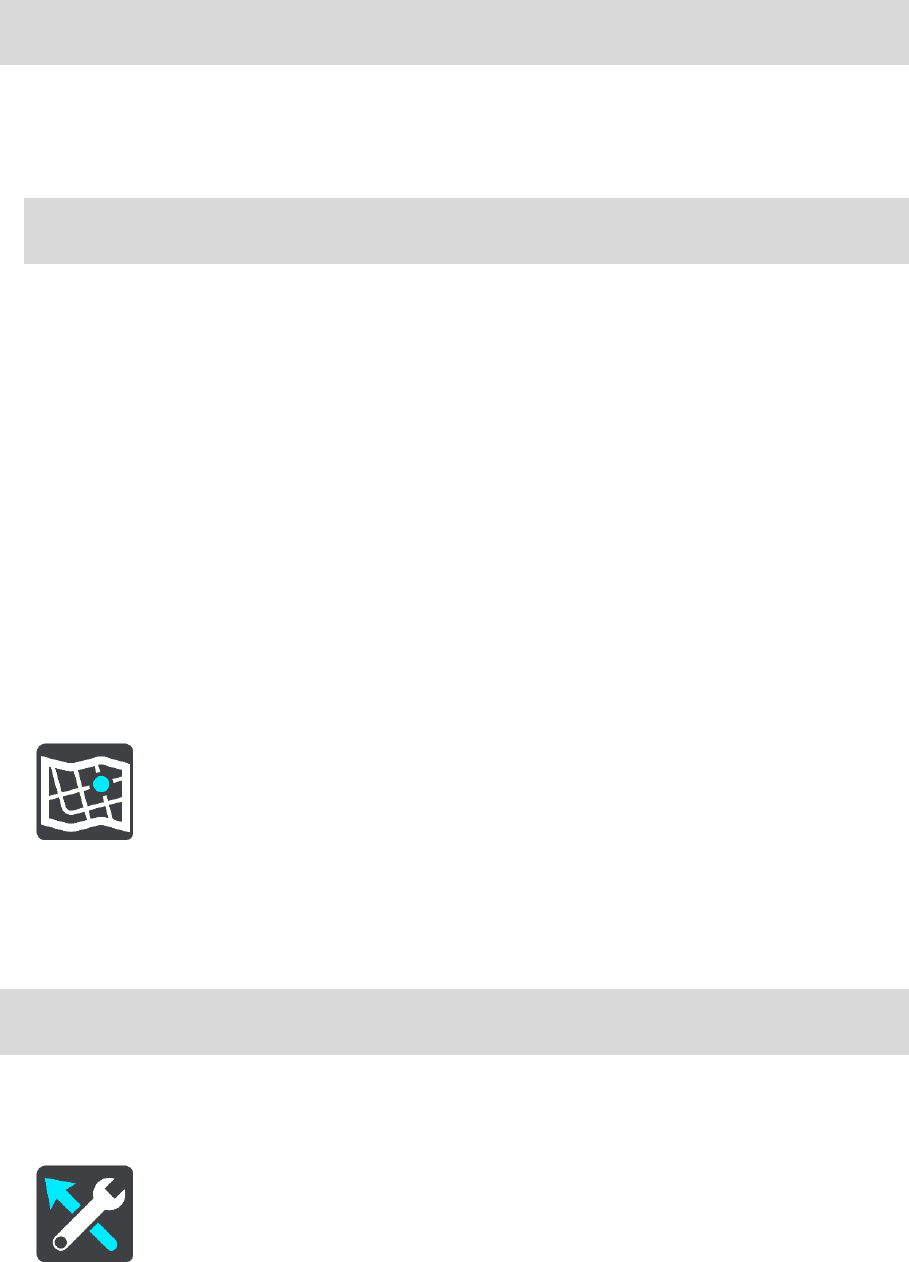
88
If you need a computer voice and your language is unavailable, then you are asked to choose from
a list of installed computer voices available for the country you are in.
Instruction settings
Read aloud early instructions
For example, if you switch on this setting, you could hear early instructions such as "'After 2 km
take the exit right" or "Ahead, turn left".
Note: When a recorded voice is chosen, you see only this setting because recorded voices
cannot read out road numbers, road signs, etc.
Read aloud road numbers
Use this setting to control whether road numbers are read aloud as part of navigation instruc-
tions. For example, when road numbers are read aloud, you hear "Turn left onto A100".
Read aloud road sign information
Use this setting to control whether road sign information is read aloud as part of navigation
instructions. For example, "Turn left onto A302 Bridge Street towards Islington."
Read aloud street names
Use this setting to control whether street names are read aloud as part of navigation instruc-
tions. For example, when street names are read aloud, you hear "Turn left Graham Road to-
wards Hackney."
Read aloud foreign street names
Use this setting to control whether foreign street names are read aloud as part of navigation
instructions, such as "Turn right Champs Élysées". For example, an English computer voice can
read and pronounce French street names but pronunciation may not be completely accurate.
Maps
Select Settings in the Main Menu, then select Maps.
Changing the map
Select Change map to change the map that you are using.
You can choose from maps stored either in internal memory or memory cards if your Rider has a
memory card slot.
Note: Although you can store more than one map on your Rider, you can only use one map at a
time for planning and navigation.
Route Planning
Select Settings in the Main Menu, then select Route Planning.
When a faster route is available
If a faster route found while you are driving, TomTom Traffic can replan your journey to use the
faster route. Select from the following options:

89
Always take the fastest route
Ask me so I can choose
Don't ask me
Always plan this type of route
The types of route you can choose from are as follows:
Fastest route - the route which takes the least time.
Shortest route - the shortest distance between the locations you set. This may not be the
quickest route, especially if the shortest route is through a town or city.
Most eco-friendly route - the most fuel-efficient route for your journey.
Avoid motorways - this type of route avoids all motorways.
Walking route - a route designed for making the journey on foot.
Bicycle route - a route designed for making the journey on a bicycle.
Avoid on every route
You can choose to avoid ferries and car shuttle trains, toll roads, carpool lanes, and unpaved roads.
Set how your TomTom should manage each of these road features when the device calculates a
route.
Carpool lanes are sometimes known as High Occupancy Vehicle Lanes (HOV) and are not present in
every country. To travel on these lanes, you may need to have more than one person in the car, for
example, or the car may need to use environmentally-friendly fuel.
Sounds and Warnings
Select Settings in the Main Menu, then select Sounds & Warnings.
On this screen, you can change the sounds and warnings settings.
Warning type
Warning type
You can choose the type of warnings you want to hear when you are driving:
Read-aloud warnings
Hear spoken warnings and warnings sounds.
Warning sounds
Hear only warning sounds.
None
No warning sounds are given.
Speed camera warnings
Select Settings in the Main Menu, then select Sounds & Warnings.
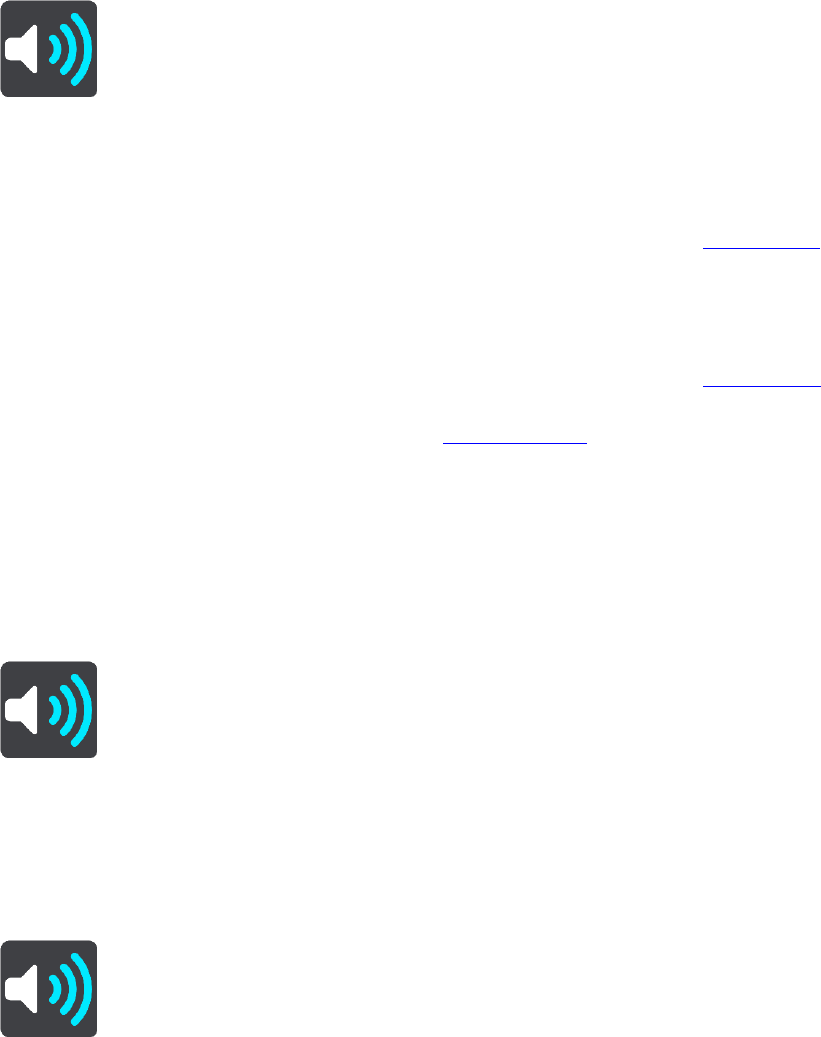
90
Select Speed camera warnings. You can then set how you want to be warned for the different
types of cameras and safety hazards. You can change settings for advance warning time and
whether you want to be warned, never warned or warned only if you are speeding.
Safety warnings
Select Settings in the Main Menu, then select Sounds & Warnings.
Select Safety warnings. You can then set how you want to be warned for the different types of
danger zones and safety hazards. You can change settings for advance warning time and whether
you want to be warned, never warned or warned only if you are speeding.
Danger zones
This type of warning is only given in France where you are only warned about danger zones.
Accident blackspots
This type of warning is given for a place where road traffic accidents have historically been
concentrated.
Risk zones
This type of warning is only given in France where you are only warned about danger zones.
Traffic jams
Traffic jam warnings in the route bar are part of TomTom Traffic. You can choose never to be
warned or to be warned when approaching a jam too quickly.
When speeding
This warning is given as soon as you exceed the speed limit by more than 5 km/h or 3 mph.
When you are speeding, the speed panel also turns red in the guidance view.
Screen touch sounds
Select Settings in the Main Menu, then select Sounds & Warnings.
Switch on Screen touch sounds to hear a click when you select an item or touch a button. The click
sound means that your selection or touch has been understood.
Read aloud traffic warnings
Select Settings in the Main Menu, then select Sounds & Warnings.
Switch on Read aloud traffic warnings to hear spoken warnings about traffic on your route.

91
Language and Units
Select Settings in the Main Menu, then select Language & Units.
On this screen, you can change the following settings:
Language
You can see your currently selected language on this screen. Select this setting to change the
language used for all buttons and messages that you see on your Rider.
When you change the language setting, the voice automatically changes and units are set to
automatic.
Country
You can see your currently selected country on this screen. Select this setting to change the
country. When you change the country, the time/date format, distance units and voice are
changed automatically. The list includes the countries from the maps currently installed on your
device.
Keyboards
Select this setting to choose from a list of available keyboards.
You use the keyboard to enter names and addresses, such as when you plan a route or search
for the name of a town or a local restaurant.
Units
Select this setting to choose the units used on your device for features such as route planning. If
you want the units to be set by the GPS, select Automatic.
Time and date
The time and date are automatically set by satellite clocks but you can change the format of
both the time and date using these settings.
System
Select Settings in the Main Menu, then select System.
On this screen, you can change these settings:
About
This is an information screen rather than a setting and shows you information about your
TomTom Rider. You may be asked to go to this screen during a call to TomTom Customer
Support or you may need to enter information taken from this screen when using the TomTom
Shop.
Information includes: Serial number, Application version, Installed maps, Product certifications,
MyTomTom account details, Free space, Copyright, Licences.
Send information
Select this setting to control whether you are asked about sending information to TomTom
every time your Rider starts.
Battery settings
Select this setting to control power saving options on your Rider.
Reset
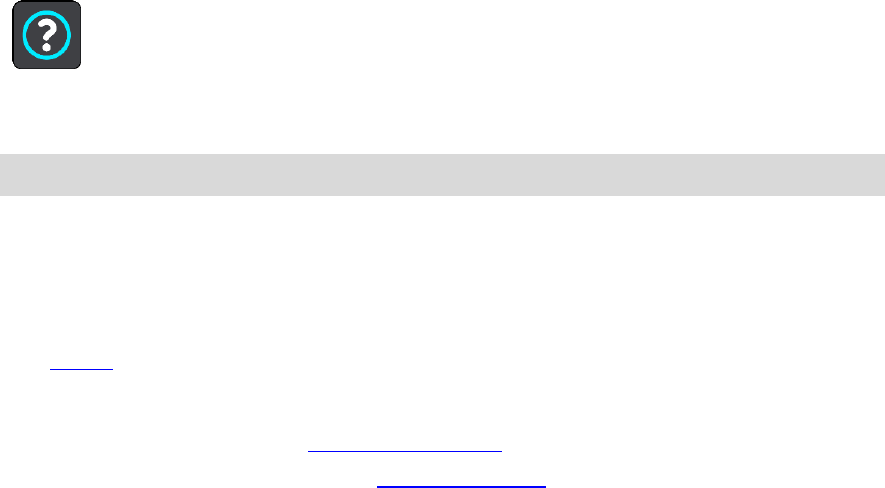
92
Select this setting to delete all your saved places and settings and restore the standard factory
settings to your TomTom Rider. This includes the language, voice settings, warning settings and
theme.
This is not a software update and will not affect the version of the software application in-
stalled on your Rider.
Help
Select Help from the Main Menu or the Settings menu.
On this screen, you can see the following information:
Voice control
Note: Voice control is not supported on all devices or in all languages.
Select this option to see the following information about voice control:
How to use voice control
Tips for using voice control
Which commands can I say?
About
See System.
More help
You can get further help by going to tomtom.com/support.
For warranty and privacy information, go to tomtom.com/legal.
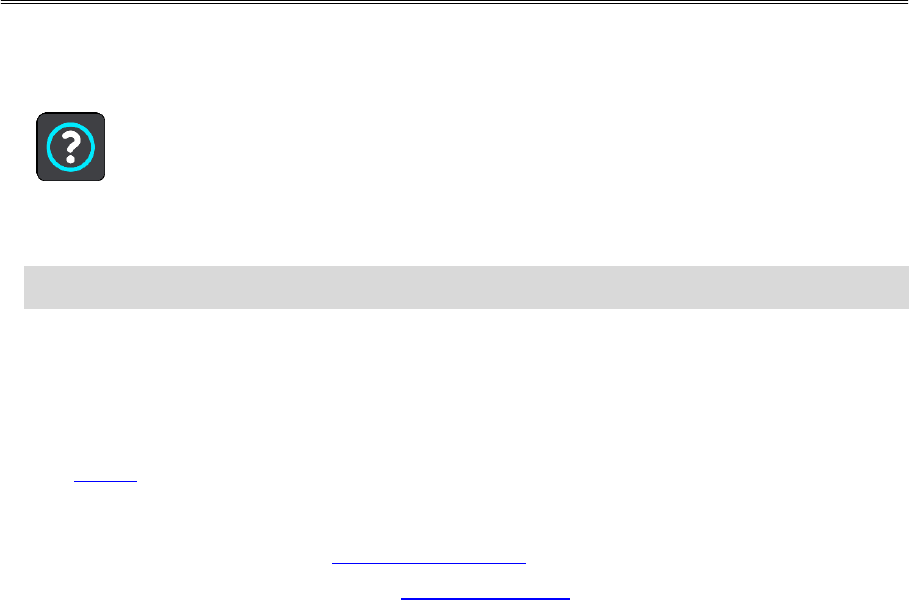
93
Help
Select Help from the Main Menu or the Settings menu.
On this screen, you can see the following information:
Voice control
Note: Voice control is not supported on all devices or in all languages.
Select this option to see the following information about voice control:
How to use voice control
Tips for using voice control
Which commands can I say?
About
See System.
More help
You can get further help by going to tomtom.com/support.
For warranty and privacy information, go to tomtom.com/legal.
Getting Help

94
Finding product certification information on your device
To find product certification information, such as the ICASA-approved certification number, do the
following on your Rider:
1. Select Settings in the Main Menu.
2. Select System.
3. Select About.
4. Select Legal information.
5. Select Certificates.
6. You then see the relevant product certification information for your Rider, for example, ICASA.
Product certification
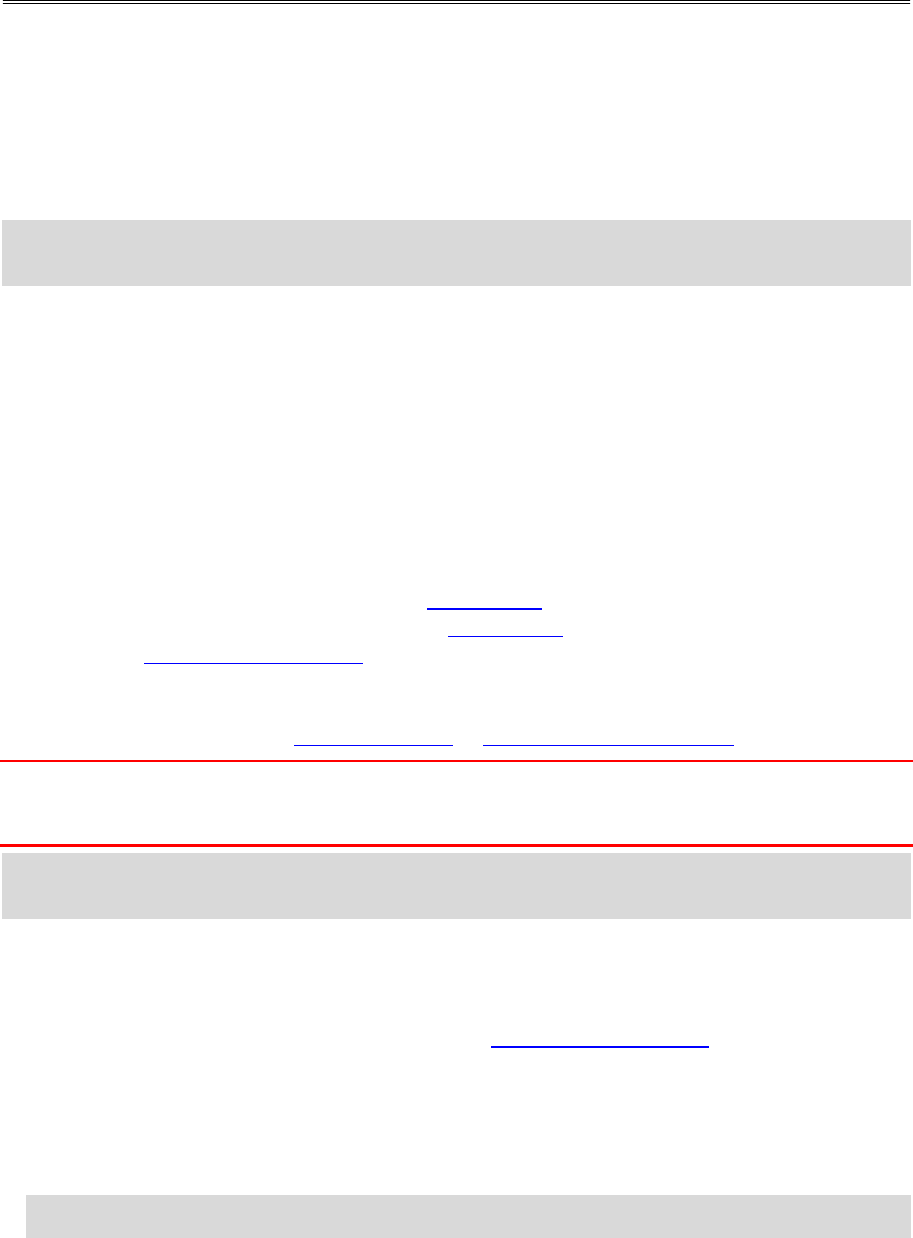
95
About MyDrive
MyDrive is a web-based tool that helps you manage the contents and services of your TomTom
Rider. For example, you can use MyDrive to get map updates, software updates or manage your
MyTomTom account.
You log in to MyDrive on the TomTom website. It is a good idea to frequently connect your Rider to
MyDrive to ensure you always have the latest updates.
Tip: We recommend using a broadband internet connection whenever you connect your Rider to
MyDrive.
About MyDrive Connect
In order to use MyDrive, you need to install MyDrive Connect on your computer.
MyDrive Connect is an application that allows your Rider to communicate with the MyDrive website.
MyDrive Connect needs to be running all the time that your Rider is connected to your computer.
MyTomTom account
To download content and to use TomTom services, you need a MyTomTom account.
You can create an account using your computer in one of the following ways:
By selecting the Create account button at tomtom.com.
By selecting the green MyTomTom button at tomtom.com.
By going to tomtom.com/getstarted.
Alternatively you can create an account on your Rider by selecting Traffic & Speed Cameras or
Traffic & Danger Zones for the first time in the main menu of your navigation device. To use this
method, your Rider needs to be always connected or connected using your phone.
Important: Take care when choosing a country during account creation. The correct country is
needed if you make a purchase from the TomTom shop and it cannot be changed after the account
has been created.
Note: If you have more than one TomTom navigation device in use, you need a separate account
for each device.
Setting up MyDrive
To get ready to use MyDrive for the first time, do the following:
1. On your computer, open a web browser and go to tomtom.com/getstarted.
2. Click Get Started.
3. Click Download MyDrive Connect.
Follow the instructions on the screen.
4. When prompted, connect your Rider to your computer using the USB cable supplied, then switch
your Rider on.
Note: Use ONLY the USB cable supplied with your Rider. Other USB cables may not work.
MyDrive
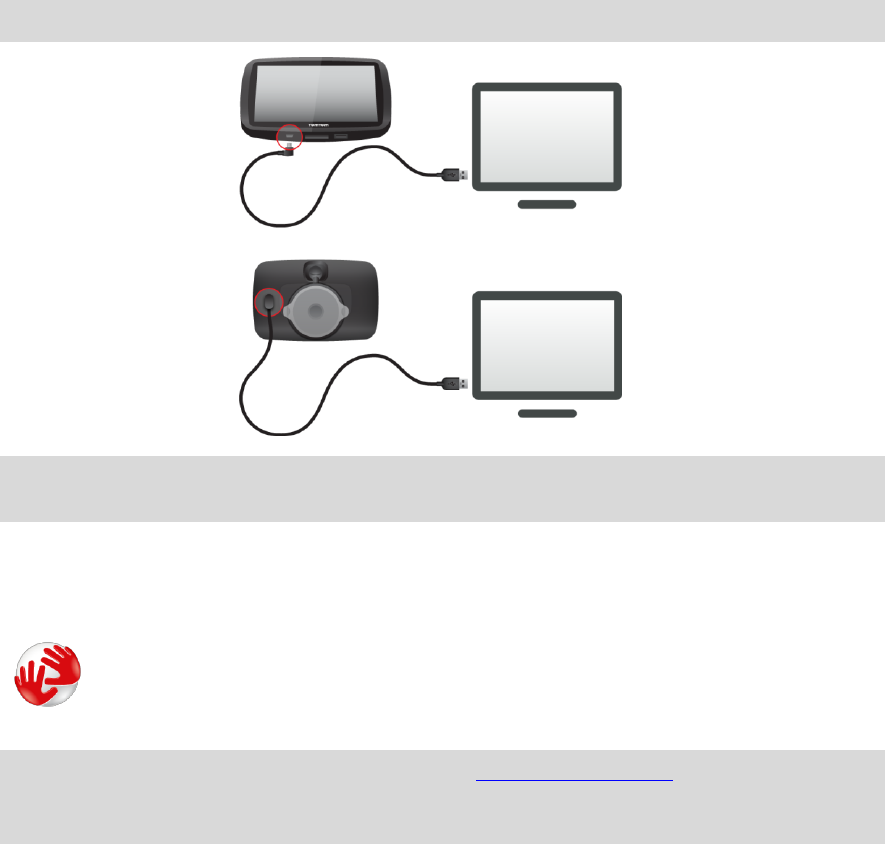
96
Note: You cannot use the mount to connect your Rider to your computer.
Note: You should plug the USB cable directly into a USB port on your computer and not into a
USB hub or USB port on a keyboard or monitor.
5. Enter the requested information for account creation, including your country.
When set-up is complete, a MyTomTom account is created and your Rider is linked to that
account.
You can now access MyDrive Connect from the notification area on your desktop.
MyDrive starts automatically after the account is created.
Note: Next time you want to access MyDrive, go to tomtom.com/mydrive in a web browser.
Tip: When you connect your Rider to your computer, MyDrive Connect tells you if there are any
updates for your Rider.

97
Important Safety Notices and Warnings
Global Positioning System (GPS) and Global Navigation Satellite System (GLONASS)
The Global Positioning System (GPS) and Global Navigation Satellite System (GLONASS) systems are
satellite-based systems that provide location and timing information around the globe. GPS is
operated and controlled by the Government of the United States of America, which is solely
responsible for its availability and accuracy. GLONASS is operated and controlled by the Government
of Russia, which is solely responsible for its availability and accuracy. Changes in GPS or GLONASS
availability and accuracy, or in environmental conditions may impact the operation of this device.
TomTom disclaims any liability for the availability and accuracy of GPS or GLONASS.
Safety messages
Use with care
Use of TomTom products while driving still means that you need to drive with due care and
attention.
Your device is intended to serve as a driving aid and is not a substitute for driving with due care and
attention. Always obey posted road signs and applicable laws. Distracted driving can be extremely
dangerous. Please do not operate this device in any manner that diverts a driver’s attention from
the road in an unsafe manner. TomTom recommends using the hands-free systems where available
and pulling over to a complete stop at a safe location in order to interact with the device.
Notice for oversized/commercial vehicles
If a truck map is not installed on this product then this product is intended for use only on
motorcycles, cars and light commercial vehicles without a trailer, because the product will not
provide appropriate routes for oversized and commercial vehicles, buses, or campers and
recreational vehicles. If you are operating one of those vehicle types, please visit tomtom.com to
find an appropriate product with maps containing height and weight restrictions.
Pacemakers
Pacemaker manufacturers recommend that a minimum of 15cm / 6 inches be maintained between a
handheld wireless device and a pacemaker to avoid potential interference with the pacemaker.
These recommendations are consistent with independent research and recommendations by
Wireless Technology Research.
Guidelines for people with pacemakers
You should ALWAYS keep the device more than 15cm / 6 inches from your pacemaker.
You should not carry the device in a breast pocket.
Other medical devices
Please consult your physician or the manufacturer of the medical device, to determine if the
operation of your wireless product may interfere with the medical device.
Addendum

98
Prohibited uses
Aircraft and hospitals
Use of devices with an antenna is prohibited on most aircraft, in many hospitals and in many other
locations. This device must not be used in these environments.
Special Note Regarding Driving in California, Minnesota and Other States
California Vehicle Code Section 26708 which applies to those driving within the State of California
restricts the mounting of a navigation device on the windshield to a seven-inch square in the lower
corner of the windshield farthest removed from the driver or in a five-inch square in the lower
corner of the windshield nearest to the driver and outside of an airbag deployment zone, if the
system is used only for door-to-door navigation while the motor vehicle is being operated. Drivers in
California should not mount the device on their side or rear windows.
Minnesota State Legislature Statutes Section 169.71, subdivision 1, section 2 restricts any person
driving within the State of Minnesota from driving with a device suspended between the driver and
the windshield.
Many other states have enacted laws which restrict the placement of any object or material on the
windshield, side or rear window that obstructs a driver's clear view of the road. It is incumbent upon
the driver to be aware of all applicable laws and to place the device in such a manner that will not
interfere with his/her driving.
TomTom Inc. bears no responsibility for and hereby disclaims all liability for any fines, penalties or
damage incurred by a driver for violations of the law. While driving in any state with windshield
mounting restrictions, TomTom recommends using the supplied Adhesive Mounting Disk or
purchasing an alternative mounting system (e.g. dashboard or air vents). See tomtom.com for more
information about these mounting options.
Battery
This product uses a Lithium-Ion battery.
Do not use it in a humid, wet and/or corrosive environment. Do not put, store or leave your product
in a high temperature location, in strong direct sunlight, in or near a heat source in a microwave
oven or in a pressurised container, and do not expose it to temperatures over 140°F / 60°C. Failure
to follow these guidelines may cause the battery to leak acid, become hot, explode or ignite and
cause injury and/or damage. Do not pierce, open or disassemble the battery. If the battery leaks
and you come into contact with the leaked fluids, rinse thoroughly with water and seek medical
attention immediately. For safety reasons, and to prolong the lifetime of the battery, remove your
product from your vehicle when you are not driving and keep in a cool, dry place. Charging will not
occur at low (below 32°F / 0°C) or high (over 140°F / 60°C) temperatures.
Temperatures: Standard operation: 32°F / 0°C to 140°F / 60°C; short period storage: -4°F / -20°C
to 113°F / 45°C; long period storage: -4°F / -20°C to 95°F / 35°C.
Important: Before you switch on the device, let the device acclimatise to the standard operation
temperature range for at least 1 hour. Do not use the device outside of this temperature range.
Caution: Risk of explosion if battery is replaced by an incorrect type.
Do not remove or attempt to remove the non-user-replaceable battery. If you have a problem with
the battery, please contact TomTom customer support.

99
THE BATTERY CONTAINED IN THE PRODUCT MUST BE RECYCLED OR DISPOSED OF PROPERLY
ACCORDING TO THE LOCAL LAWS AND REGULATIONS AND ALWAYS KEPT SEPARATE FROM HOUSEHOLD
WASTE. BY DOING THIS YOU WILL HELP CONSERVE THE ENVIRONMENT. USE YOUR TOMTOM DEVICE
ONLY WITH THE SUPPLIED DC POWER LEAD (CAR CHARGER/BATTERY CABLE), AC ADAPTER (HOME
CHARGER), IN AN APPROVED CRADLE OR USING THE SUPPLIED USB CABLE TO CONNECT TO A
COMPUTER FOR BATTERY CHARGING.
If your device requires a charger, please use this device with the charger provided. For replacement
chargers, go to tomtom.com for information about approved chargers for your device.
The stated battery life is a maximum possible battery life. The maximum battery life will only be
achieved under specific atmospheric conditions. The estimated maximum battery life is based on an
average usage profile.
For tips on extending the battery life, see this FAQ: tomtom.com/batterytips.
Do not disassemble or crush, bend or deform, puncture or shred your device.
Do not modify or re-manufacture, attempt to insert foreign objects into the battery, immerse or
expose to water or other liquids, expose to fire, explosion or other hazard.
Only use the battery for a system for which it is specified.
Only use the battery with a charging system that has been qualified with the system per this
standard. Use of an unqualified battery or charger may present a risk of fire, explosion, leakage or
other hazard.
Do not short circuit a battery or allow metallic conductive objects to contact battery terminals.
Replace the battery only with another battery that has been qualified with the system per this
standard, IEEE-Std-1725-200x. Use of an unqualified battery may present a risk of fire, explosion,
leakage or other hazard.
Promptly dispose of used batteries in accordance with local regulations.
Battery usage by children should be supervised.
Avoid dropping the device. If the device is dropped, especially on a hard surface and the user
suspects damage, please contact customer support.
Improper battery use may result in a fire, explosion or other hazard.
For those host devices that utilise a USB port as a charging source, the host device's user manual
shall include a statement that the navigation device shall only be connected to products that bear
the USB-IF logo or have completed the USB-IF compliance program.
FCC information for the user
THE DEVICE COMPLIES WITH PART 15 OF THE FCC RULES
Federal Communications Commission (FCC) Statement
This equipment radiates radio frequency energy and if not used properly - that is, in strict
accordance with the instructions in this manual - may cause interference to radio communications
and television reception.
100
Operation is subject to the following two conditions: (1) this device may not cause harmful
interference and (2) this device must accept any interference, including interference that may
cause undesired operation of the device.
This device has been tested and found to comply with the limits for a Class B digital device,
pursuant to part 15 of the FCC rules. These limits are designed to provide reasonable protection
against harmful interference in a residential installation. This equipment generates, uses and can
radiate radio frequency energy and, if not installed and used in accordance with the instructions,
may cause harmful interference to radio communications. However, there is no guarantee that
interference will not occur in a particular installation. If this equipment does cause harmful
interference to radio or television reception, which can be determined by turning the equipment off
and on, the user is encouraged to try to correct the interference by one or more of the following
measures:
Reorient or relocate the receiving antenna.
Increase the separation between the equipment and receiver.
Connect the equipment into an outlet on a circuit different from that to which the receiver
is connected.
Consult the dealer or an experienced radio/TV technician for help.
Changes or modifications not expressly approved by the party responsible for compliance could void
the user's authority to operate the equipment.
Important
This equipment was tested for FCC compliance under conditions that included the use of shielded
cables and connectors between it and the peripherals. It is important that you use shielded cable
and connectors to reduce the possibility of causing radio and television interference. Shielded
cables, suitable for the product range, can be obtained from an authorized dealer. If the user
modifies the equipment or its peripherals in any way, and these modifications are not approved by
TomTom, the FCC may withdraw the user’s right to operate the equipment. For customers in the
USA, the following booklet prepared by the Federal Communications Commission may be of help:
"How to Identify and Resolve Radio-TV Interference Problems". This booklet is available from the US
Government Printing Office, Washington, DC 20402. Stock No 004-000-00345-4.
FCC ID: S4L4GE40
IC ID: 5767A-4GE40
FCC RF Radiation Exposure Statement
The transmitters within this device must not be co-located or operating in conjunction with any
other antenna or transmitter.
FCC Country Code Selection
The Country Code Selection feature is disabled for products marketed in the US or Canada. Per FCC
regulations, all Wi-Fi products marketed in US must be fixed to US operation channels only.
Specific Absorption Rate (SAR) compliance
THIS WIRELESS DEVICE MODEL MEETS GOVERNMENT REQUIREMENTS FOR EXPOSURE TO RADIO WAVES
WHEN USED AS DIRECTED IN THIS SECTION
This GPS Navigation System is a radio transmitter and receiver. It is designed and manufactured not
to exceed the emission limits for exposure to radio frequency (RF) energy set by the Federal
Communications Commission (FCC) of the U.S. Government, Industry Canada of the Canadian
Government (IC).
101
The SAR limit recommended by the Federal Communications Commission (FCC) of the U.S.
Government, Industry Canada of the Canadian Government (IC) is 1.6W/kg averaged over 1 gram of
tissue for the body (4.0 W/kg averaged over 10 grams of tissue for the extremities - hands, wrists,
ankles and feet). Tests for SAR are conducted using standard operating positions specified by FCC/IC
with the device transmitting at its highest certified power level in all tested frequency bands.
Emissions information for Canada
Operation is subject to the following two conditions:
This device may not cause interference.
This device must accept any interference, including interference that may cause undesired
operation of the device.
Operation is subject to the condition that this device does not cause harmful interference.
This Class B digital apparatus complies with Canadian ICES-003.
The Country Code Selection feature is disabled for products marketed in the US or Canada.
Equipment is certified to the requirements of RSS-210 for 2.4-GHz.
IMPORTANT NOTE
IC Radiation Exposure Statement:
This equipment complies with IC RSS-102 radiation exposure limits set forth for an uncon-
trolled environment.
This device and its antenna(s) must not be co-located or operating in conjunction with any
other antenna or transmitter.
This equipment complies with IC radiation exposure limits set forth for an uncontrolled environ-
ment. End users must follow the specific operating instructions for satisfying RF exposure
compliance. To maintain with IC RF exposure compliance requirements please follow operation
instruction as documented in this manual.
Exposure limits
This device complies with radiation exposure limits set forth for an uncontrolled environment. In
order to avoid the possibility of exceeding the radio frequency exposure limits, human proximity to
the antenna shall not be less than 20cm (8 inches) during normal operation.
Model names
4GE40
Rating: DC5V, 1.2A
Additional information
Responsible party in North America
TomTom, Inc., 24 New England Executive Park, Suite 410, Burlington, MA 01803
Tel: 866 486-6866 option 1 (1-866-4-TomTom)

102
TomTom MyDrive app
This device is compatible with the TomTom MyDrive mobile application which may be downloaded
from tomtom.com/mydrive-app. The use of the TomTom MyDrive mobile application on your
smartphone and any integration with your product will require that your smartphone has a wireless
data service plan provided by a third party wireless service carrier. The procurement of and all
charges associated with such a connectivity plan are your responsibility. TomTom shall not be liable
for any costs or expenses associated with such network connectivity plan (such as the data charges
or possible tethering fees which may be imposed by your carrier). Any changes to the availability or
reliability of the network connection may impact the operation of certain TomTom services which
may be offered on this device.
Legal terms
For information regarding how TomTom uses your data and personal information, visit
tomtom.com/privacy. Please see tomtom.com/legal for limited warranty and end user licence
agreements and additional copyrights applying to this product, embedded software and services.
The software included in this product contains copyrighted software that is licensed under the GPL.
A copy of that licence can be viewed in the Third Party Licences section. You can obtain the
complete corresponding source code from us for a period of three years after our last shipment of
this product. For more information, visit tomtom.com/gpl or contact your local TomTom customer
support team via tomtom.com/support. Upon request, we will send you a CD with the corresponding
source code.
The information contained herein is subject to change without notice. TomTom reserves the right to
update, change and improve its products and materials without obligation of notice. For updated
and additional information, please visit the TomTom website at tomtom.com.
TomTom shall not be liable for technical or editorial errors or omissions contained herein, nor for
incidental or consequential damages resulting from the performance or use of this document.

103
© 2015 TomTom. All rights reserved. TomTom and the "two hands" logo are registered trademarks of
TomTom N.V. or one of its subsidiaries. Please see tomtom.com/legal for limited warranty and end
user licence agreements applying to this product.
© 2015 TomTom. All rights reserved. This material is proprietary and the subject of copyright
protection and/or database rights protection and/or other intellectual property rights owned by
TomTom or its suppliers. The use of this material is subject to the terms of a licence agreement.
Any unauthorised copying or disclosure of this material will lead to criminal and civil liabilities.
Ordnance Survey © Crown Copyright Licence number 100026920.
Data Source © 2015 TomTom
All rights reserved.
Data Source
Whereis® map data is © 2015 Telstra® Corporation Limited and its licensors, Whereis® is a
registered trademark of Telstra® Corporation Limited, used under licence.
Data Source
© 2015 GeoSmart Maps Limited.
SoundClear™ acoustic echo cancellation software © Acoustic Technologies Inc.
The software included in this product contains copyrighted software that is licensed under the GPL.
A copy of that licence can be viewed in the Licence section. You can obtain the complete
corresponding source code from us for a period of three years after our last shipment of this
product. For more information, visit tomtom.com/gpl or contact your local TomTom customer
support team via tomtom.com/support. Upon request, we will send you a CD with the corresponding
source code.
Linotype, Frutiger and Univers are trademarks of Linotype GmbH registered in the U.S. Patent and
Trademark Office and may be registered in certain other jurisdictions.
MHei is a trademark of The Monotype Corporation and may be registered in certain jurisdictions.
Copyright notices
